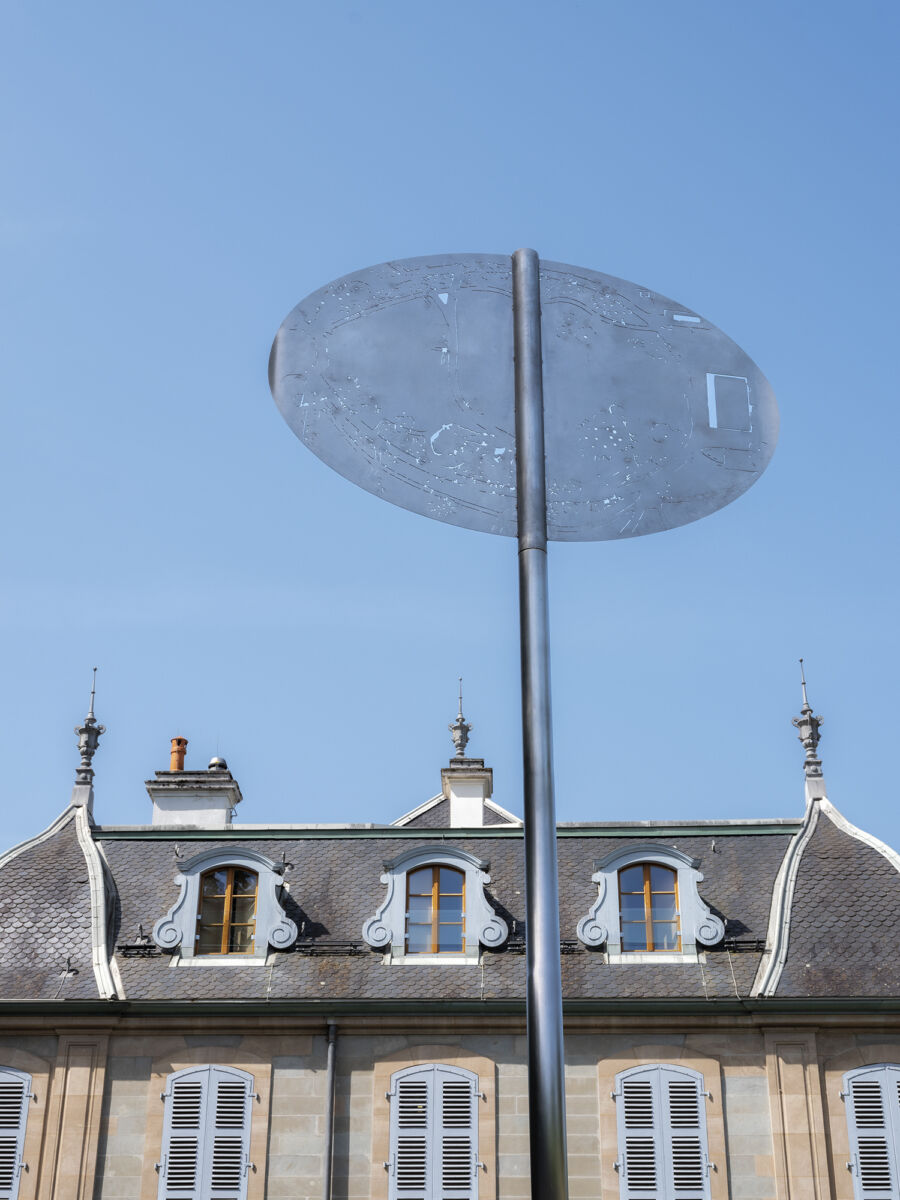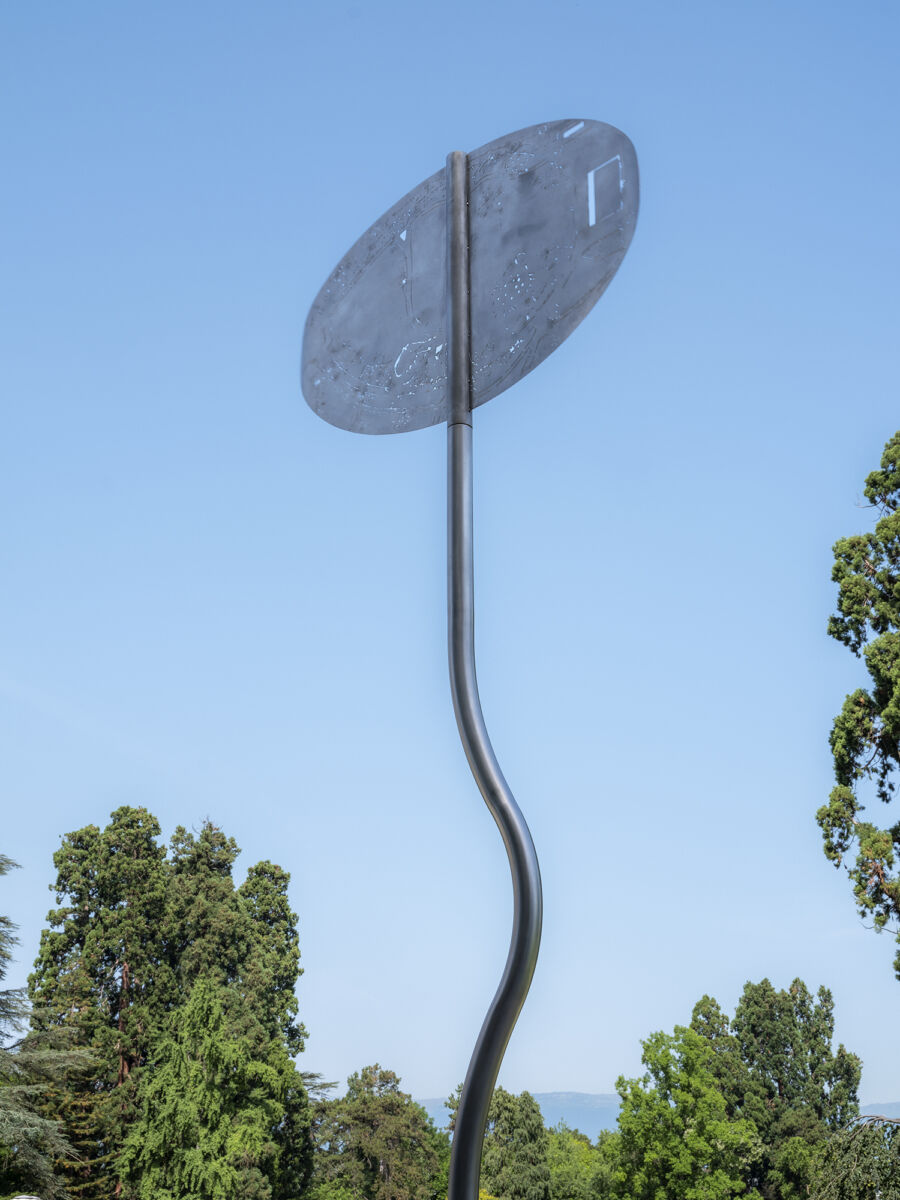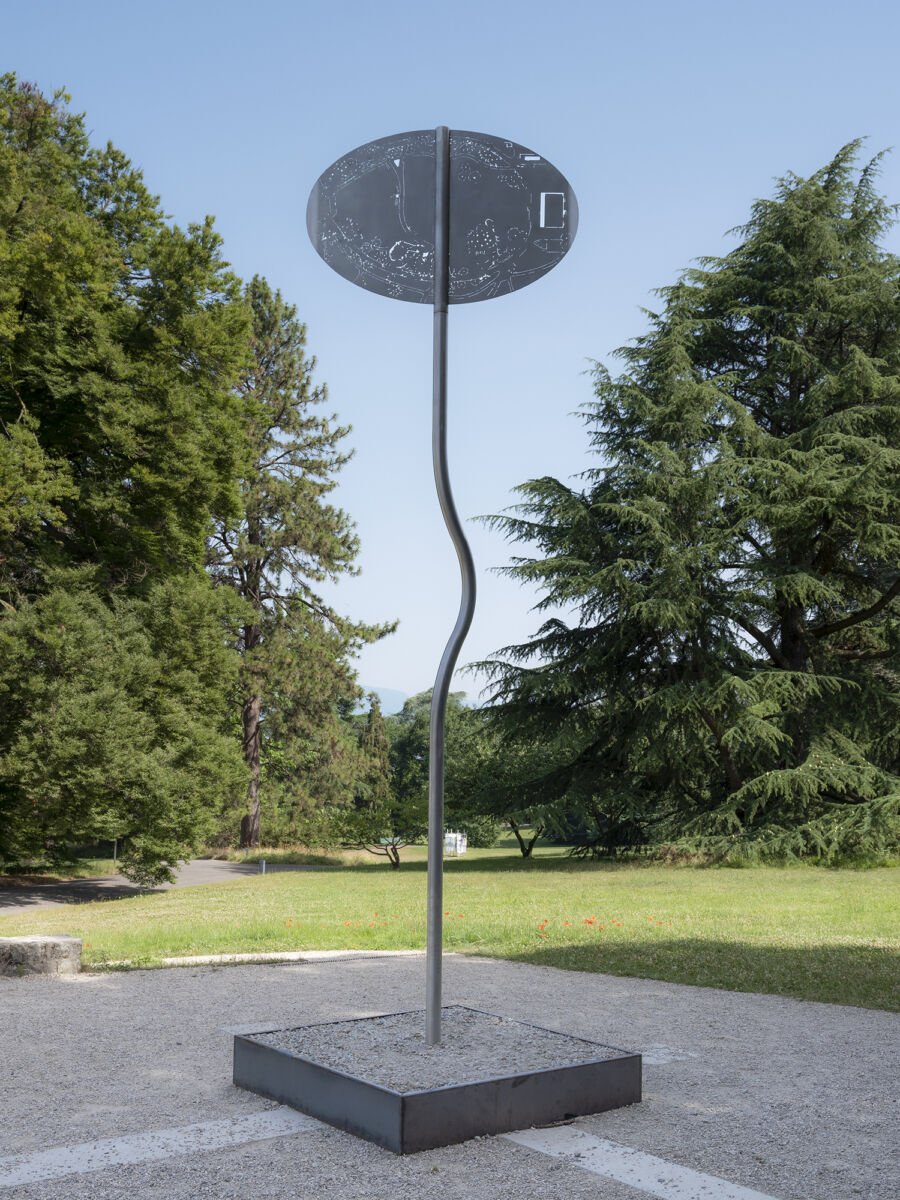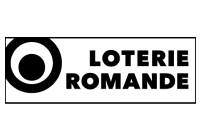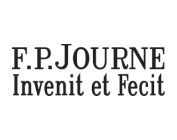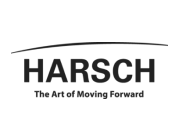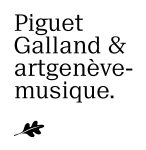Crans-Montana
Edition
About
17 June 2023 – 31 March 2024, Lens & Crans-Montana
The Biennale of Crans-Montana is organized for this edition in collaboration with Sculpture Garden from Geneva. In Geneva, artists and curators invest parks and the lakeside, here the ambition is to play with the very different topographies of the area.
Art is a way to change the perspective that each of us has on our daily lives. Romanticism had imagined that the feeling of vertigo was close to the one that one could experience when traveling in exceptional natural spaces.
With “Behind the Horizon” the audience will experience the connection between the impressive setting of the “Haut-Plateau” and fragments of a dreamy perception of the world. Everything here calls for wonder and surprise. Extraordinary objects unfold in an endless panorama. Several works seem to have a simple destiny, but elements are transformed to extract them from their destiny as objects. Thus, a bench changing dimension becomes an architecture that changes our perception of space. Human silhouettes are twisted under simple lines. Disturbing figures imprint on us a troubled desire. Mobile systems without destination reveal the colors and forces of the surrounding nature.
This course in several different loops also plays of multiple possible strolls. But what will surprise us everywhere as first travelers, is this impression to be here on a promontory, in front of the landscape which opens in front of us and on all sides. For this edition of the Biennale of Crans-Montana, we would like the public to perceive that the artists open ways to project themselves even further than where our gaze goes: Behind the Horizon.


Map of the exhibition
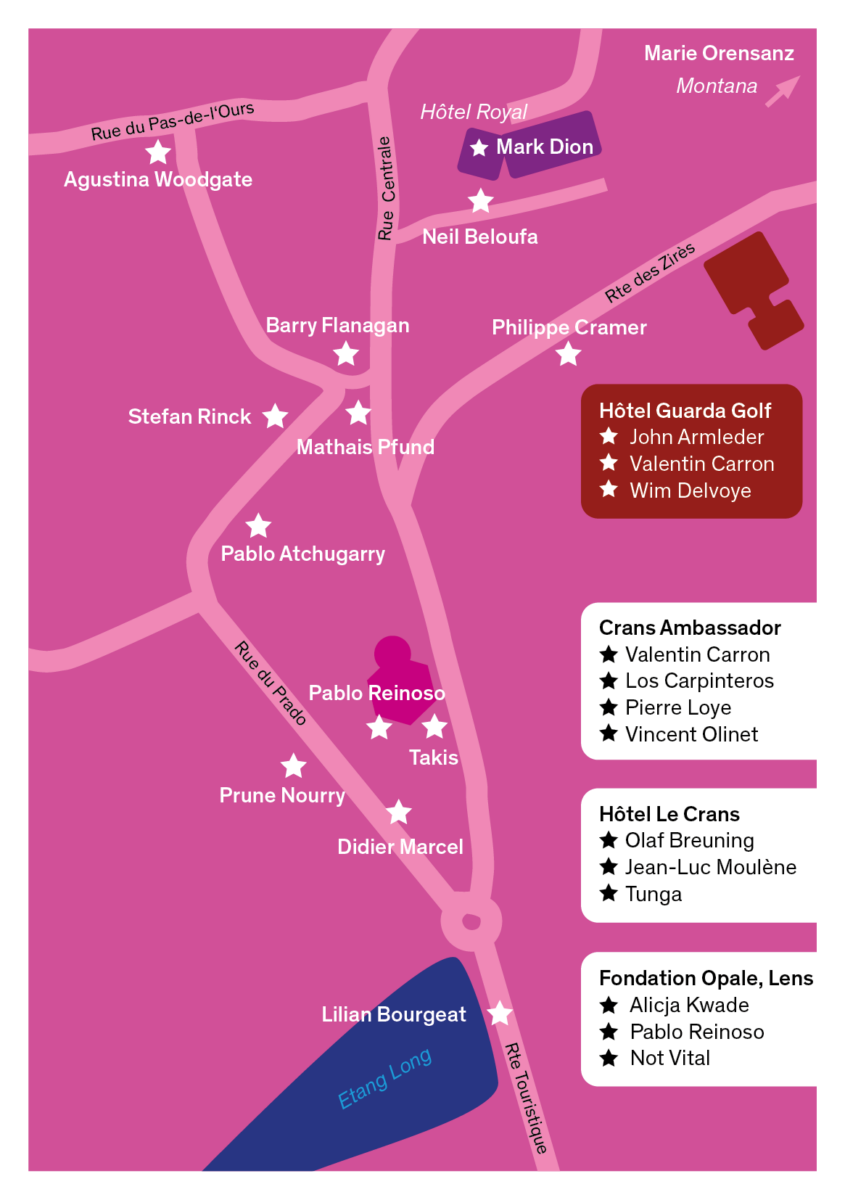


Partners


More to see in Crans-Montana
The Crans-Montana Biennial coincides with the opening of Interstellar, an exhibition organized at the Opale Foundation, in partnership with artgenève.
Among exhibited artists:
Carla Accardi
Giovanna Belossi
Todd Bienvenu
Jean-Marc Bustamante
Hugo Capron
Philippe Decrauzat
Leandro Erlich
Sam Falls
Lucio Fontana
Karen Kilimnik
Alicja Kwade
Jim Lambie
Rafael Lozano-Hemmer
Vera Luther
Jorge Mendes Blake
Michael Mueller
Raymond Pettibon
Tobias Putrih
Stefan Tcherepnin
Blair Thurman
Wolfgang Tillmans
Not Vital
Cerith Wyn Evans
Yarisal & Kublitz


Crans-Montana special edition


New productions
Ana Alenso
(*1982, VE)
Liquid Agreements and Oil Interventions, 2019-2022
Hoses, stainless steel, scaffolding parts, water pumps
Variable dimensions
Ana Alenso’s artistic work explores the world’s dependency in the matter of natural resources, and the resulting political, social and economic exploitation. The artist often examines particular cases such as that of the international oil industry, and the extraction of gold in Latin America, as well as the results of such forms of exploitation in nature and in human beings. The starting point of the off-shore installation shown here is a dystopian vision in which representative elements of the extraction and industrialisation of natural resources are reconfigured in the form of a sculptural installation that aims to acknowledge the anthropocentric and cyclical nature of extractive practices.
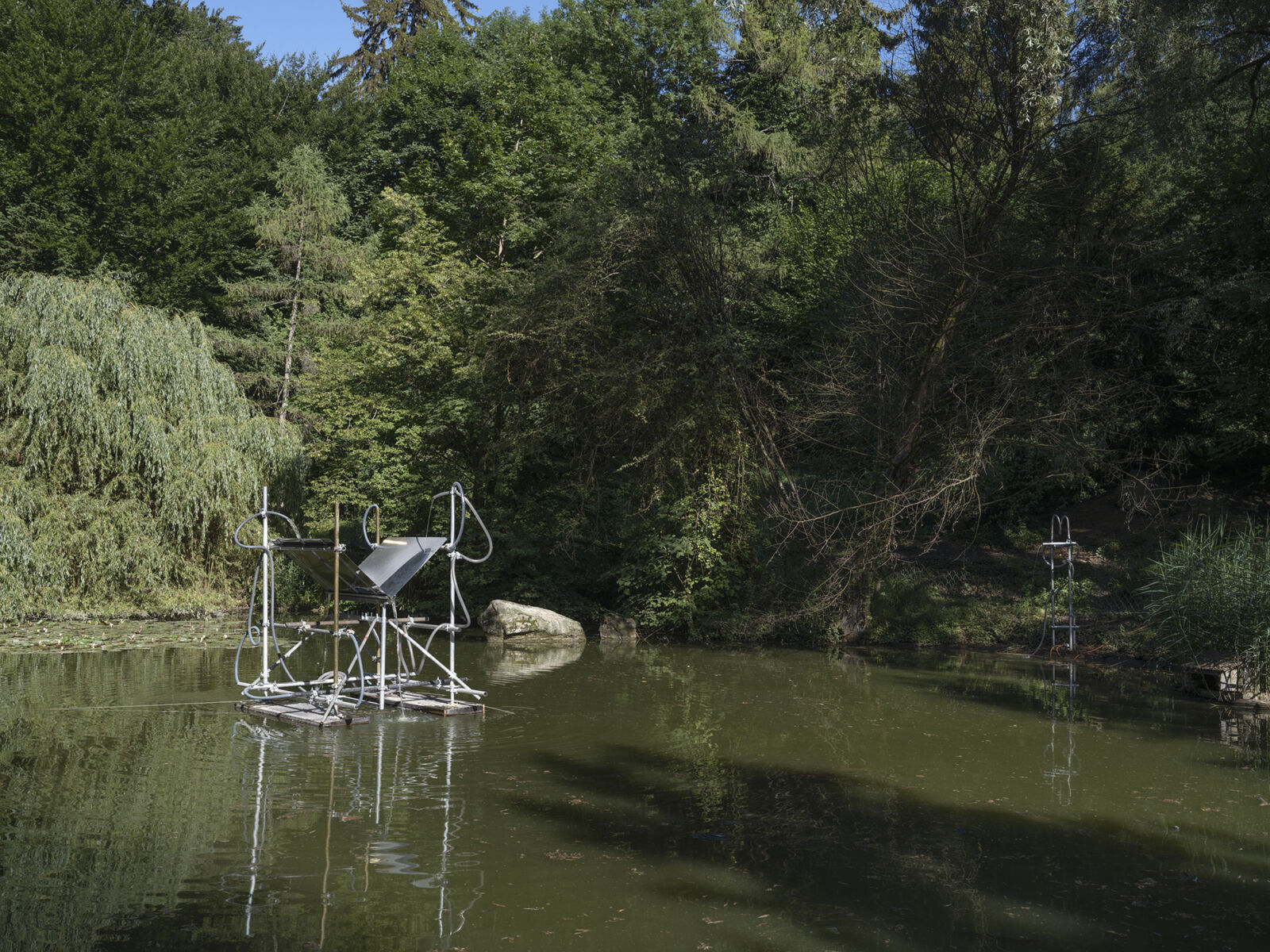
Céline Condorelli
(*1974, FR)
Ouah Wau (to Donna Haraway), 2022
Painted stainless steel
800 × 390 cm
Céline Condorelli has for several years developed a reflection around the notion of support. She is particularly interested in the structures occupying public spaces, structures that make it possible to integrate culture within the everyday, structures supporting the works or the bodies of those who have come to visit them. For Sculpture Garden she has created a structure to support a tree which is collapsing. The graphic forms at the bottom of the sculpture serve as games or exercises for dogs which are able to run freely in that part of the park. Ouah Wau (to Donna Haraway) thereby creates a link between trees and animals as “companion species”, to borrow Donna Haraway’s terminology. Under a playful appearance, Céline Condorelli questions the hierarchy established between different species, revaluing their fundamental interdependence.
With the support of Galeria Vera Cortês
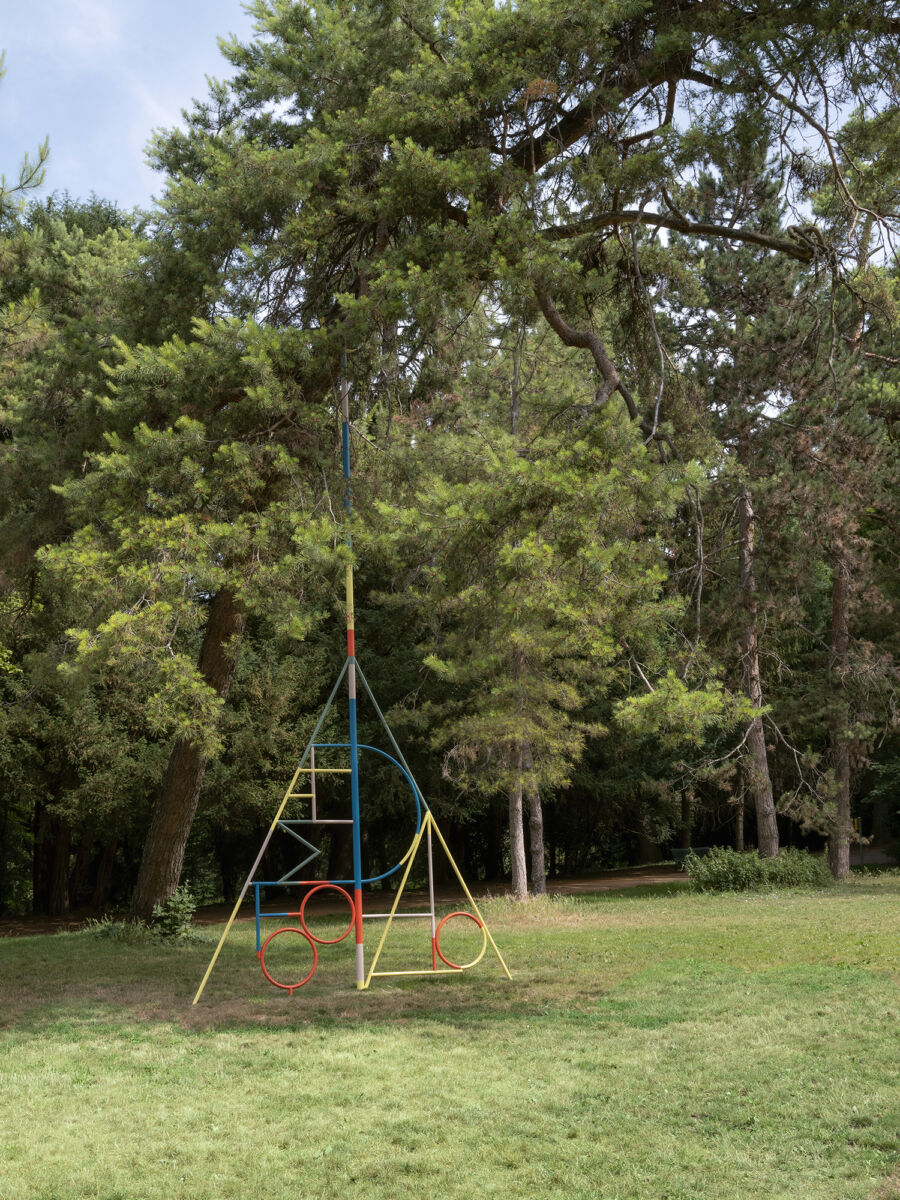
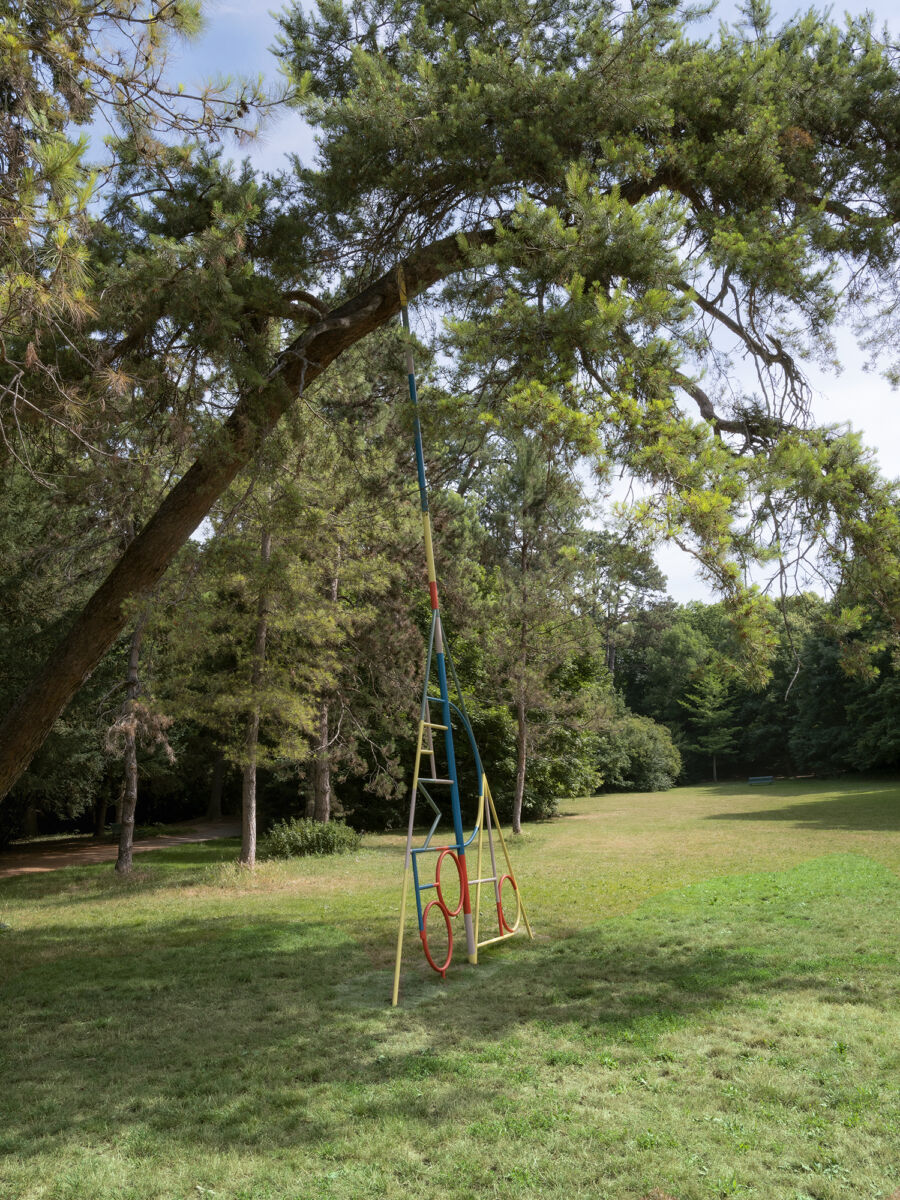
Zuzanna Czebatul
(*1986, PL)
Macromolecule Exploiting Some Biological Target, 2022
PVC
300 × 300 × 150 cm
Zuzanna Czebatul draws inspiration from the links between pop culture, individual freedom and social ideologies. The artist has designed a gigantic ecstasy tablet, with the words “Rush” and “Revolution” embossed on each side. This hyperrealist sculpture, filled with air, functions as a humorous monument to rave culture, in particular that of the 1980’s and 1990’s. Carried by a generation that had already become used, through the pharmaceutical industry, to so-called “lifestyle” drugs, ecstasy, a synthetically produced empathogen drug, became particularly popular at the time. The euphoria which unites ravers on the dance floor is the expression of their anti-conformist way of life and of clubs as places of lived social utopia.
With the support of Sans titre (2016)
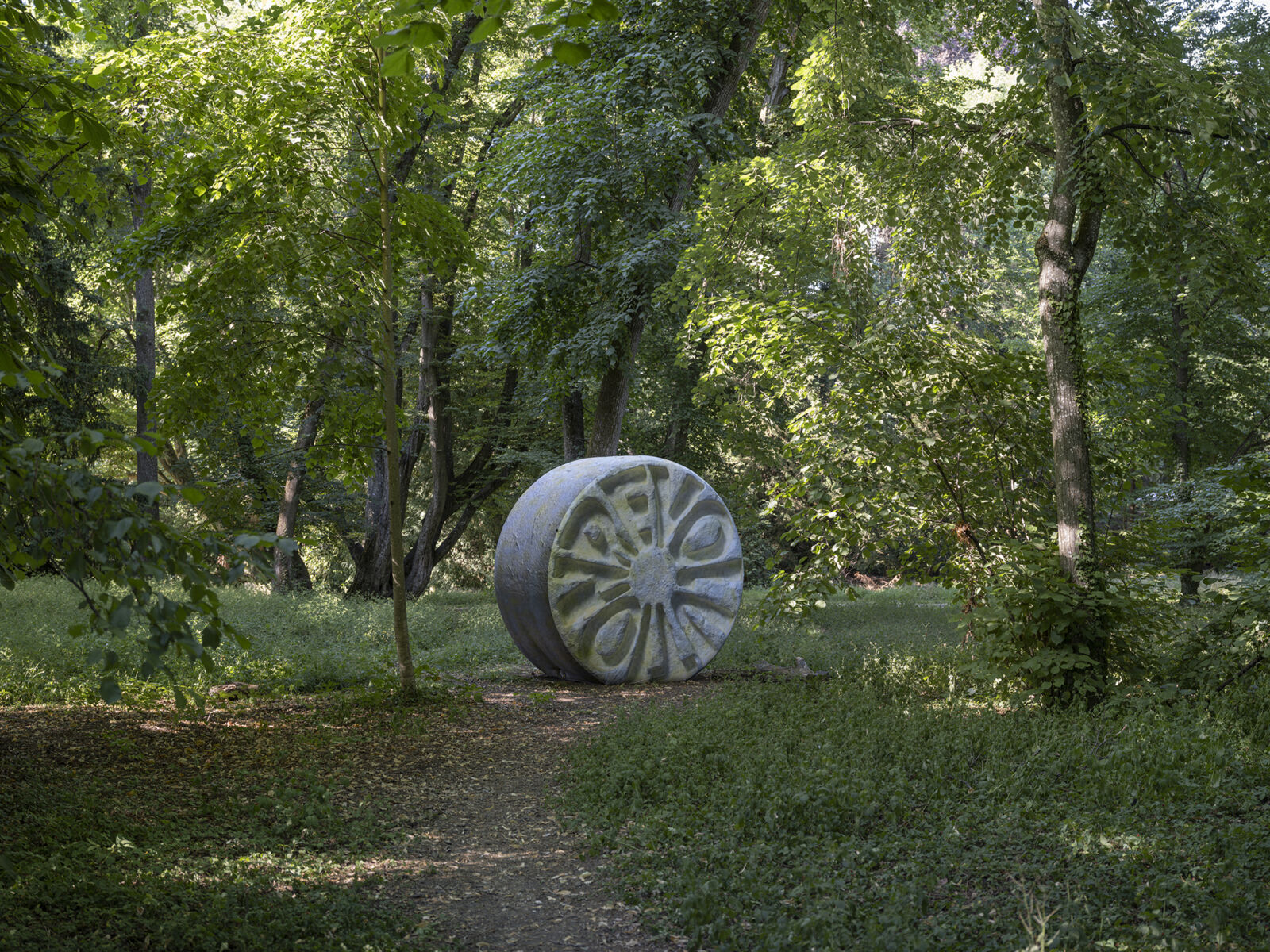
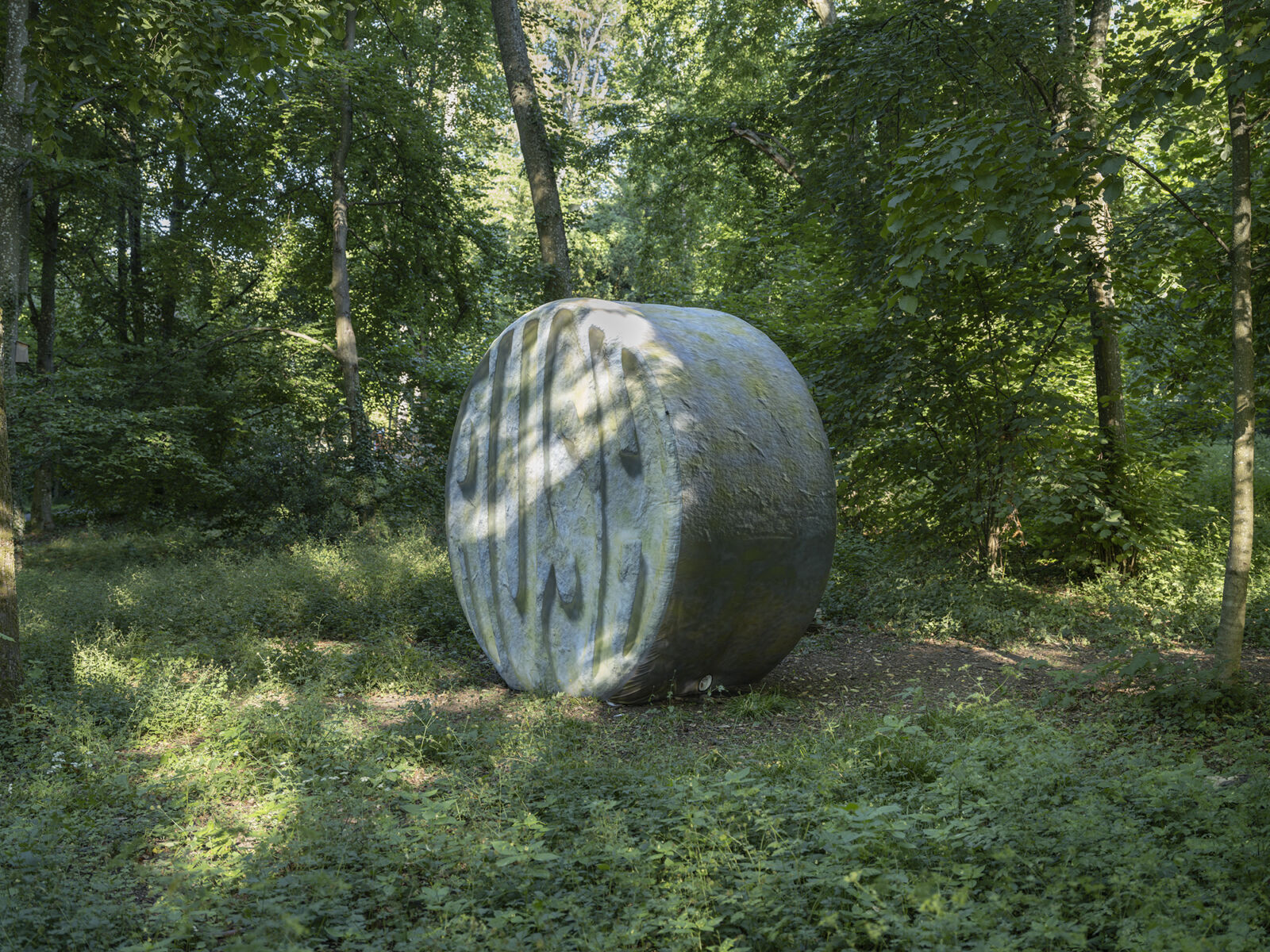
Liz Deschenes
(*1966, US)
Blue Wool Scale, 2022
UV prints, stainless steel
496 × 153 × 25 cm
Over the last 20 years, Liz Deschenes has created hybrid photography works, exploring the relationship between the material processes through which images are produced, the ways in which seeing is situated, the history of the medium, and exhibition structures of presentation as a critical counterpoint to a world awash in media. For Sculpture Garden, the artist presents a monumental “scale” of blue colors which come from Art Conservation, where they are used as light fastness standards, to monitor the net exposure to light of art objects on display, and to alert conservators to rotate an exhibit or to reduce the intensity of illumination. One would not find these cards made for conservation in a sculpture garden as they are made for indoor display and are also hidden from the viewer thus weathering the elements. The prints in Blue Wool Scale employ a UV photographic print technology that’s own lightfastness is still being determined. These prints are here “tested” by the wind, sun and rain, in an extreme re-interpretation from their initial function.
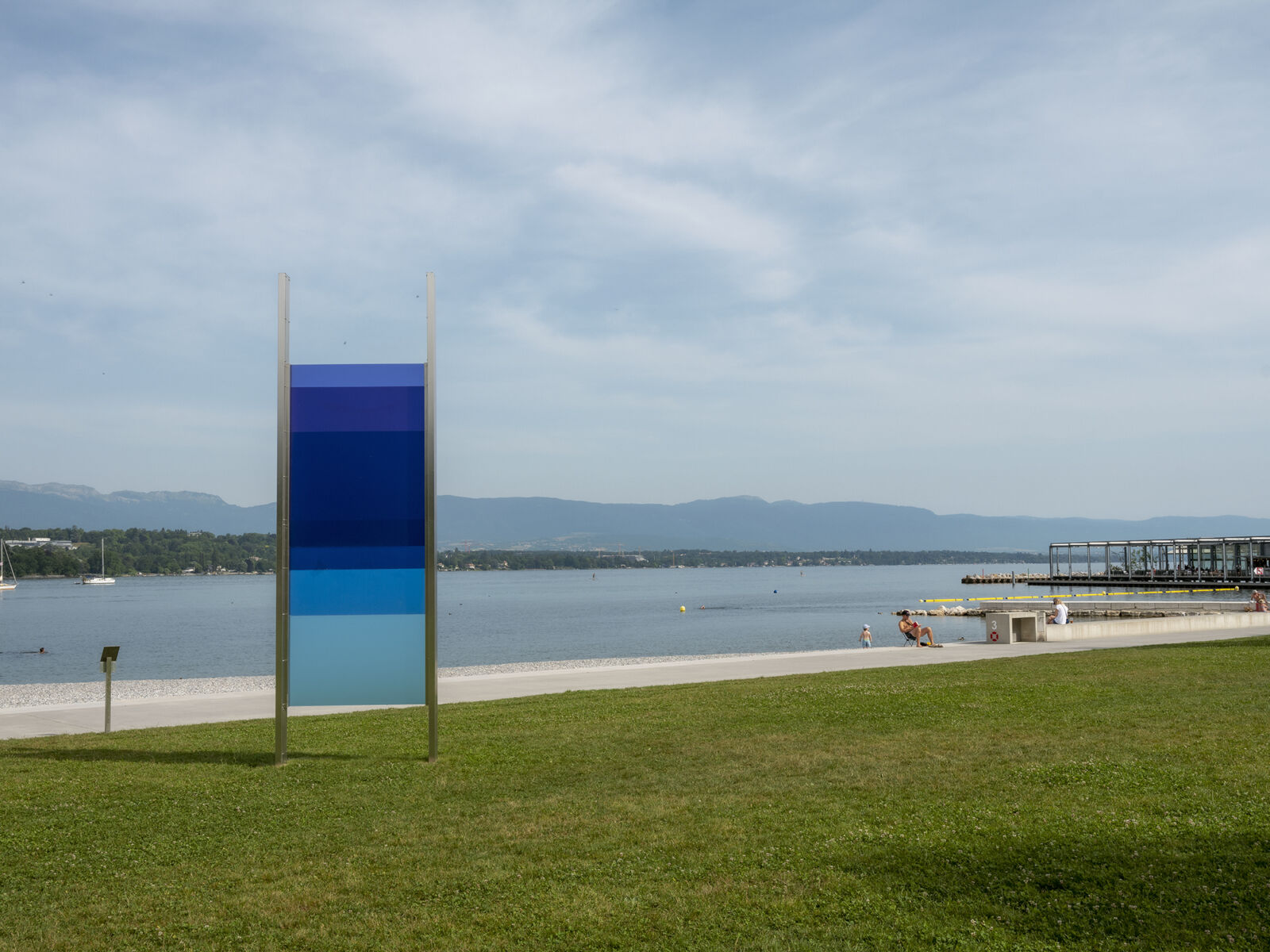
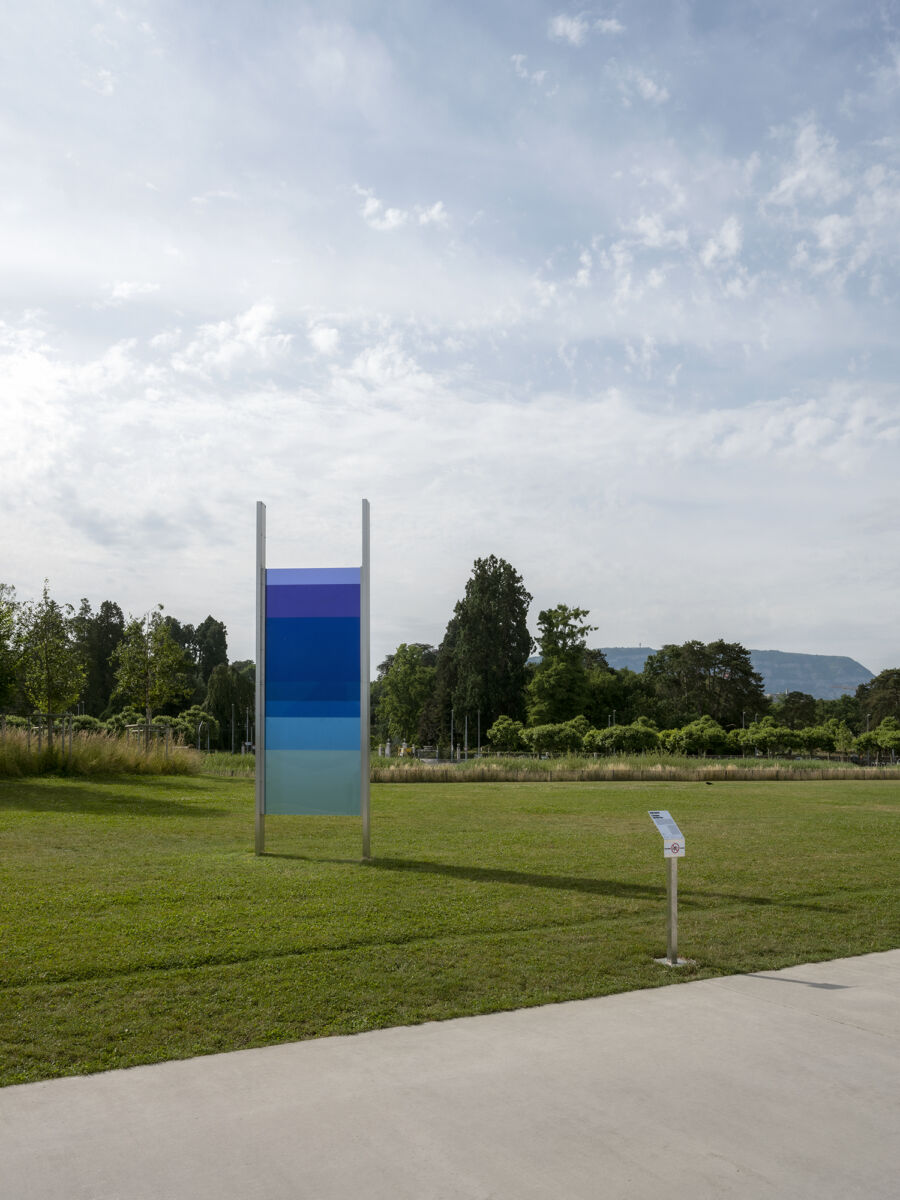
Koenraad Dedobbeleer
(*1975, BE)
All Music Is There For Bastardisation
Wrought iron, brass and paint
220 × 110 × 5 cm
Koenraad Dedobbeleer explores sculpture, design, architecture and display devices, by examining the way in which value is attributed to materials and practices. For Sculpture Garden, the artist has replaced a service door linking (or separating) the Park La Grange to (from) that of des Eaux-Vives, through a new custom-built gate in which the ampersand symbol is used as the central motif. This both functional and ornamental element slots into the very architecture of the exhibition space, the codes of which the artist disrupts.
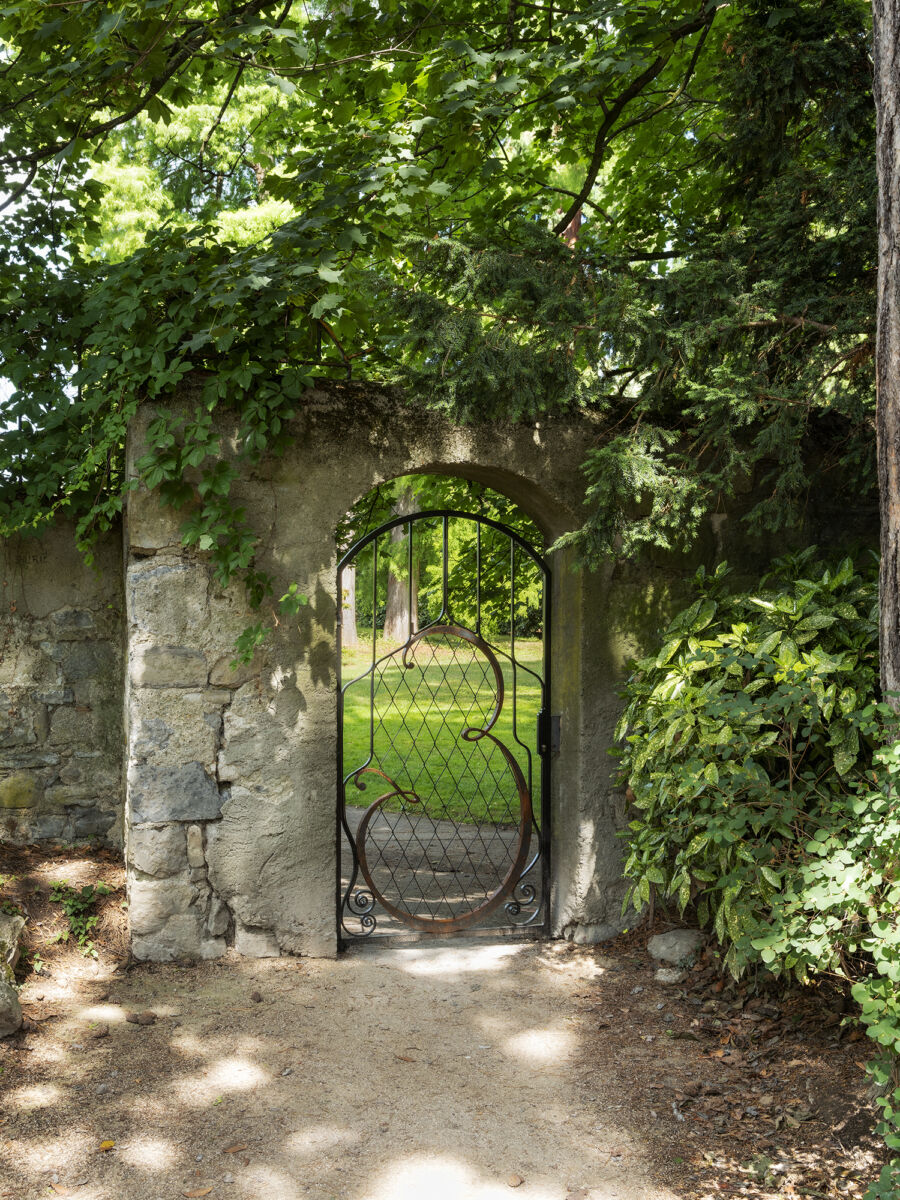
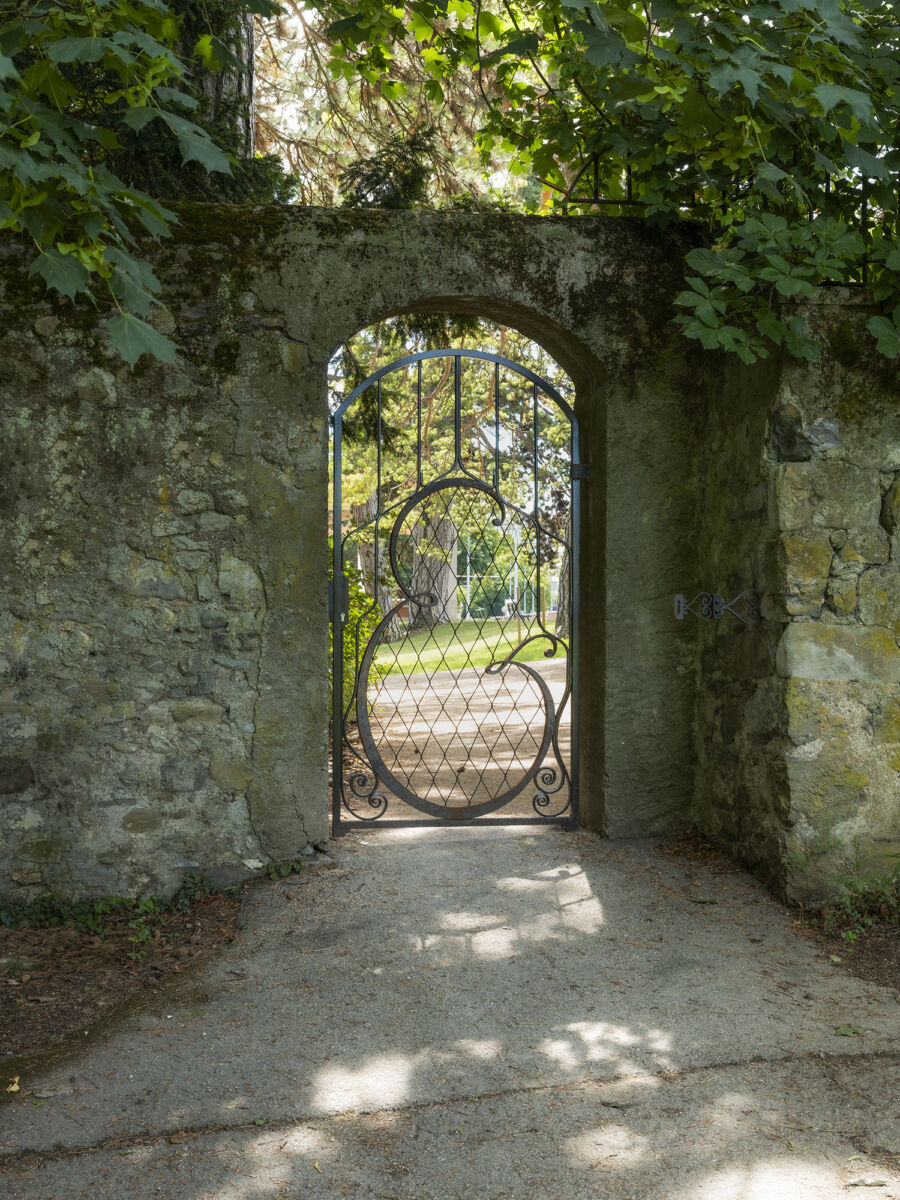
David Douard
(*1983, FR)
Melody (SG), 2022
Screen-printing, aluminium, metal, perspex, glass, bronze, paint
340 × 250 × 200 cm
Drawing inspiration from street furniture and collective spaces such as bus shelters in which people gather for a short while, David Douard has created a hybrid structure which eschews functionality. Whereas the glass and metal structure points to a certain rigidity, or even to the authority that governs public space, the images and texts found on Internet that are screen printed generate a sense of intimacy and introspection which unsettles the system. The environment appears to be contaminated by fantasies and digital technologies. The thistle motif, recurrent in the artist’s work and embodying opposites–both flower and weed, both decorative and injurious–recalls above all the force of resilience of nature but also that of alternative communities. At night the work is lit like a night light, heart-warming for nocturnal strollers.
With the support of Commune de Plan-les-Ouates
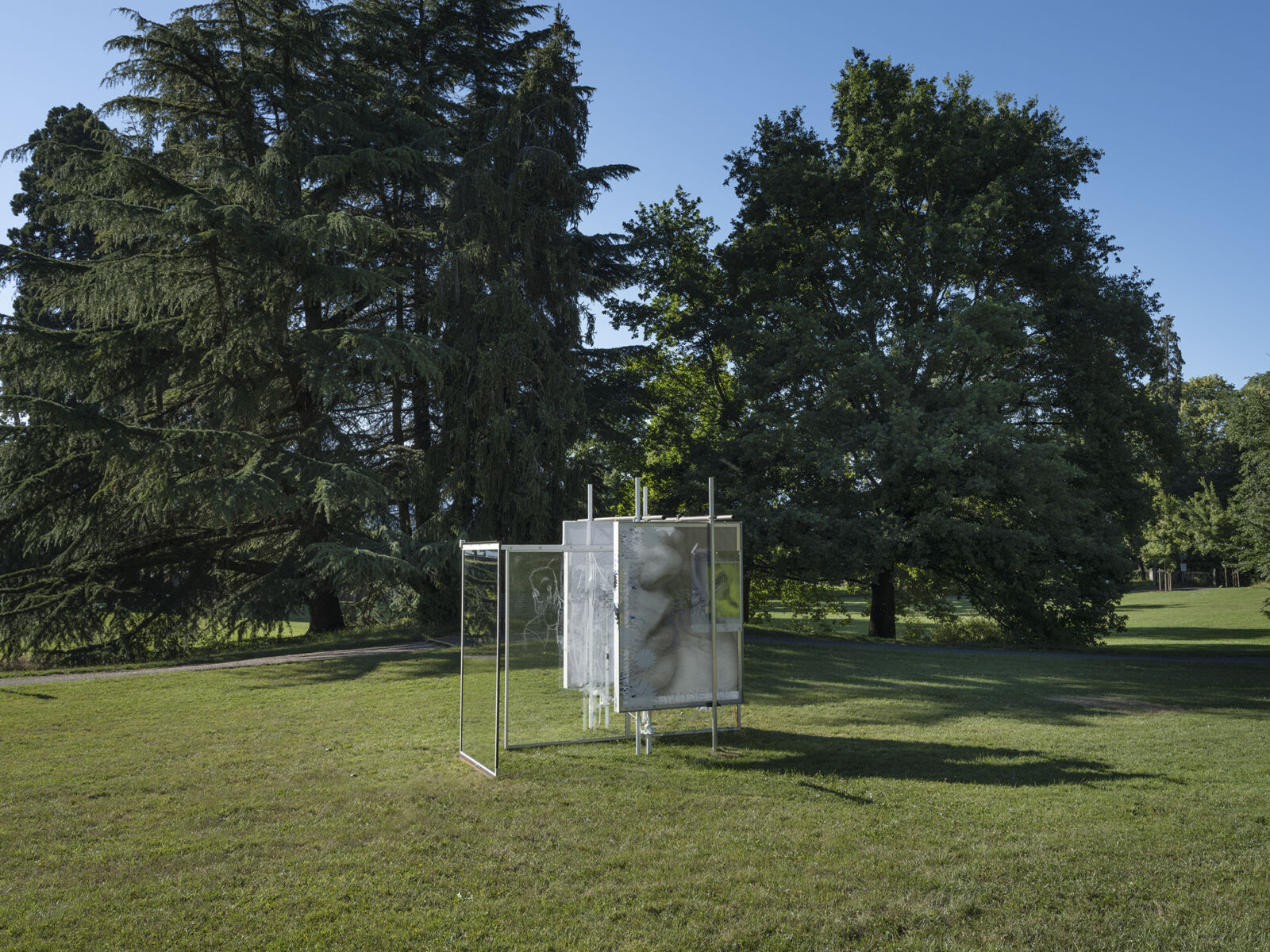
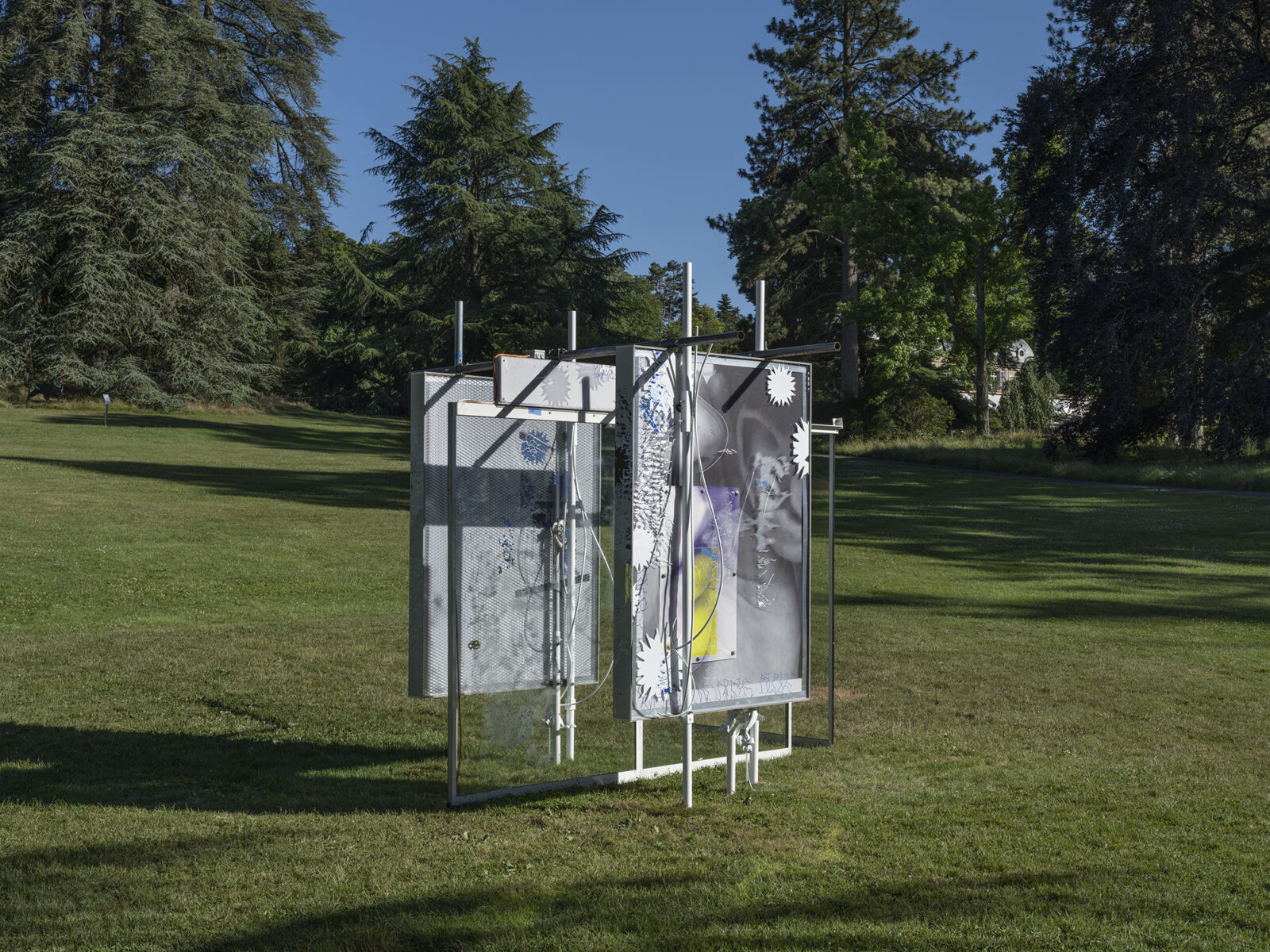
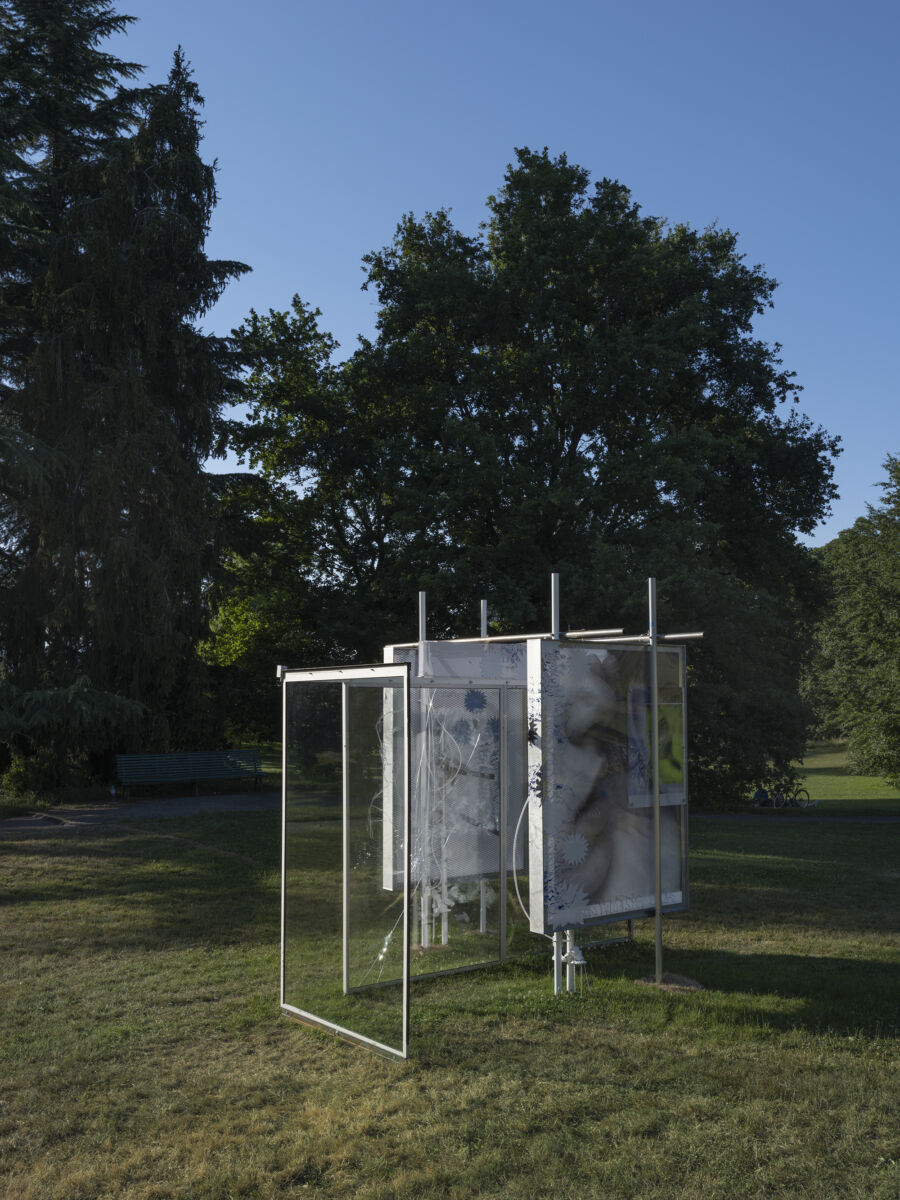
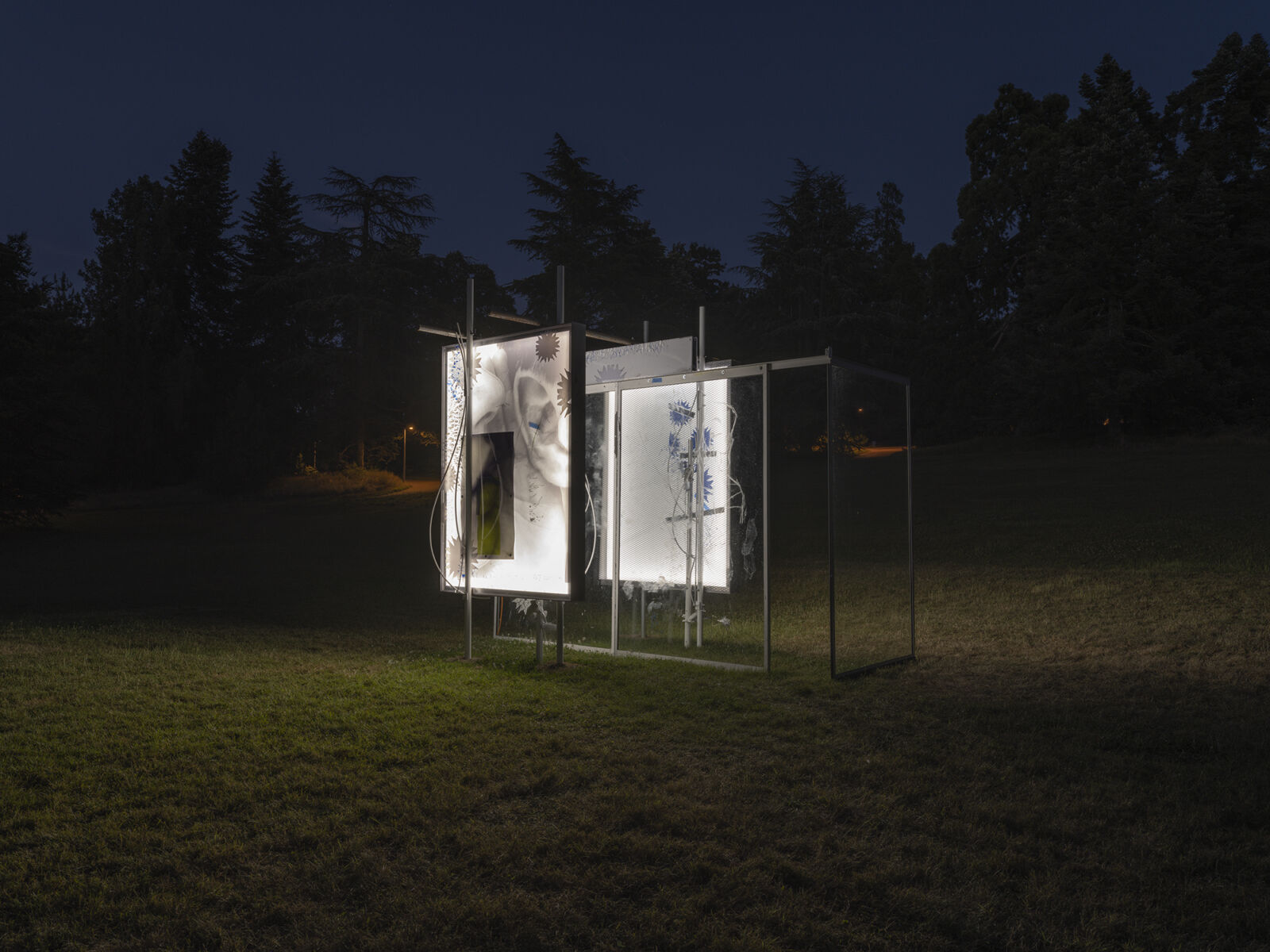
Jos de Gruyter & Harald Thys
(*1965 & 1966, BE)
A.M.M.S.A.303, 2022
Powder coated steel and flashing lights
314 × 80 × 85cm each
Jos de Gruyter and Harald Thys have worked together since the 1980’s and have produced videos, photographs, sculptures and drawings that are always steeped in a powerful tragic-comic sensibility. Their universe is inhabited with outsiders, socially disabled and psychotic characters. For Sculpture Garden, the duo propose a new monumental sculpture based on their “White Elements”, monolithic characters who disrupt heroic-realist monuments and whose faces here adopt the logo of the crypto-money Ethereum. The bright white strobe lights mounted on top of their heads are manufactured by Boeing and indicate their existence and exact position in the park. Depending on the weather A.M.M.S.A.303 should be visible from the other side of lake Geneva.
With the support of Galerie DuflonRacz
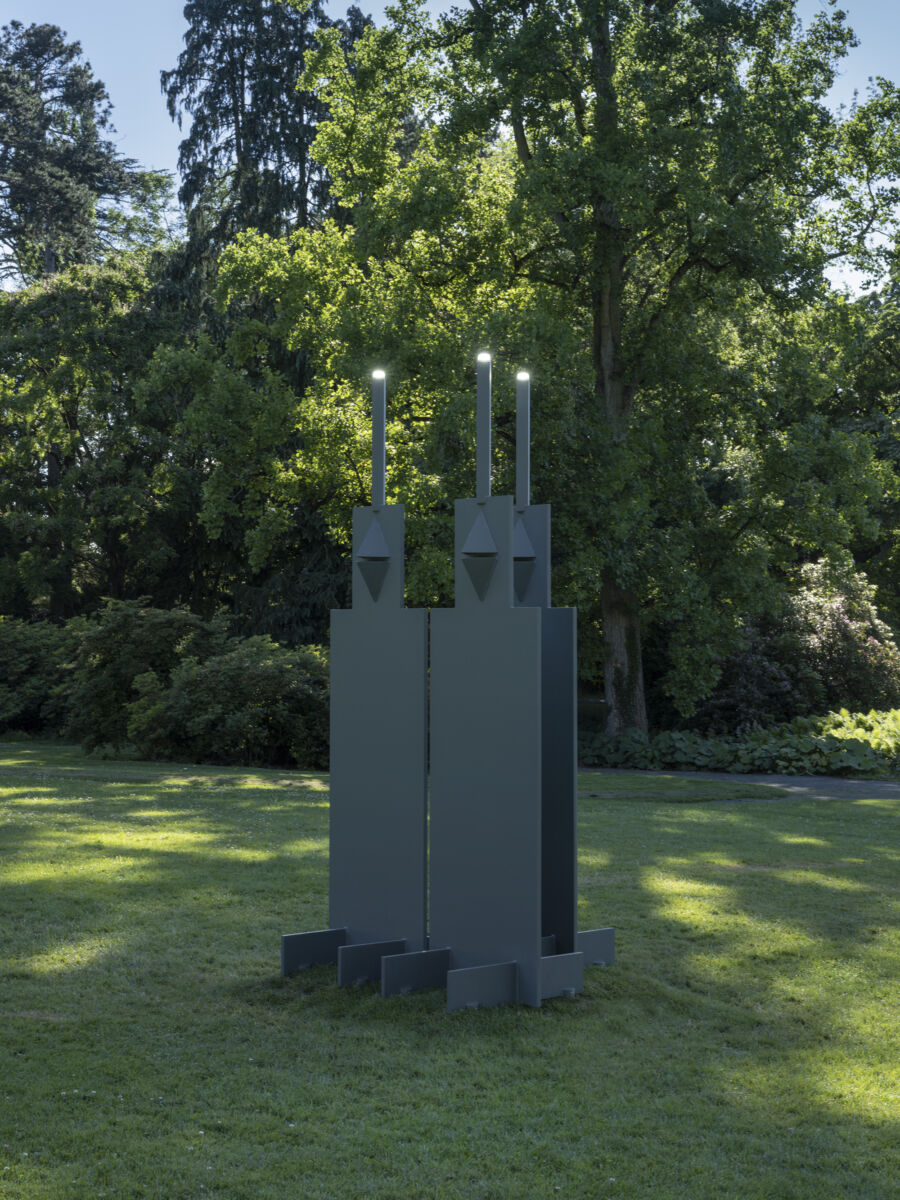
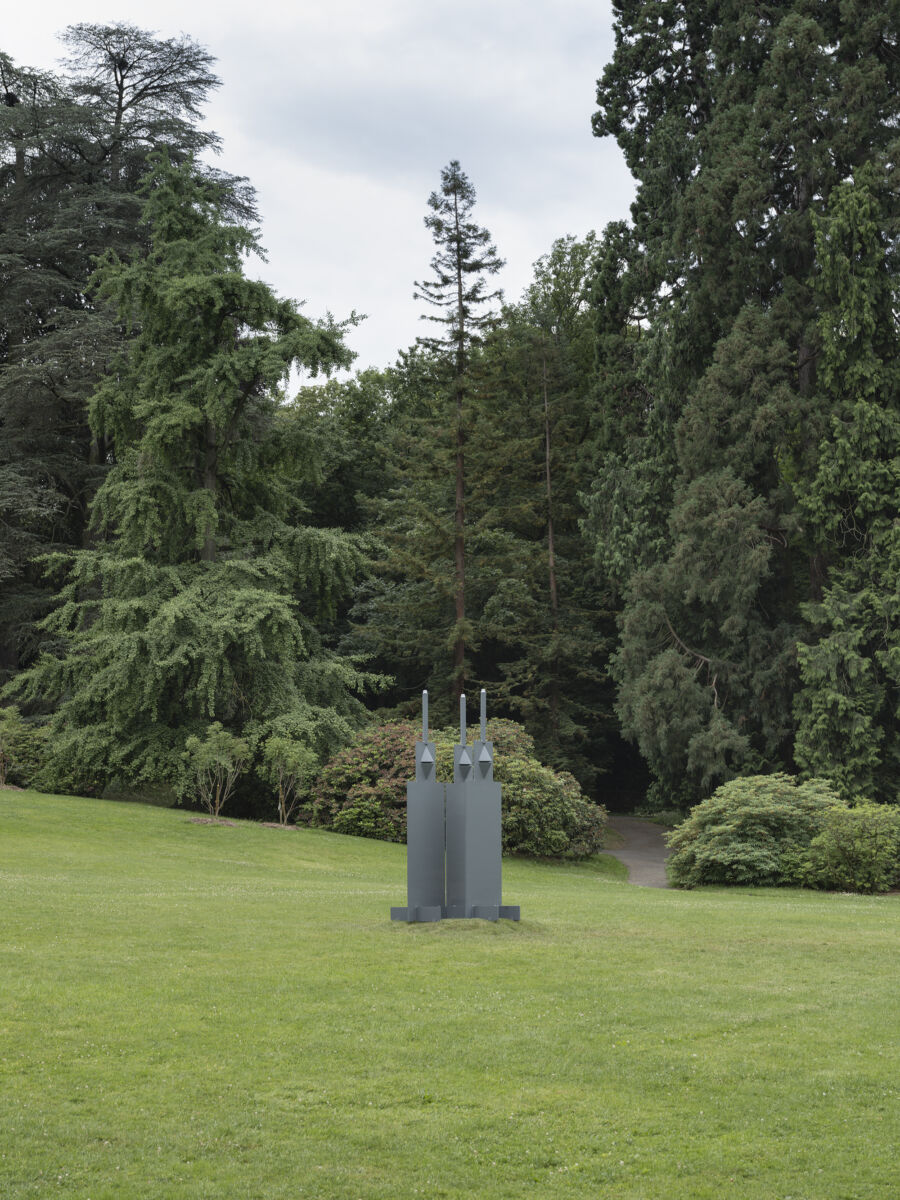
Daniel Lie
(*1988, BR/ID)
Them, 2022
Natural rope, ceramics, cotton fabric, turmeric
Variable dimensions
In Daniel Lie’s artistic practice, time and eco-systems play a key role. The artist creates installations in which organic living elements transform themselves, thereby performing their own temporality and their own intentions. For Sculpture Garden, Lie has created an in situ installation hanging from monumental sequoias. The artist approaches those other-than-human beings, aged over two centuries, with respect and draws inspiration from their semi-circular arrangement, creating a form of sanctuary in which visitors are invited to stay for a while. As its title Them indicates, the artist’s free-floating installation disrupts the structures of binary thinking, such as past and present, human and non-human, exhibition and introspection.
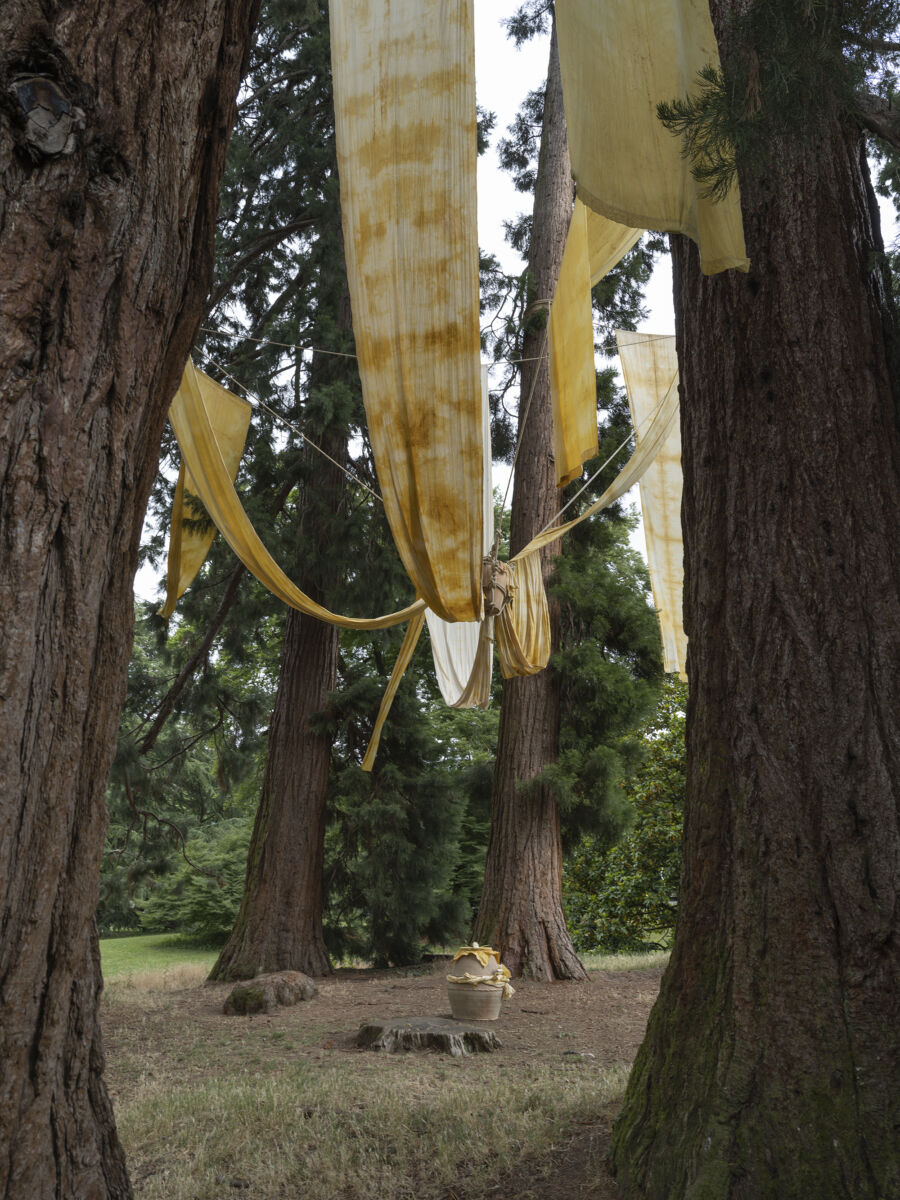
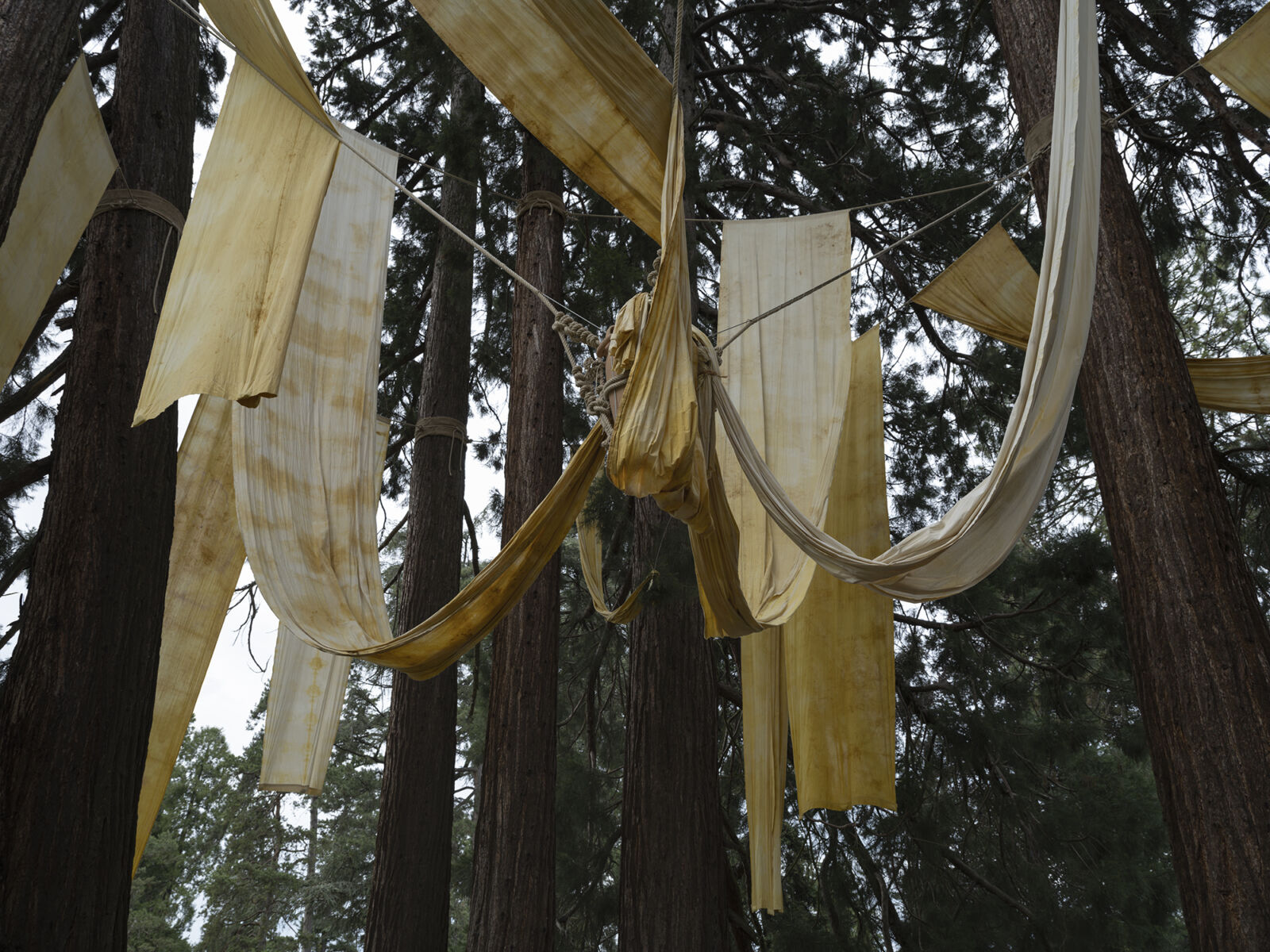
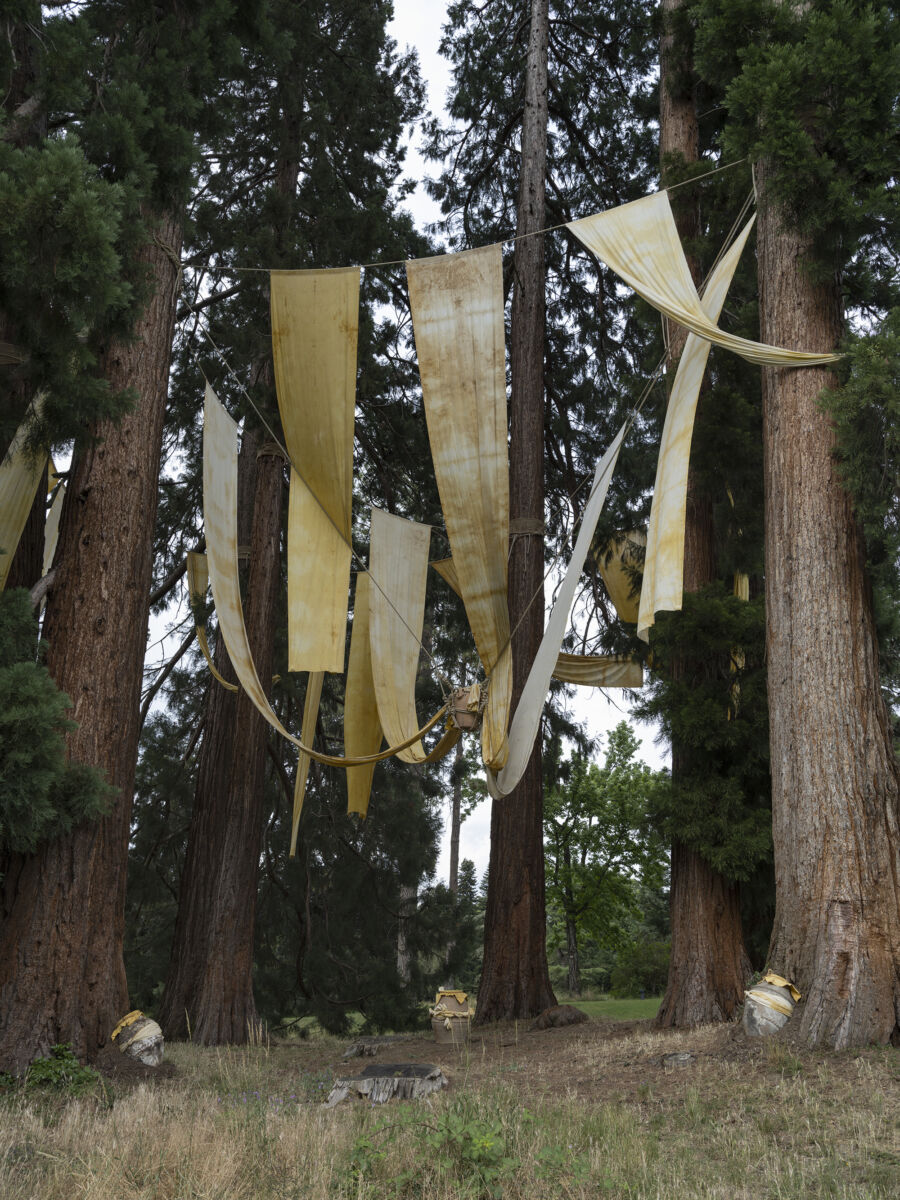
Lucy McKenzie
(*1977, UK)
Anonymous Statue, 2022
Bronze on stone pedestal
Bronze : 180 × 80 × 50 cm
Plinth : 120 × 80 × 120 cm
Bronze cast by Kunstgieterij Van Geert, Aalst
Pedestal by Natuursteen, Aalst
Anonymous Statue examines the connection between public statues and their working cousins, the commercially manufactured mannequins used in the world of retail. Both are shaped by the conditions of their age, one by being embedded in the historic practice of commemorating figures for posterity, the other through the operations of hyper-capitalism as it responds to the ever-changing demands of the fashion industry. Both are devices to elevate, embody and bestow prestige, and both claim a false neutrality. The first popular mannequins were fragile, made of wax or plaster, but now their fibreglass limbs create landfill. The prototype of Anonymous Statue was bought from a discount warehouse for second-hand mannequins. It is now rendered even more indestructible by being cast in bronze, and it is placed on a high stone pedestal in a secluded part of the Parc des Eaux-Vives. Even as a statue she is still an empty vessel, waiting for meaning to be imposed on her.
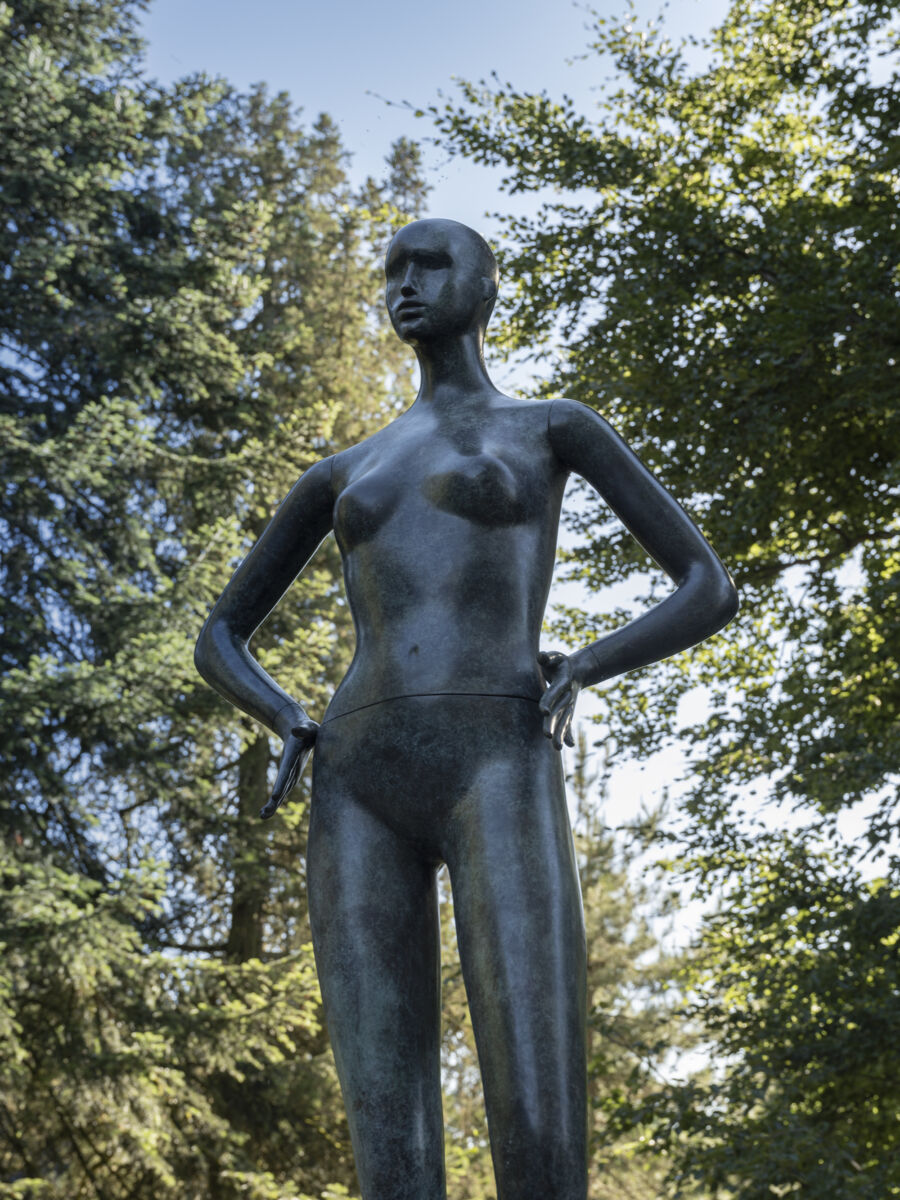
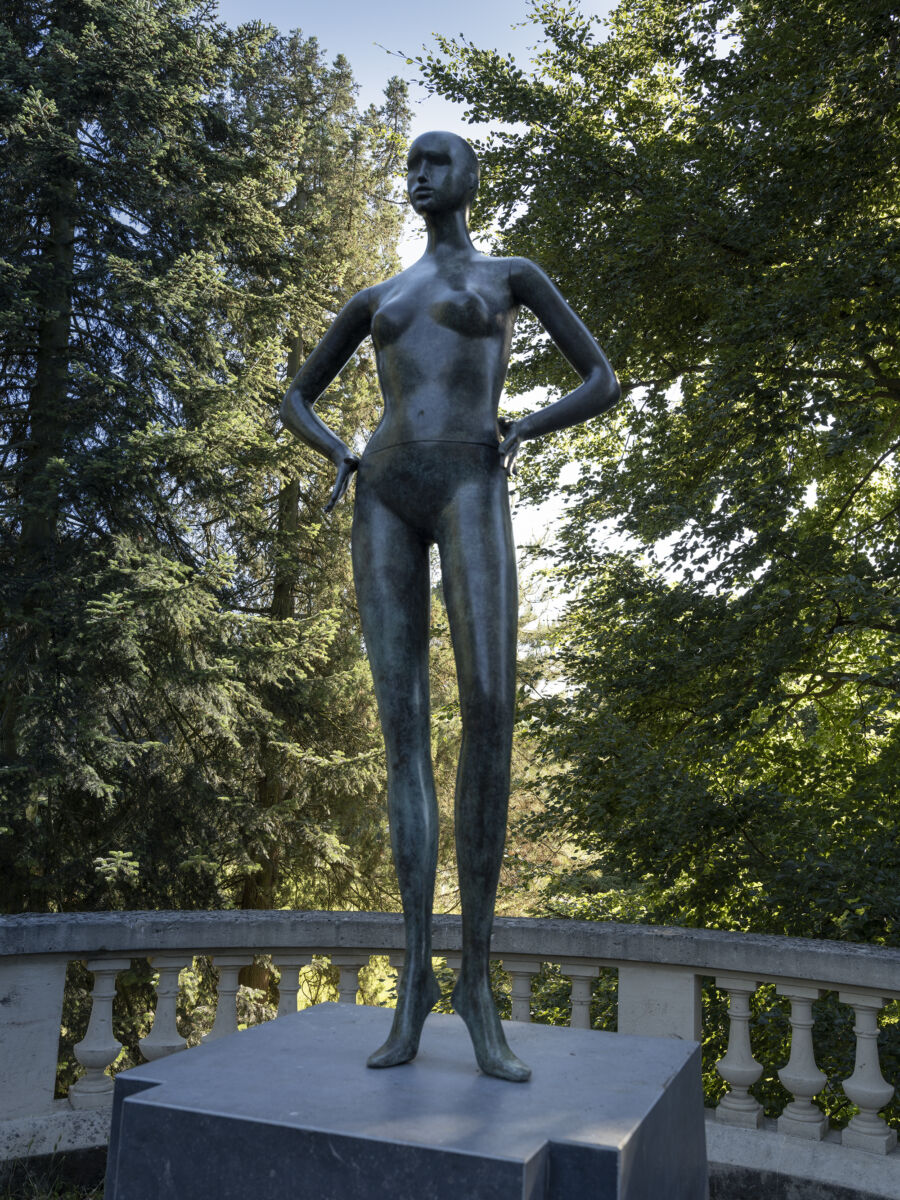
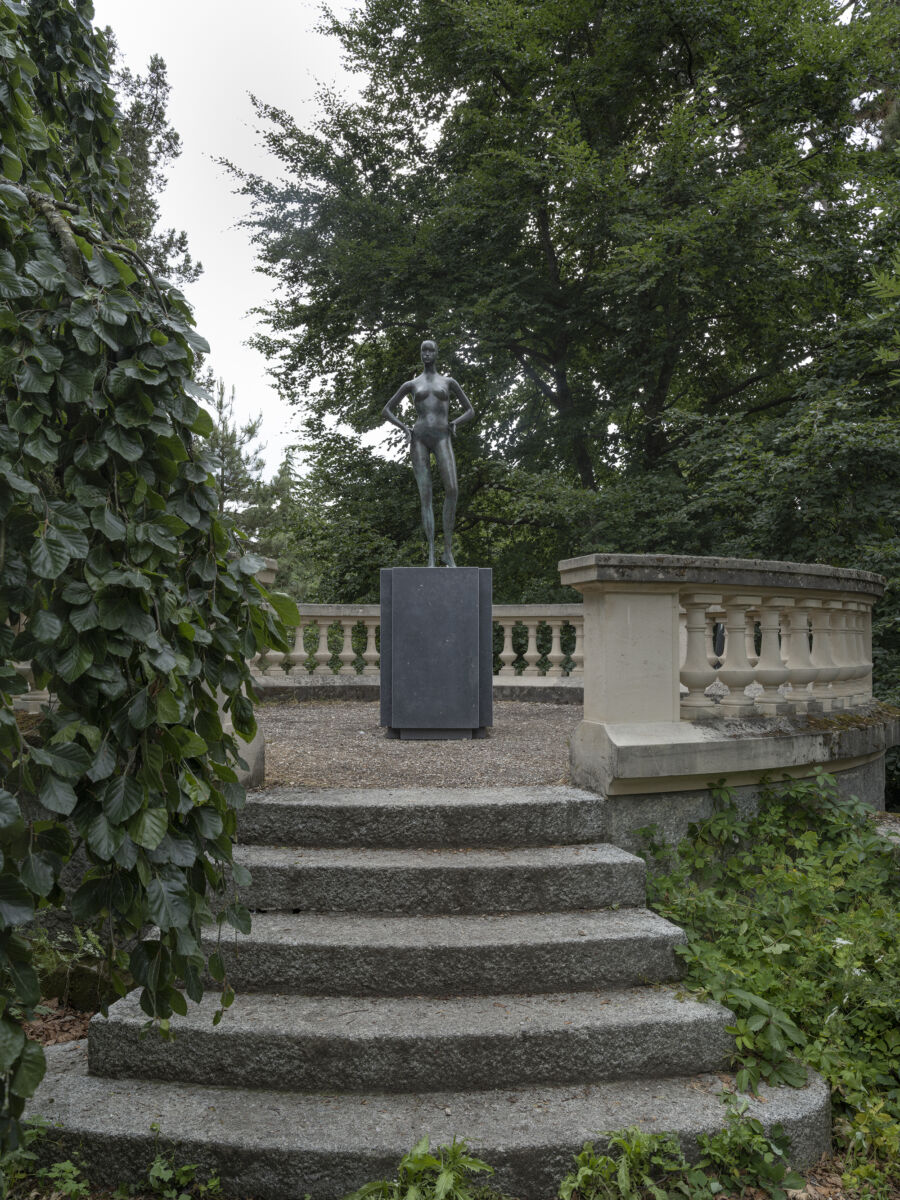
Willem Oorebeek
(*1953, NL)
Getting The Books Out, 2022
Digital print on forex, aluminum
180 × 140 cm each
Working mainly with printing techniques and the appropriation of existing images and texts, Willem Oorebeek questions representation and the functioning of perception in the age of image overload and spectacle. The installation entitled Getting The Books Out consists of four enlarged books in human size. Three of the four are based on existing publications by the artist, while the last is a project in progress. In line with the idea of “social sculpture”, Willem Oorebeek’s four monumental books redefine space as a discursive place.
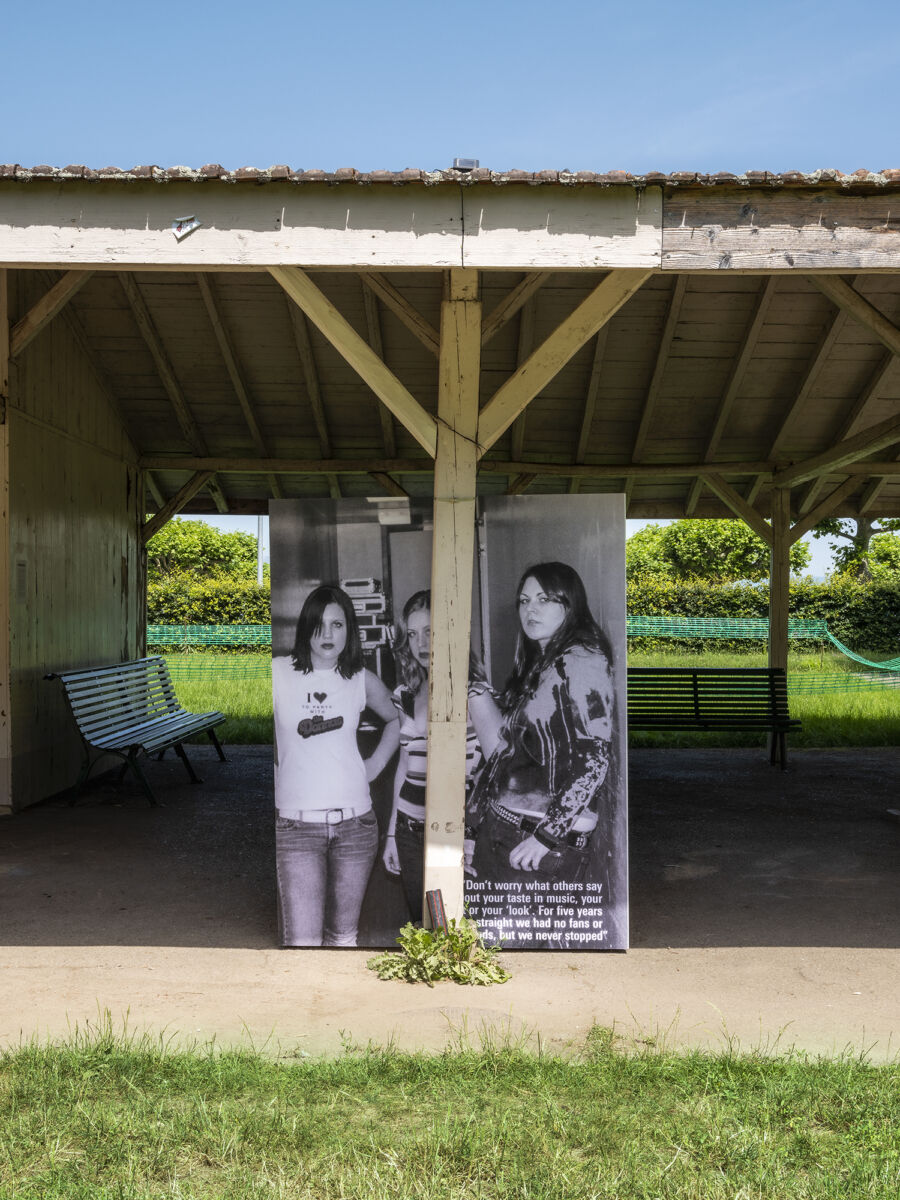
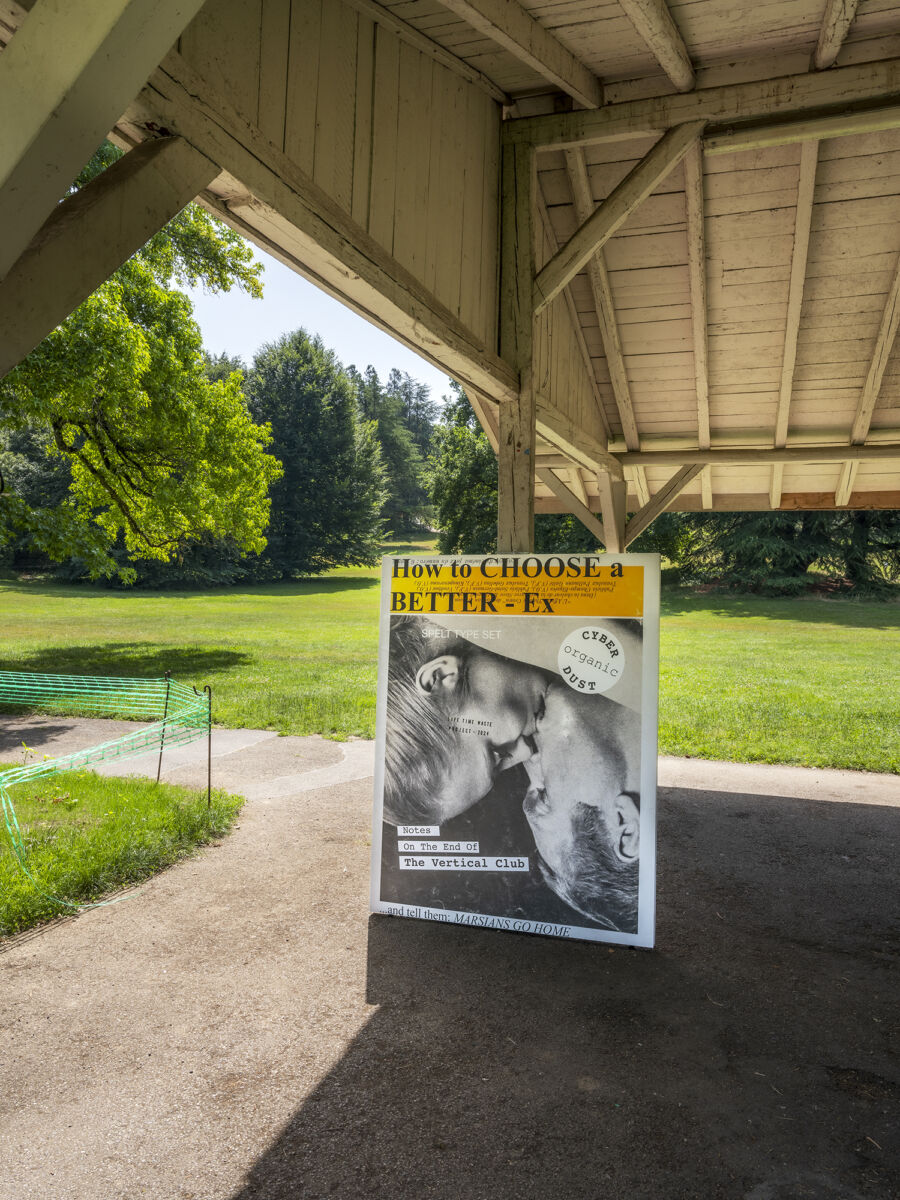
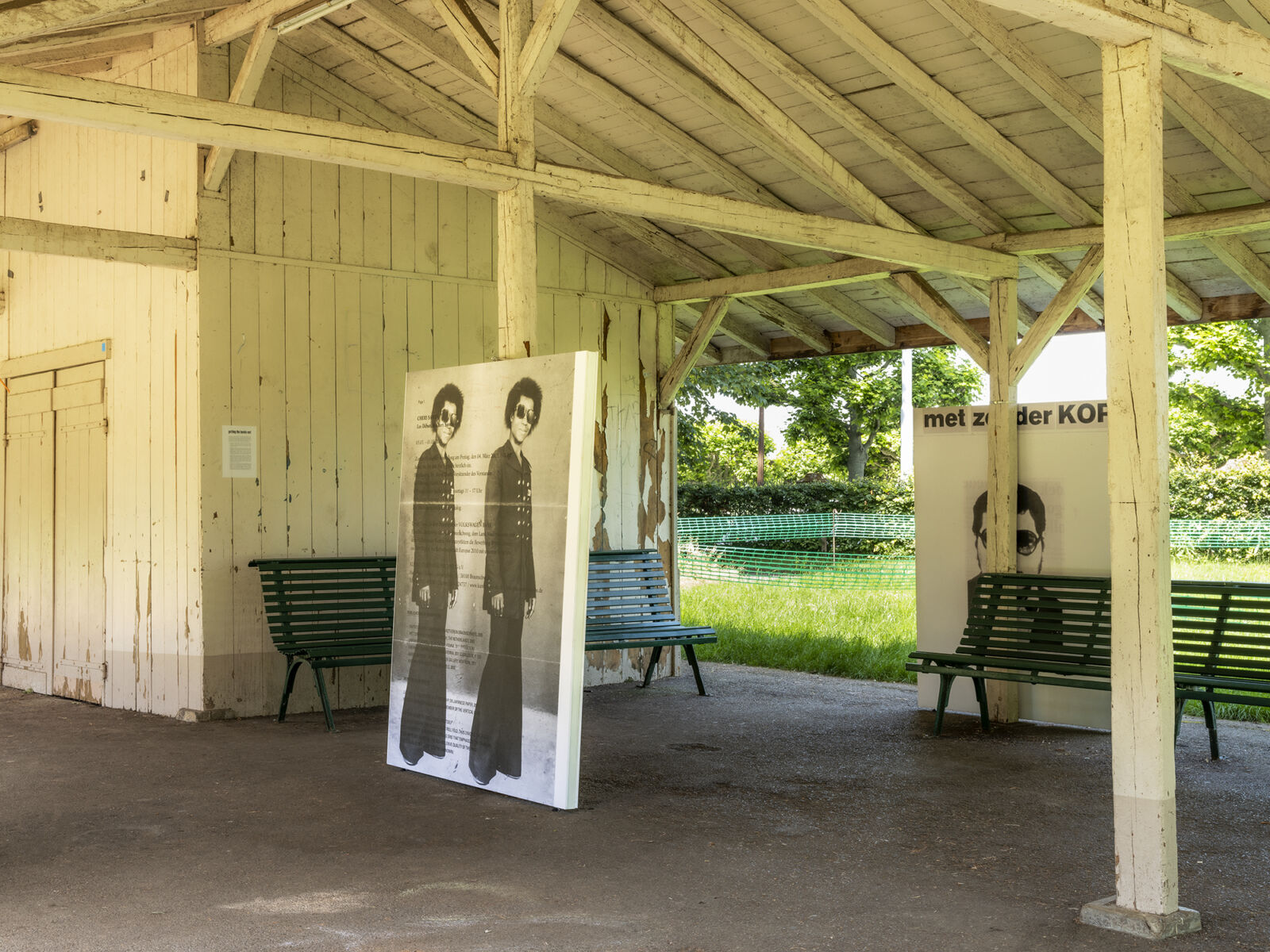
Ceylan Öztrük
(*1984, TR)
Ripple Effect; Nazar Module, 2021-2022
Stainless steel
Variable dimensions
Ceylan Öztrük investigates the normative aspects of knowledge production. Through her multi-disciplinary artistic work, she creates a narrative with the specific information that transforms knowledge into tools of power. For Sculpture Garden, she presents an installation composed of mirrors cut out in the form of undulations that float in the basins of the rose garden of Parc La Grange. In sociology the so-called “ripple effect” can be observed when social interactions affect situations not directly related to the initial interaction. In Ripple Effect; Nazar Module, Ceylan Öztrük embodies and reifies the ripple effect image as a sculpture expanding across the water.
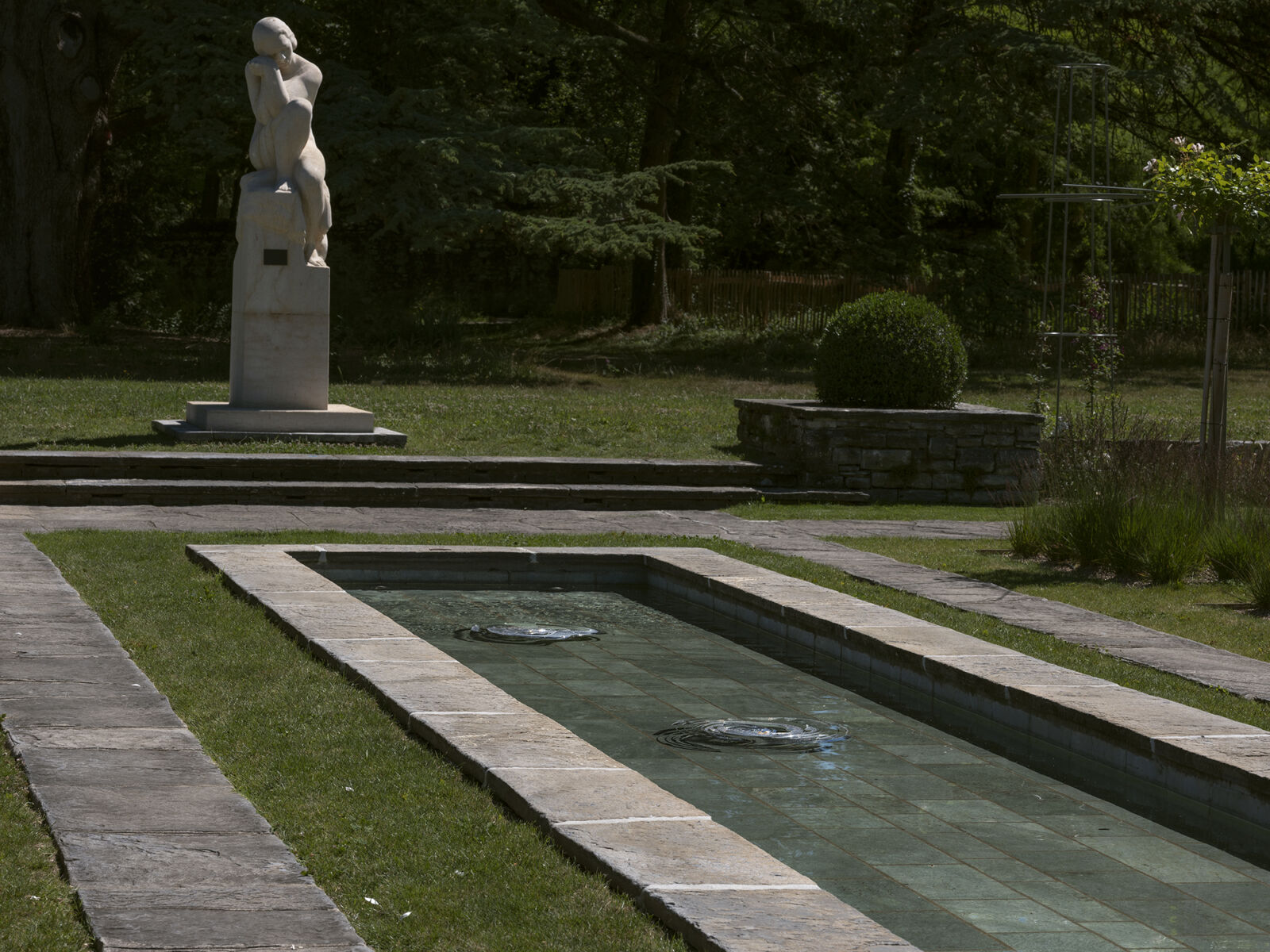
Mathias Pfund
(*1992, CH)
Cæsarina, 2022
Steel, silver, bronze, powder coating, concrete pedestal
156 × 90 × 50 cm
Mathias Pfund’s artistic practice involves composing fictions and it resorts to various strategies of appropriation. Through reproduction, he is chiefly interested in the representation of art and in the various values and ideologies underpinning it. Cæsarina is a throne dedicated to “César”, his grand-mother of Italian origin, who has been a neighbour of Villa la Grange for over 50 years. This is a curule chair hybridised with a laurel wreath, carrying with it different symbolic implications: that of (patriarchal) power in ancient Rome, that of the victorious Imperator in later Rome, or that of poets in Greece. In addition, the seat is decorated by three medals, each exploring in indexical mode narratives linked to a specious European antiquity. This work, a parody of an authoritarian language, nevertheless remains an element of street furniture, on which anyone is free to sit. For more information, an extended caption is available at 57 route de Frontenex.
Produced with the help of Robin Gabriel (Serruriers Noirs), David Chojnacki (SwissArt Edition Genève), Hugo Milan, Marc Calame (form|c)
With the support of FCAC Genève
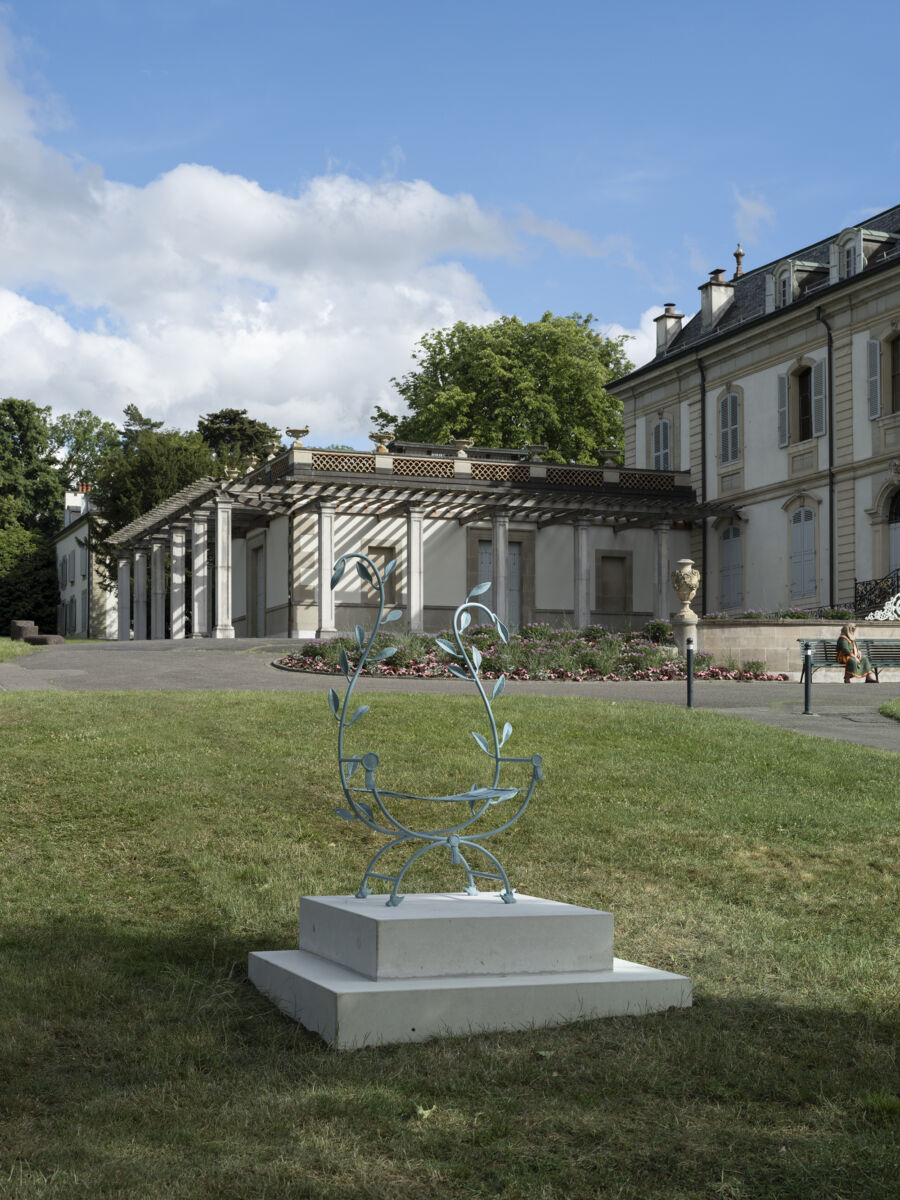
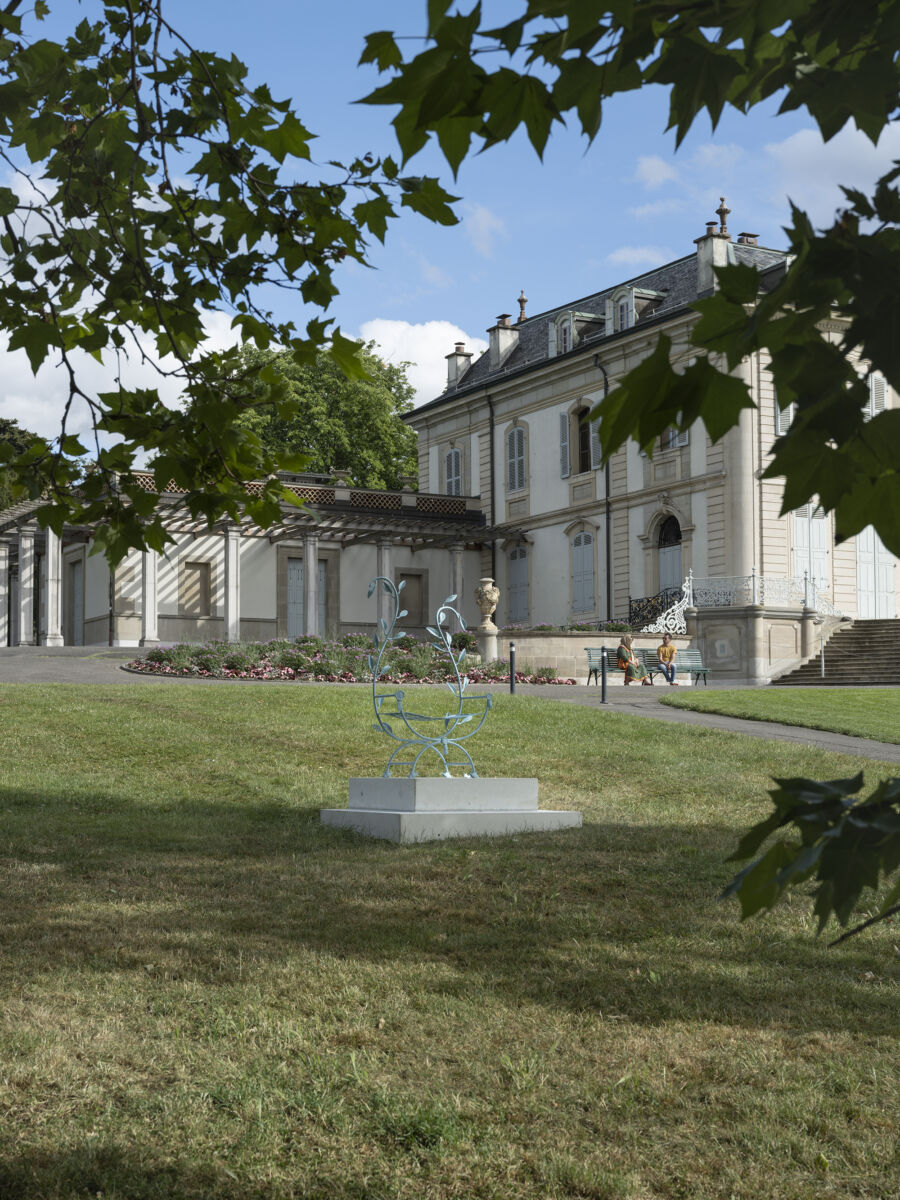
Existing works
Douglas Abdell
(*1947, US)
Kraeff-Aekyad, 1981
Welded steel painted black
360 × 172 × 50 cm
Born in Boston to an Italian mother and a Lebanese father, Douglas Abdell produces works marked by writing and graphic signs. His work explores the deep connection between words, images, sound and form. The artist believes that this link was particularly close and significant in the languages spoken in his home in the countries of origin of his family: Italian and Arabic and later his learning of Phoenician. These archaeological and linguistic investigations led Abdell to develop his concept of “Aekyad”: a series of combinatorial and rhizomic forms that the artist casts in bronze patinated in black and welded steel painted black. At the crossroads of minimalism and neo-expressionism, these sculptures will notably find an echo on the New York art scene in the 1970s, during the prosperous period which saw the emergence of street art, block parties and of the hip hop scene.
In collaboration with MAMCO Genève
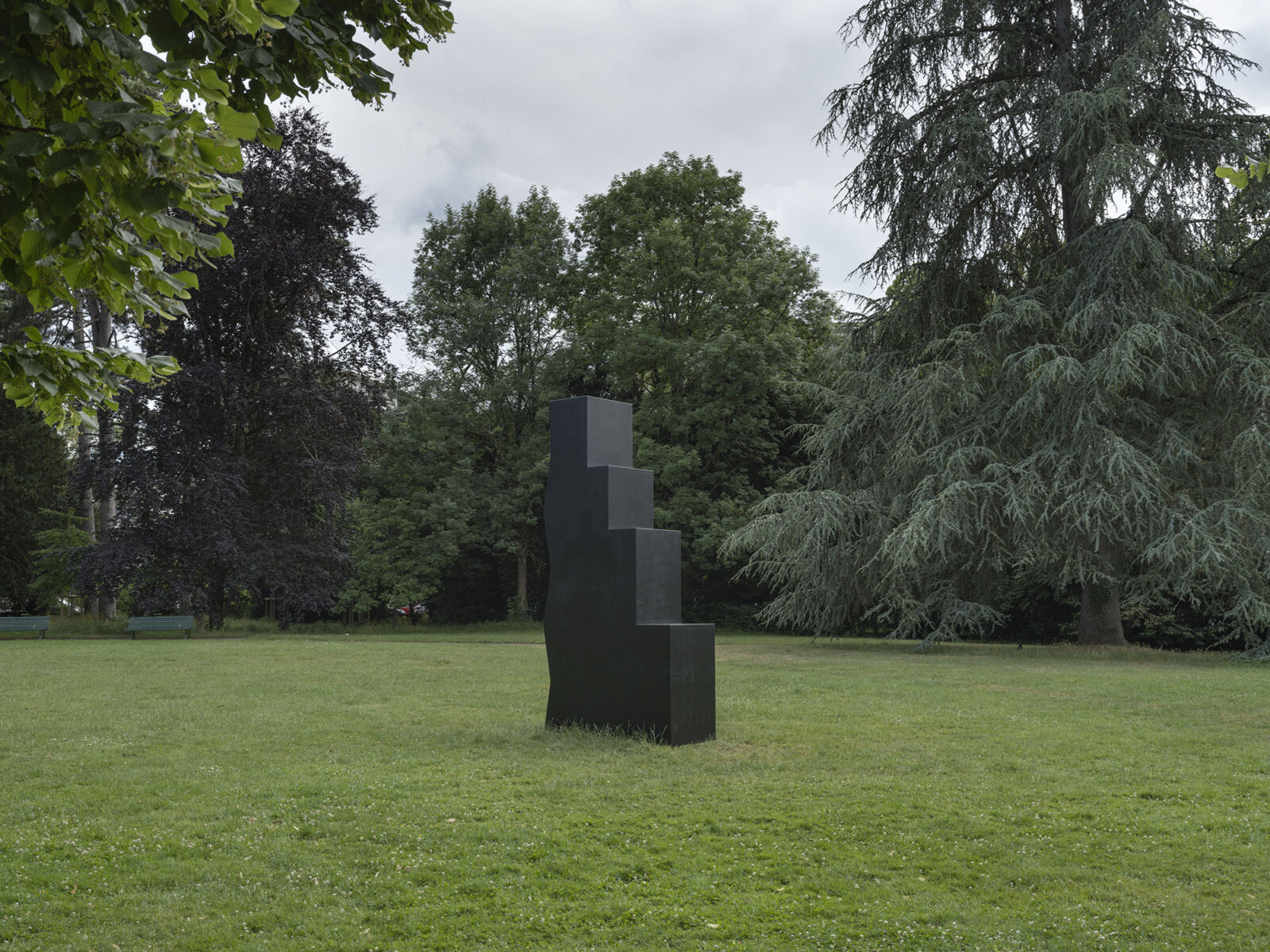
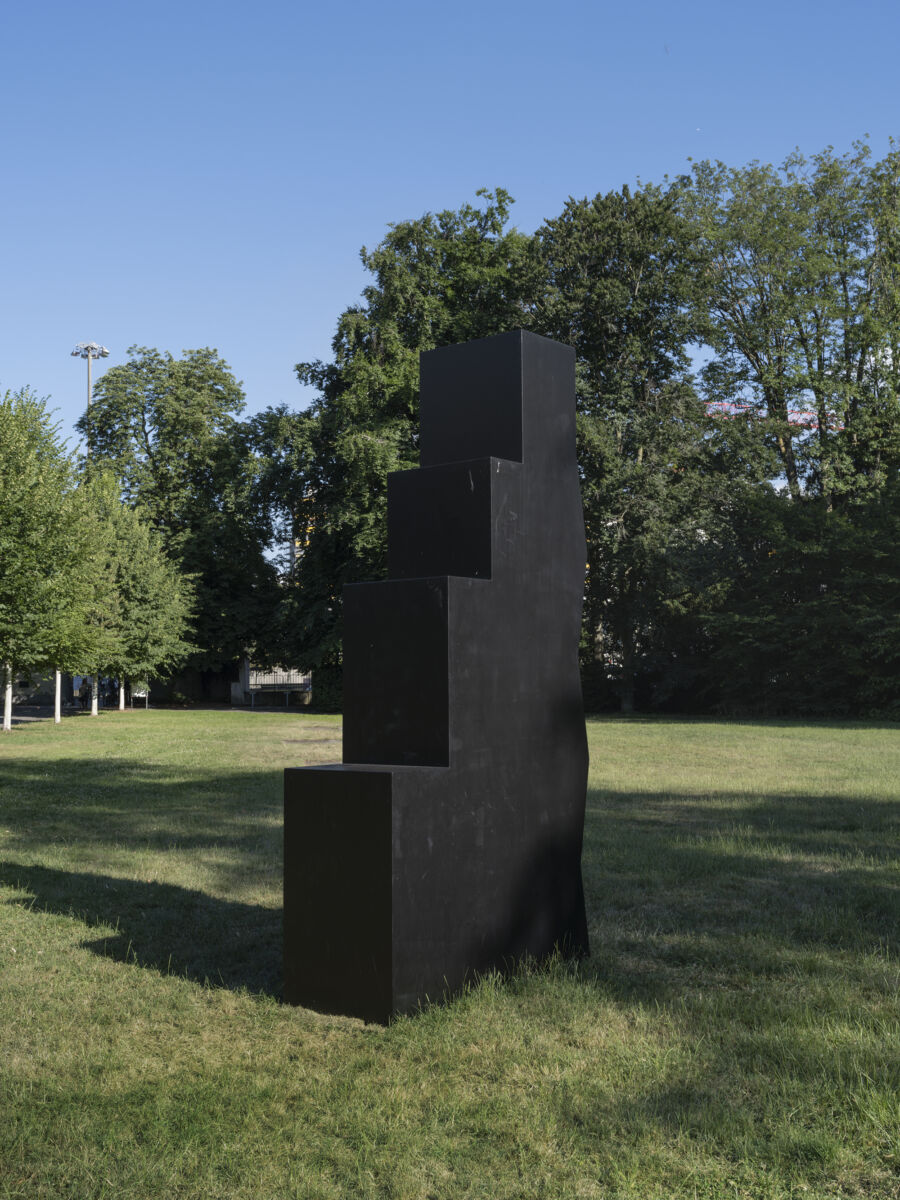
Sophia Al-Maria
(*1983, QA/US)
taraxos, 2021
Steel, copper, wood, titanium, concrete and reflective pigment paint
650 × 200 × 200 cm
taraxos takes the form of a constellation of stems which can be played by the wind or by visitors. The sculpture is inspired by the resilient qualities of the self-seeding dandelion (taraxacum officianale). Focusing on the dandelion’s ability to thrive in unhospitable places, Sophia Al-Maria proposes the weed as a model for freedom, resistance and understanding in the world today. taraxos is a meditative place for anyone to slow down time for themselves and take space to listen. Played by the wind, the sculpture can also be activated by touching the stems, which are covered in copper, a material selected for its anti-microbial qualities. The central node of taraxos is a piece of reclaimed titanium from an airplane. This durable yet light material, ideal for air and space travel, mirrors that of the seemingly fragile airborne dandelion seed. In relation to the sculpture, a programme of performances and a podcast extend the work as a kind of pollination.
Podcast: tarax.live
Serpentine × Modern Forms Sculpture Commission
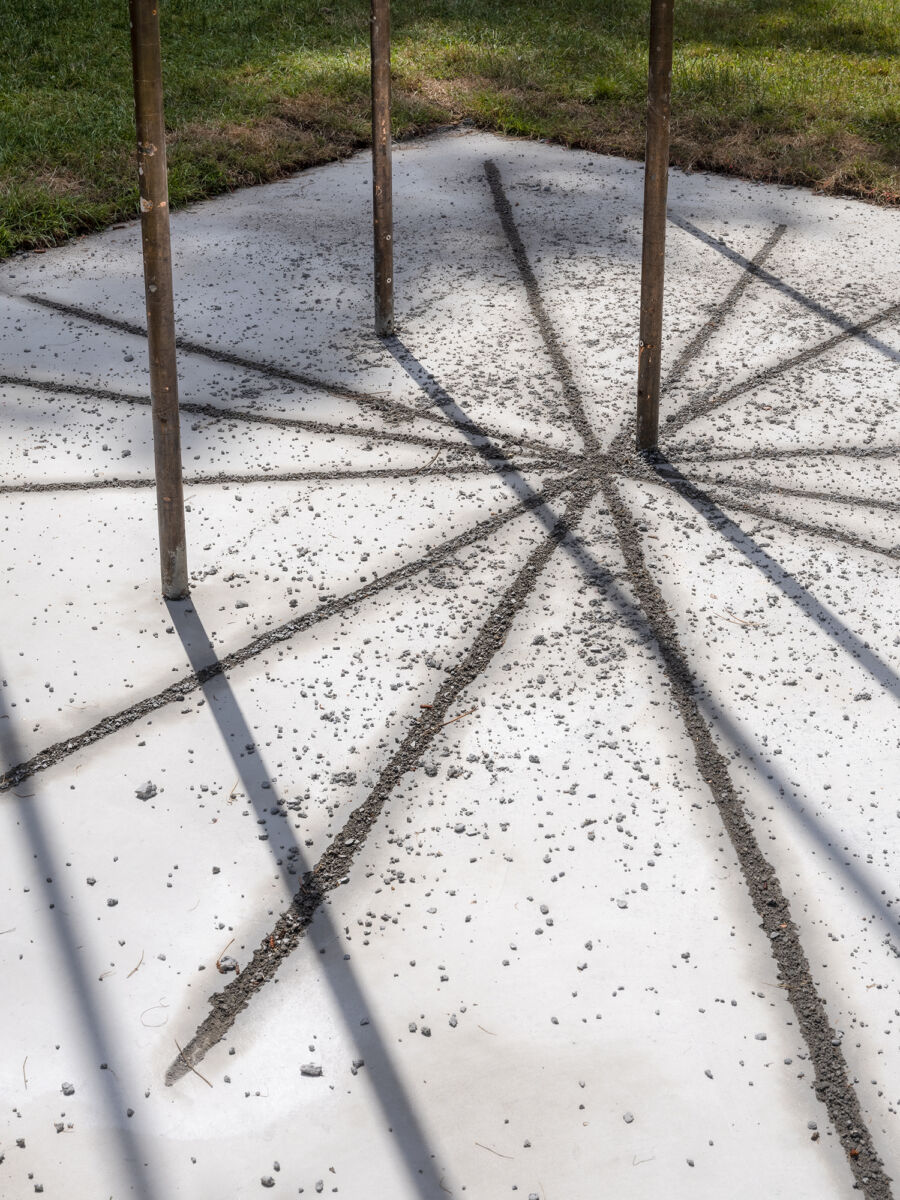
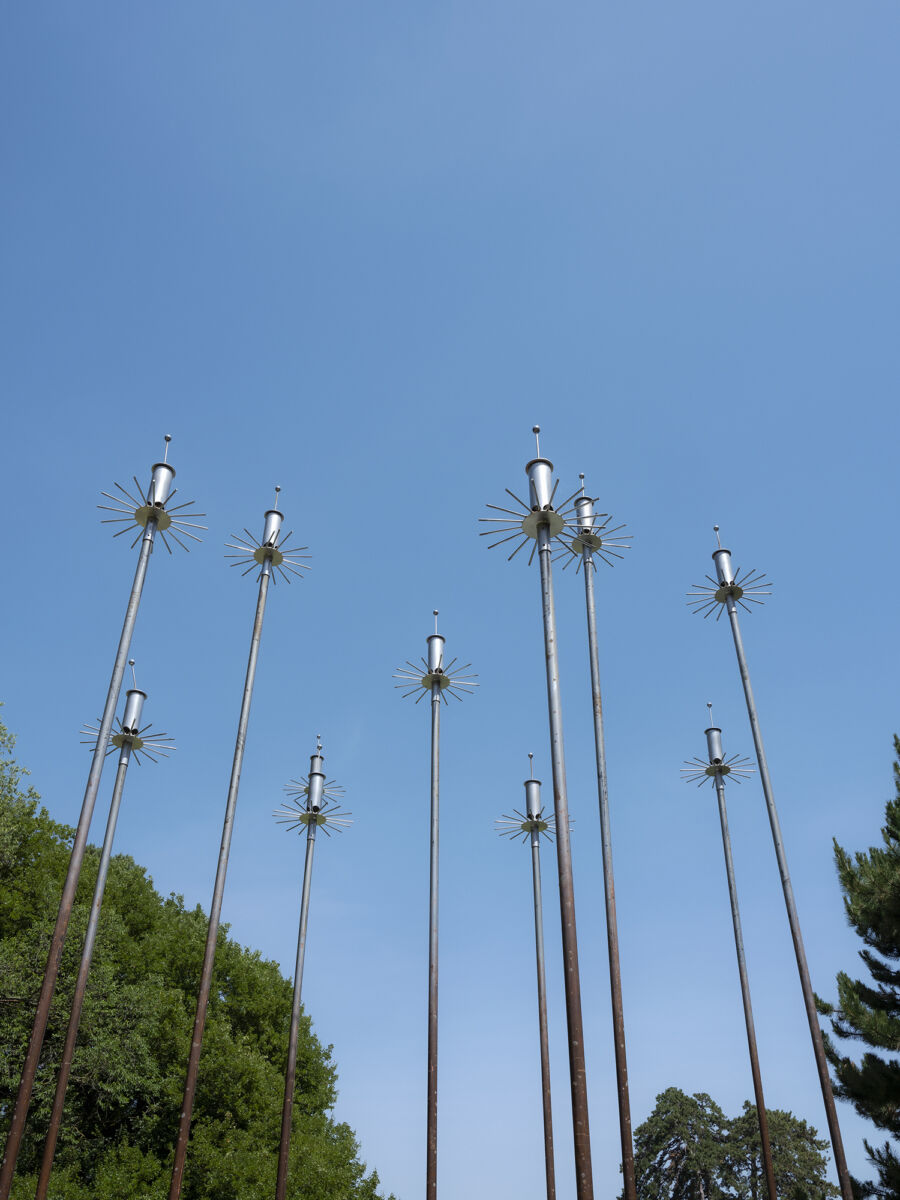
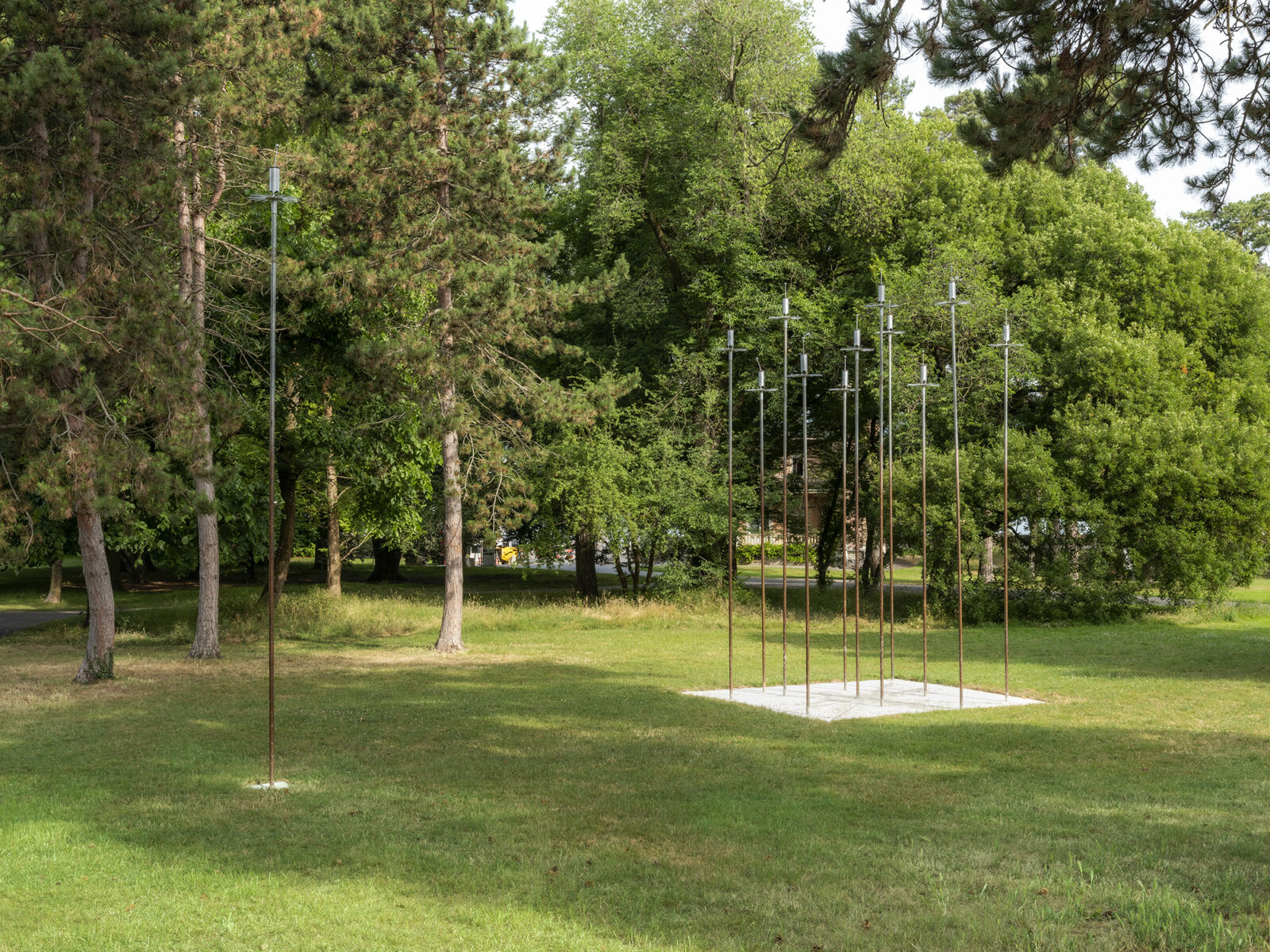
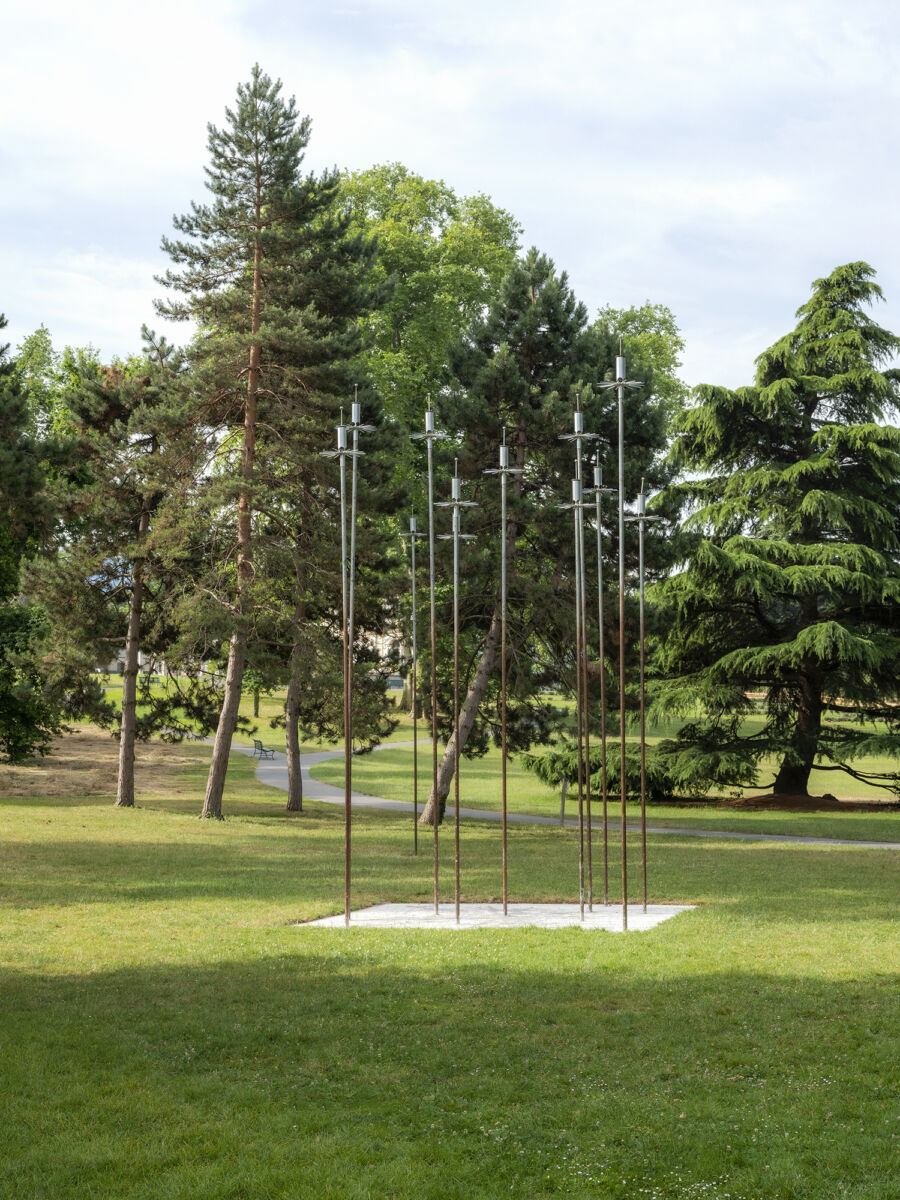
Sammy Baloji
(*1978, DRC)
… and to those North Sea waves whispering sunken stories, 2020
Terrarium and exotic plants
225 × 230 × 130 cm
The form of Sammy Baloji’s monumental terrarium is inspired by the scientific drawings of minerals produced with the purpose of mapping their exploitation in the Congo. The artist also refers to Wardian cases, portable greenhouses which served to transport exotic plants by sea. This mass world exportation of plants by sea, combined with the extraction of minerals in the colonies, created new economic systems and modified existing natural and cultural ecosystems, a process of uprooting and subjection which contributed to the current climate crisis. In that sense the work lays bare the traces of a colonial past which has kept a resonance down to this day.
Beaufort 2021 Commission
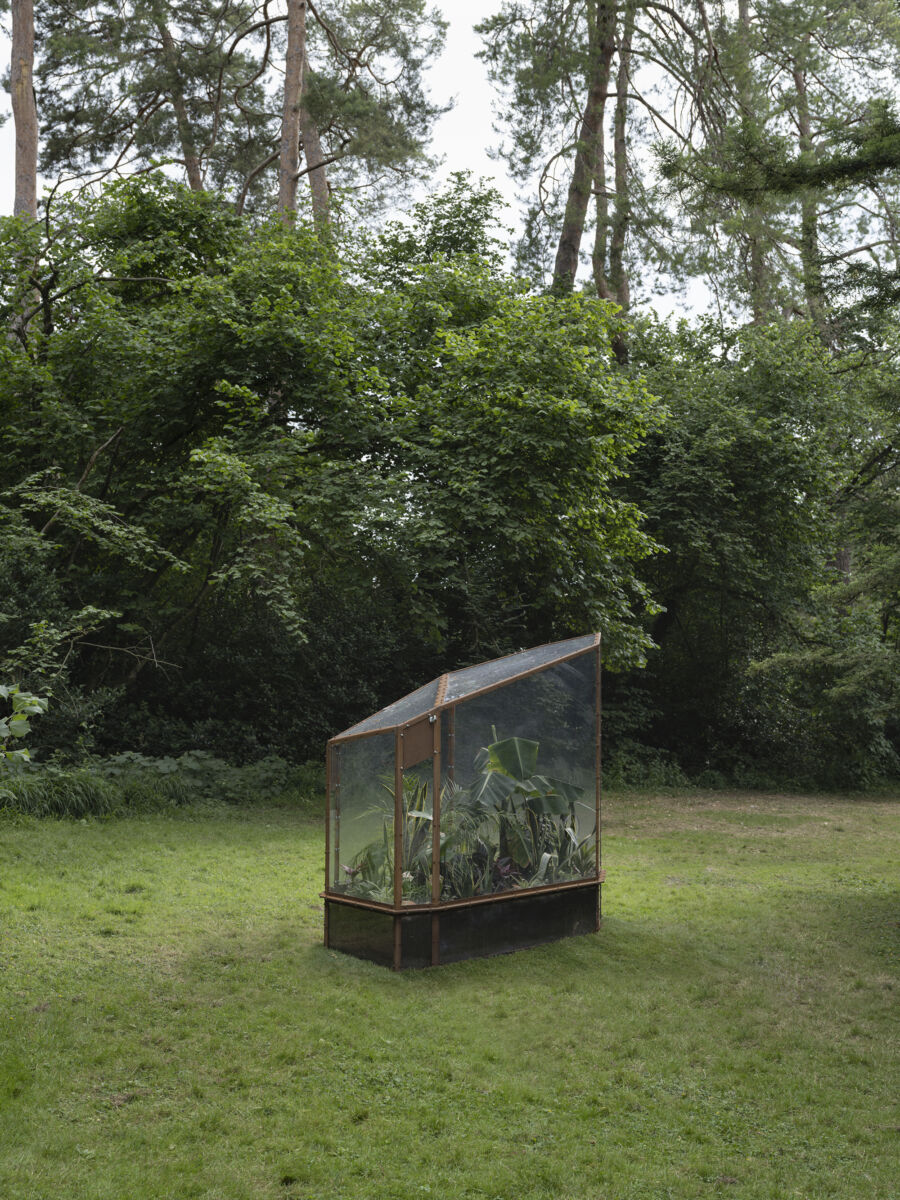
Nina Beier
(*1975, DK)
Guardian, 2018
Marble lions, soap, beard trimmings
Variable dimensions
Nina Beier explores cultural archetypes to identify objects that are both rich in (hi)stories and subject to mutations as regards their intention, their production, their distribution, their commercialisation or their use. In that sense, objects that represent systems which have collapsed are easier to unfold. They capture contradictory intentions and lay open the paradoxical, changing nature of the notion of value. For Sculpture Garden, Nina Beier points to the two lions, symbols of force and of power, which adorn the ma entrance to Parc La Grange, and continues her series of in situ installations made up of marble guardian lions, which she customises in unexpected ways and sets free to roam.
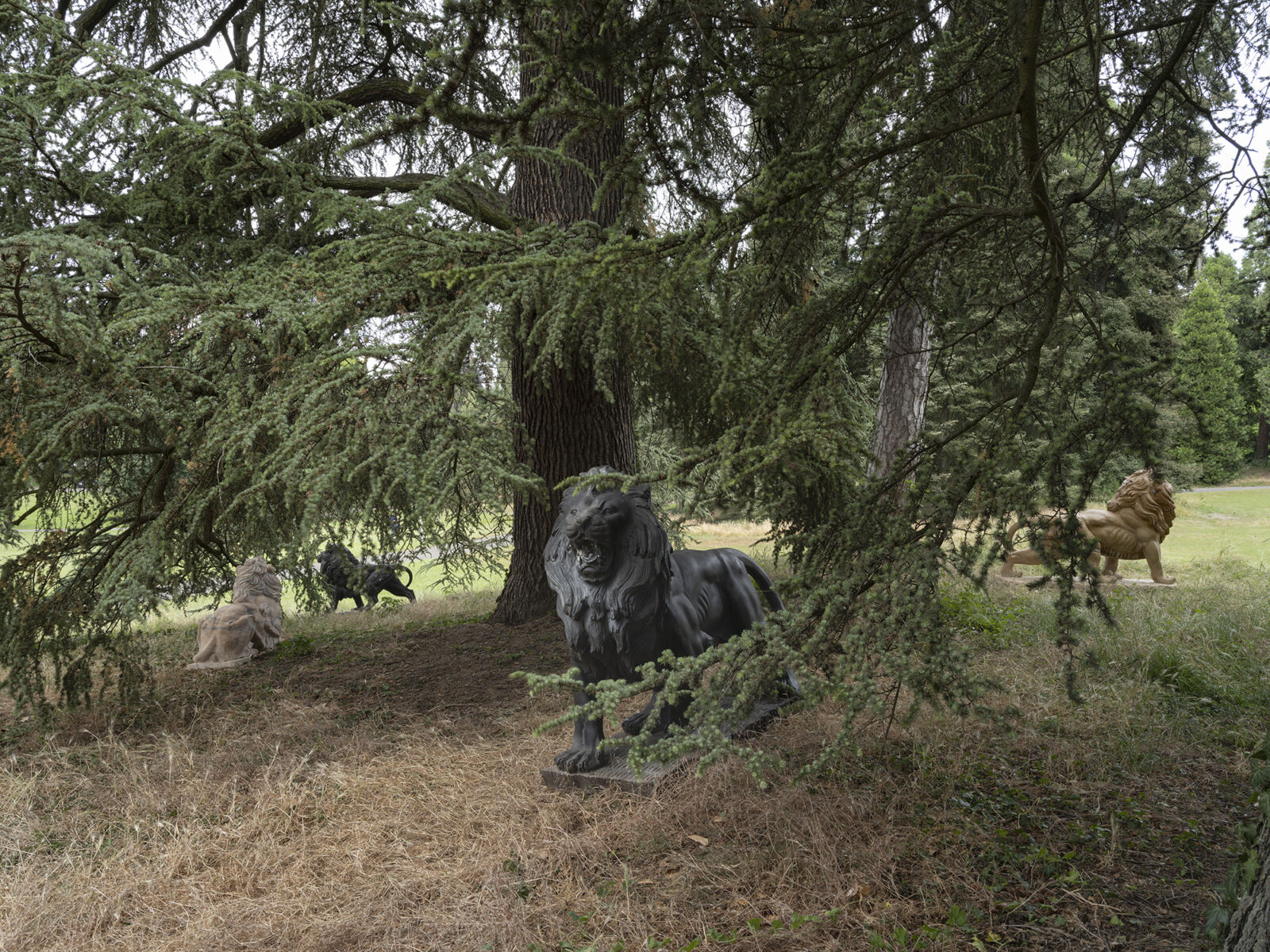
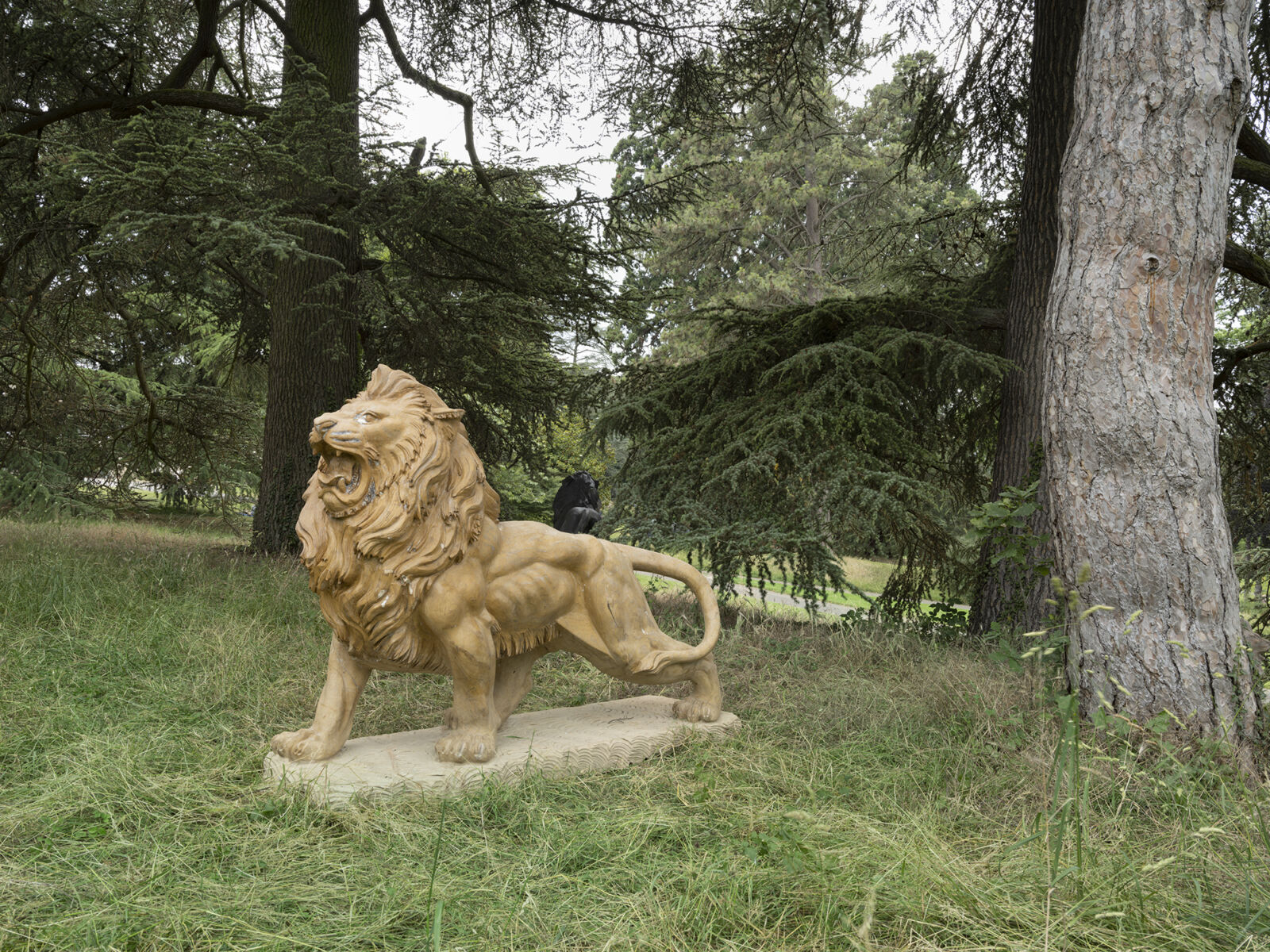
Meriem Bennani
(*1988, MA)
Ghariba (Double Bench), 2017-2022
Sculptural viewing installation with outdoor monitor
6180 × 1360 × 1200 cm
Meriem Bennani’s often immersive works bring together, in witty and whimsical ways, questions of fractured identities, gender issues and the ubiquitous dominance of digital technologies. Her sculptural video installation makes it possible both to get a tan and to watch the film Ghariba (a word which means “foreigner” or “strange” in Arabic), which unveils a playful and moving portrait of a few women from the artist’s family in Morocco. Reminiscent of reality TV and family videos, its visual language is both intimate and fanciful, the director’s digital manipulations playfully mediating our relationship to her family members. Bennani’s women talk about love and romance, meeting and friendship, solitude and community, all of them set against the dread of aging.
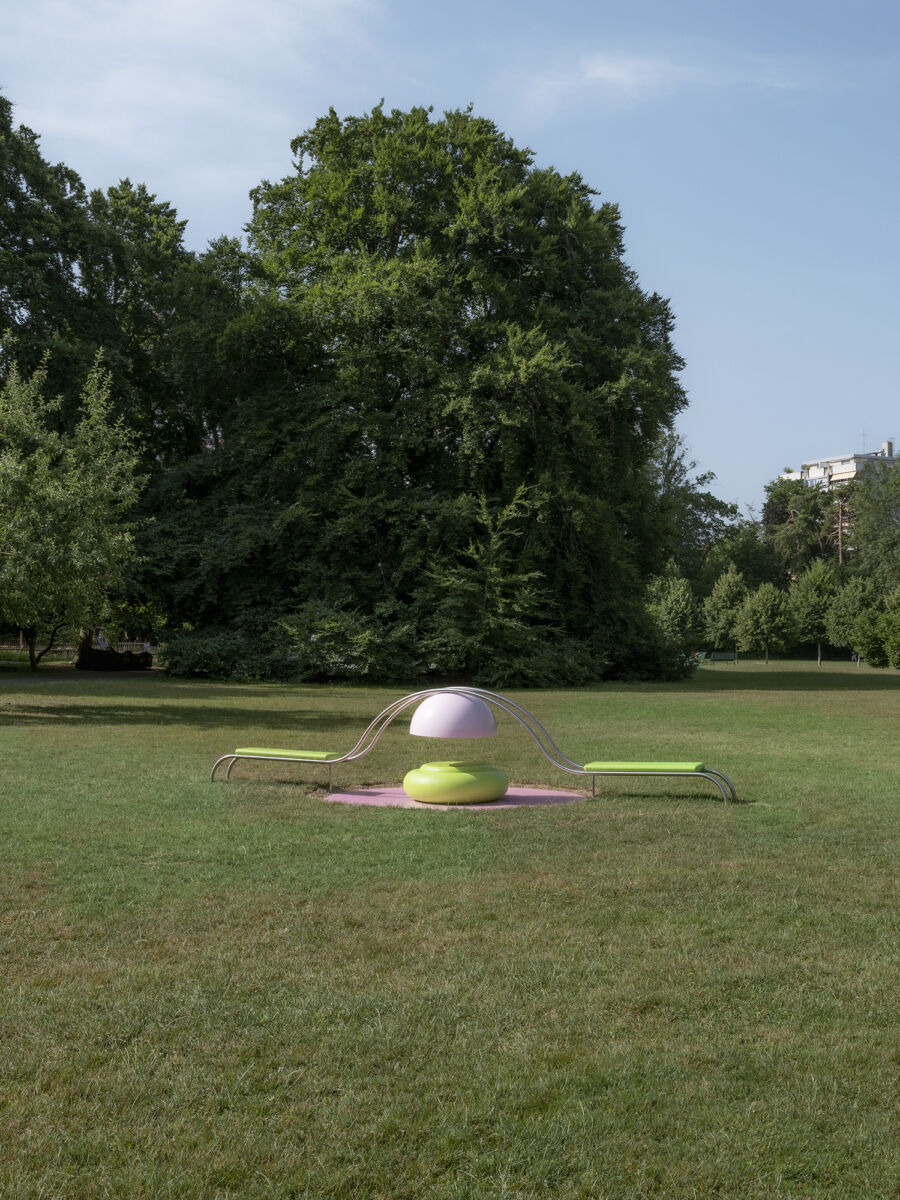
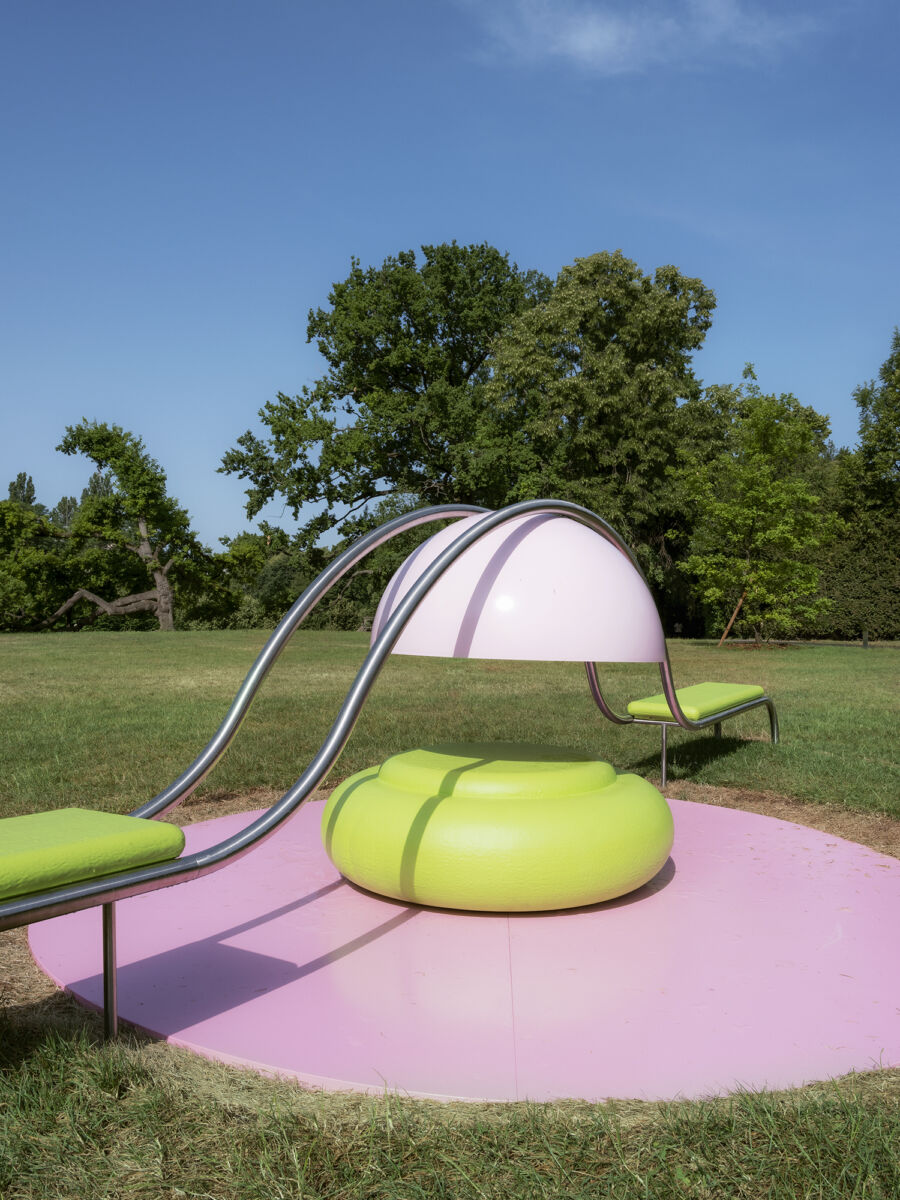
Charlotte vander Borght
(*1988, BE)
MASS II, 2020
170 × 119 × 60 cm
Collection Tanguy & Bieke Van Quickenborne
MASS III, 2020
235.5 × 63 × 103 cm
Collection Luc & Carine Haenen-Van Aelst
MASS VI, 2022
175 × 236 × 60 cm
MASS VIII, 2022
175 × 189 × 60 cm
MASS IX, 2022
175 × 104 × 20 cm
Painted aluminium and steel
Drawing on the history of design, painting, or architecture, Charlotte vander Borght constantly questions and reinterprets the materials and structures belonging to the realm of industrial production. Acutely aware of programmed obsolescence and the ever-accelerating exchange of goods, services, and data, vander Borght aims to shine a new light on “everyday objects”. The series entitled MASS brings together sculptures that are physically impressive yet light in their materiality. They were produced from boards of Dibond made in the 1970’s, and recovered from a Paris modernist building. Hovering between abstraction and figuration, Charlotte vander Borght has repurposed, reshaped and painted these initially industrial panels in order to elicit their emotional power, to expose the affective and collective memory that is latent in materials.
With the support of Fédération Wallonie-Bruxelles
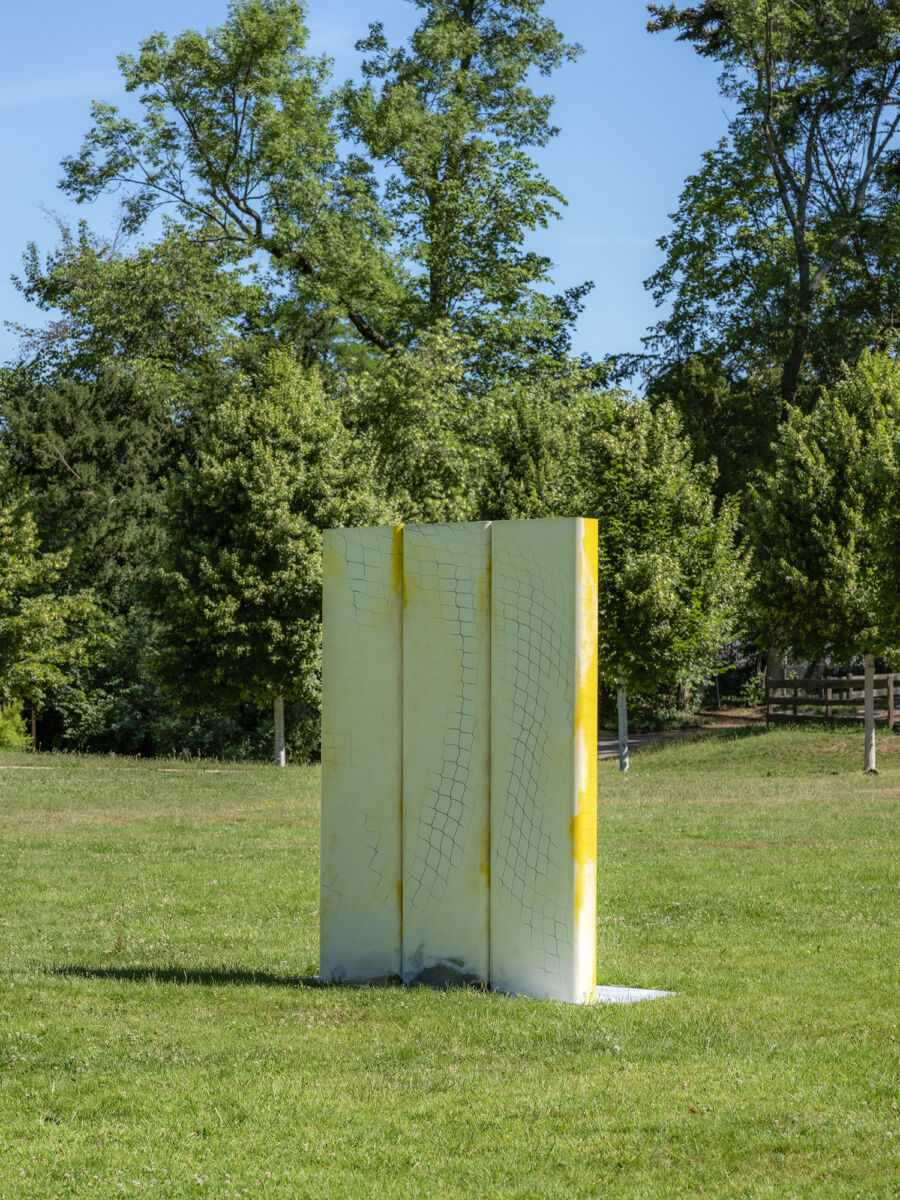
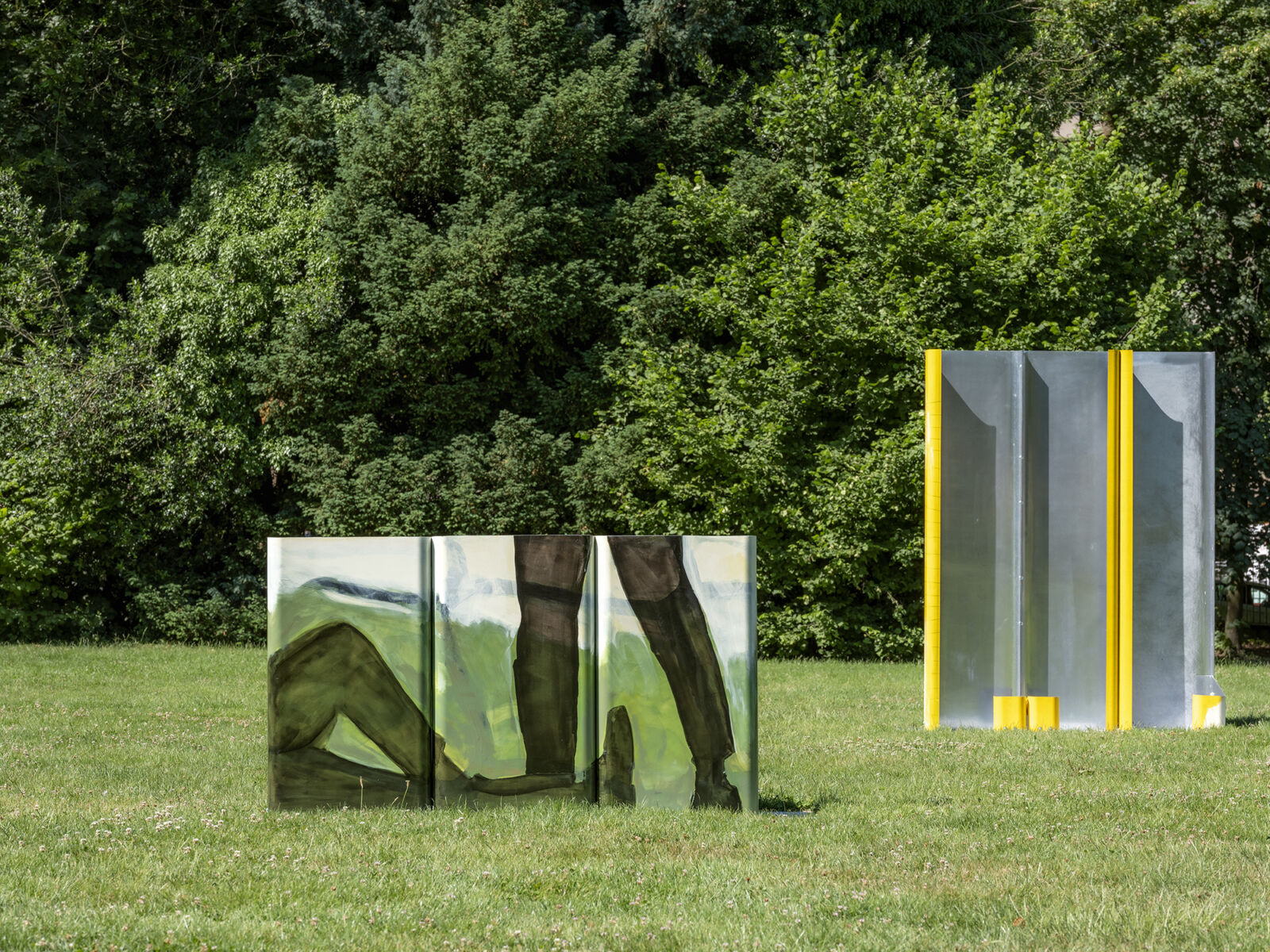
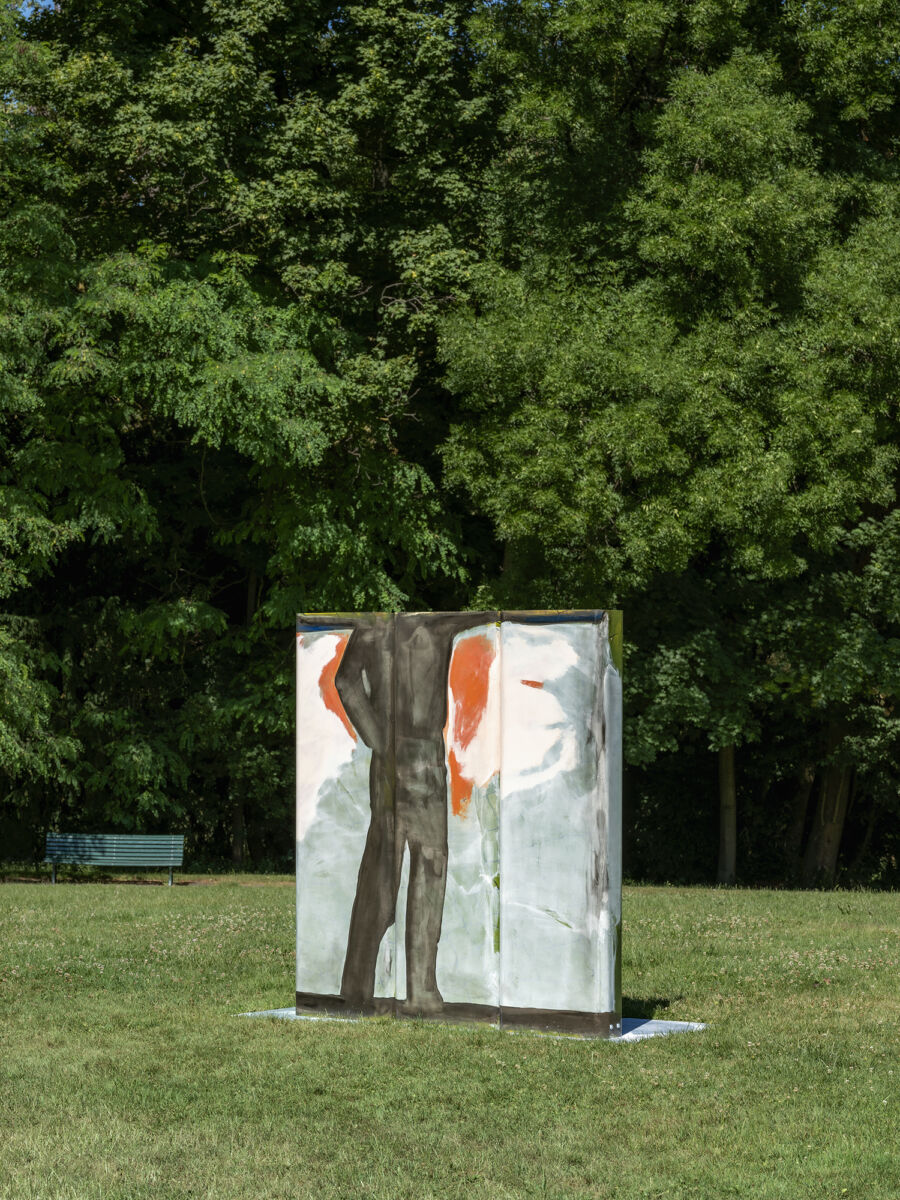
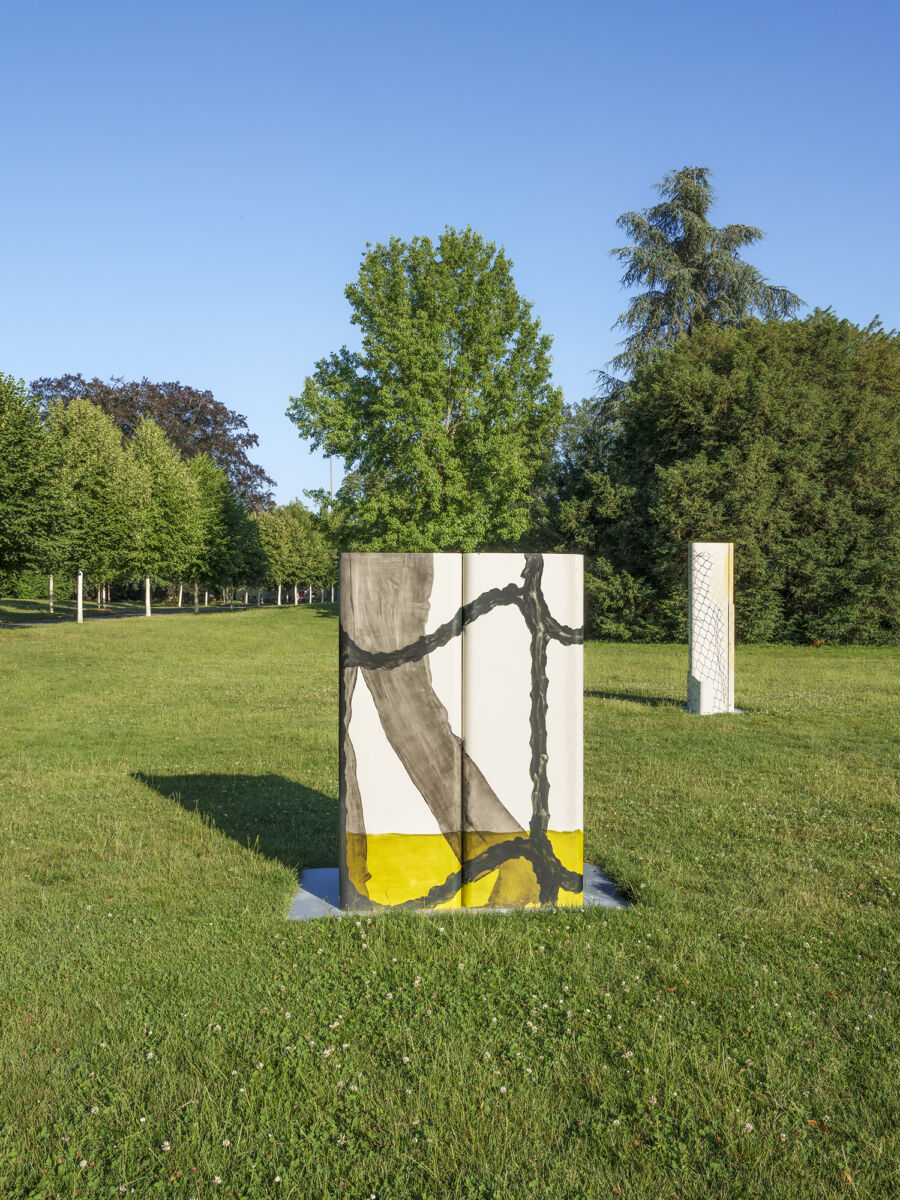
Elif Erkan
(*1986, TR)
Where You They Form, 2020
Concrete, natural rubber, cellular polystyrene covered with soil from Austria, Germany, Russia, Turkey and France
For Sculpture Garden, Elif Erkan has created an installation in which the notions of origin and territoriality, with their socio-political repercussions, are tackled in an array of sculptures, shaped as menhirs and covered with soil from different countries involved in the Geneva protocols. Menhirs are simple rock formations which are often considered as sculptures from the Stone Age. Archaeological excavations round them have not only aroused curiosity regarding their technique, but have also transformed their sites into tourist monuments and benchmarks of human and cultural progress. In the installation Where You They Form, through the shapes reminiscent of menhirs and the use of soil as covering material, Erkan explores narratives which assert that history is always a soil-based speculation.
With the support of SAHA
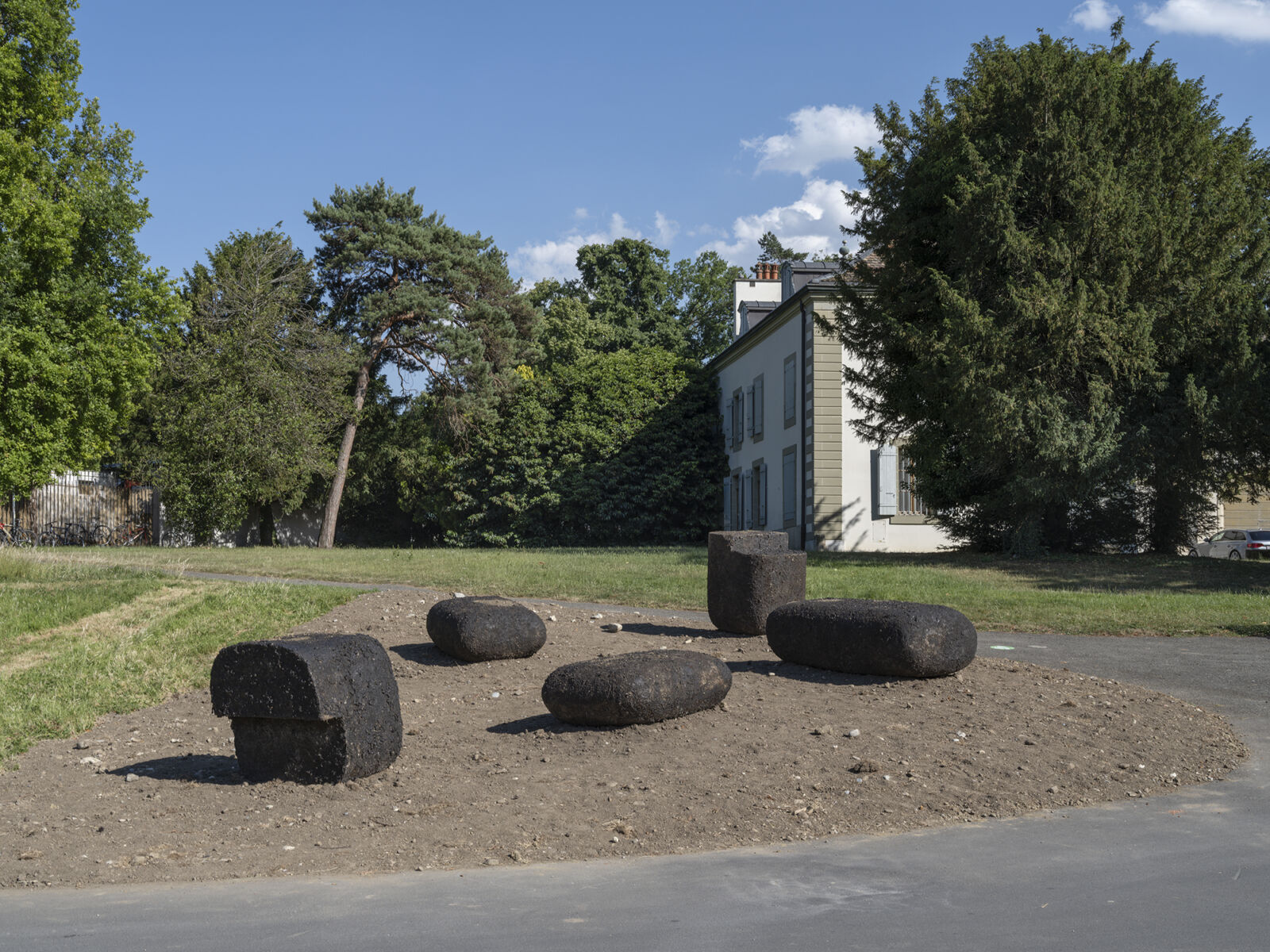
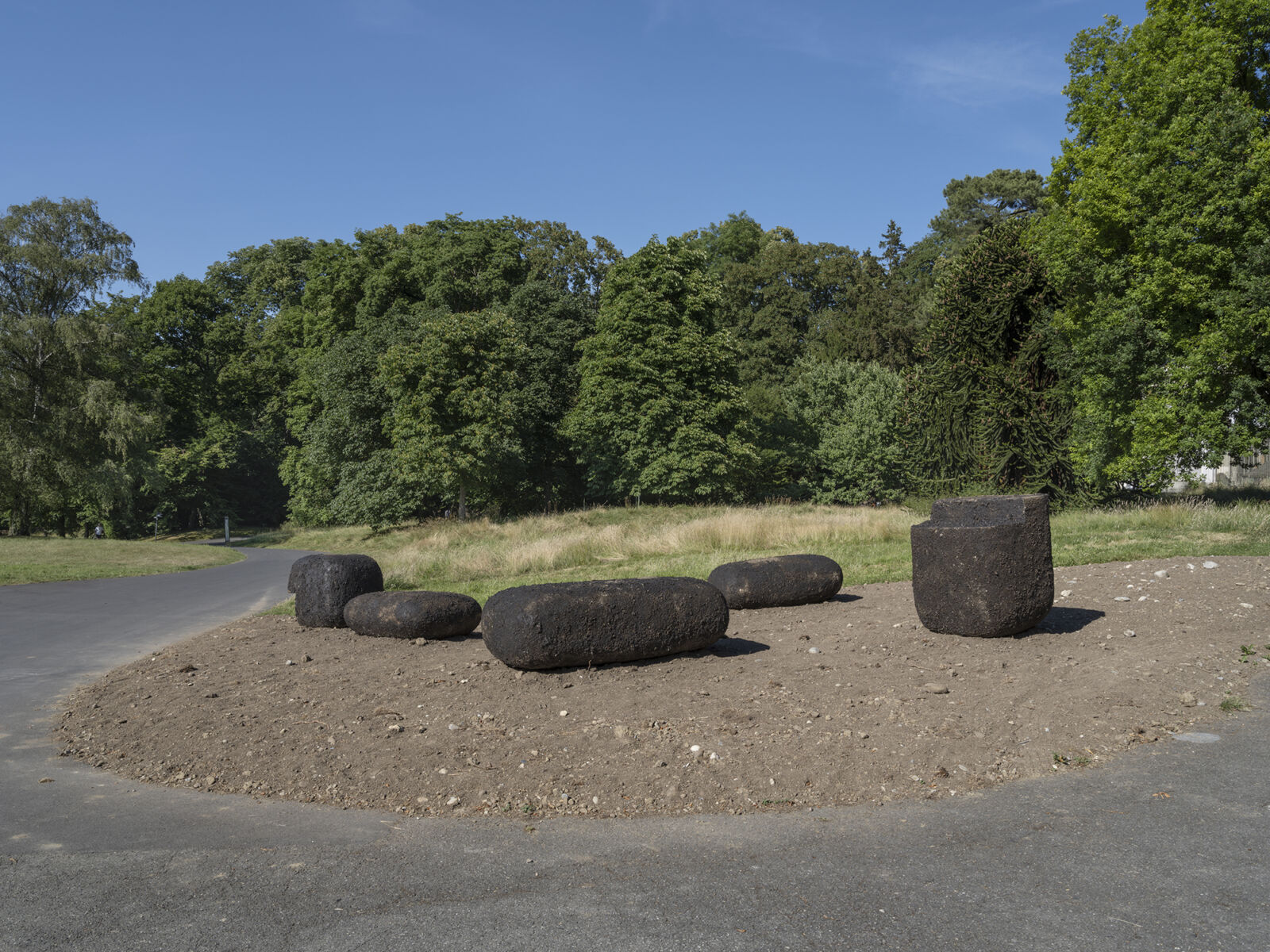
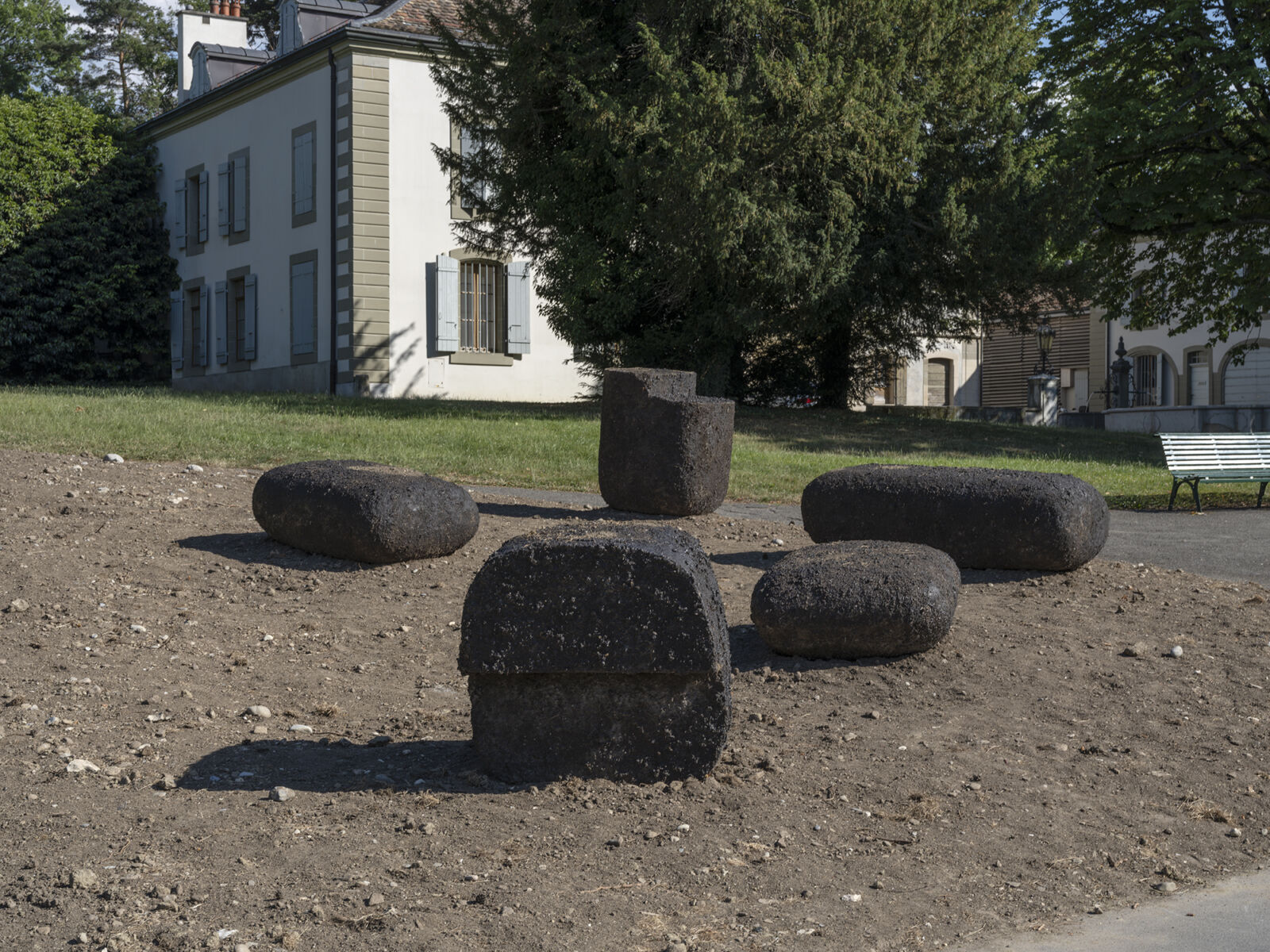
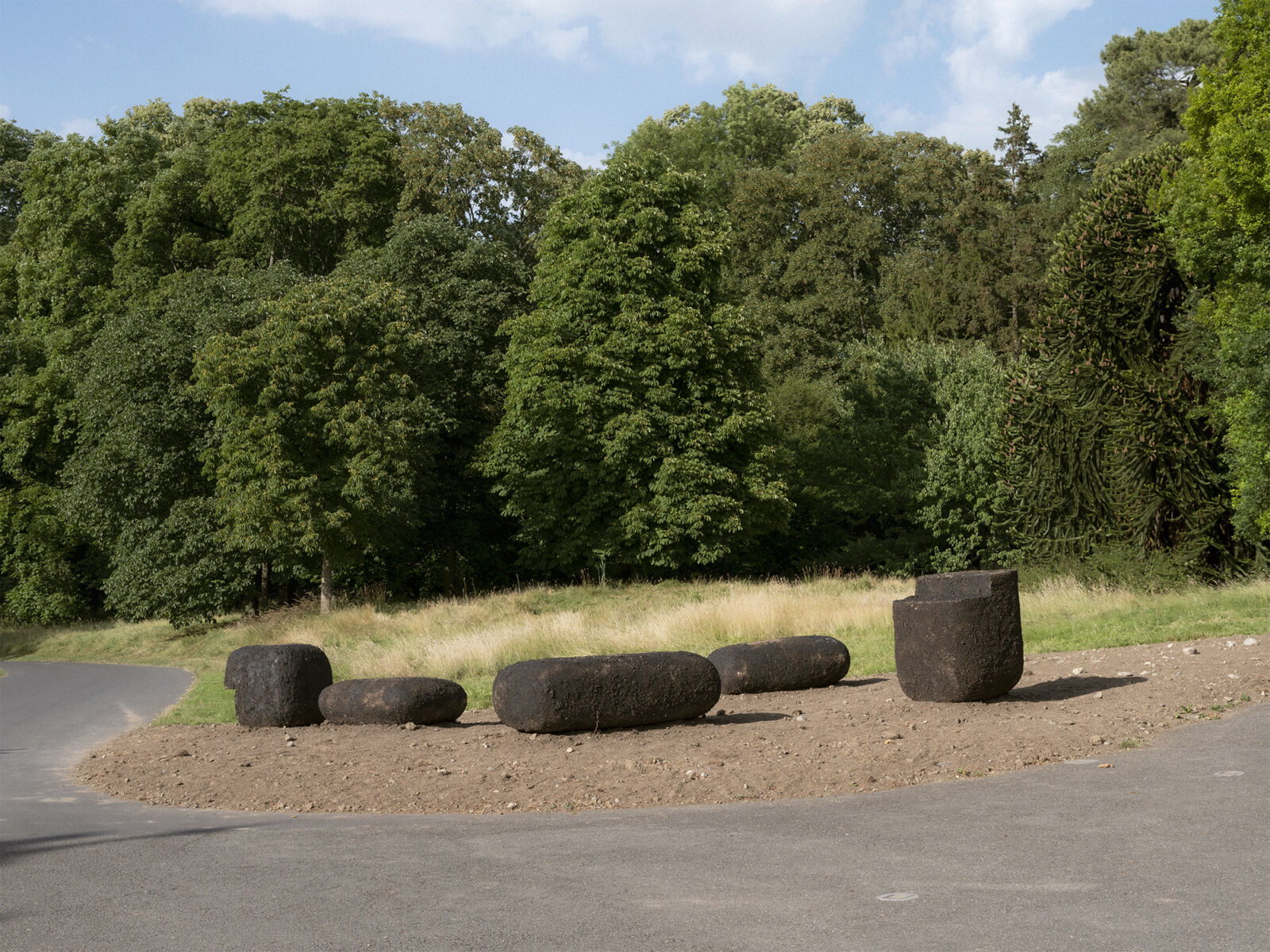
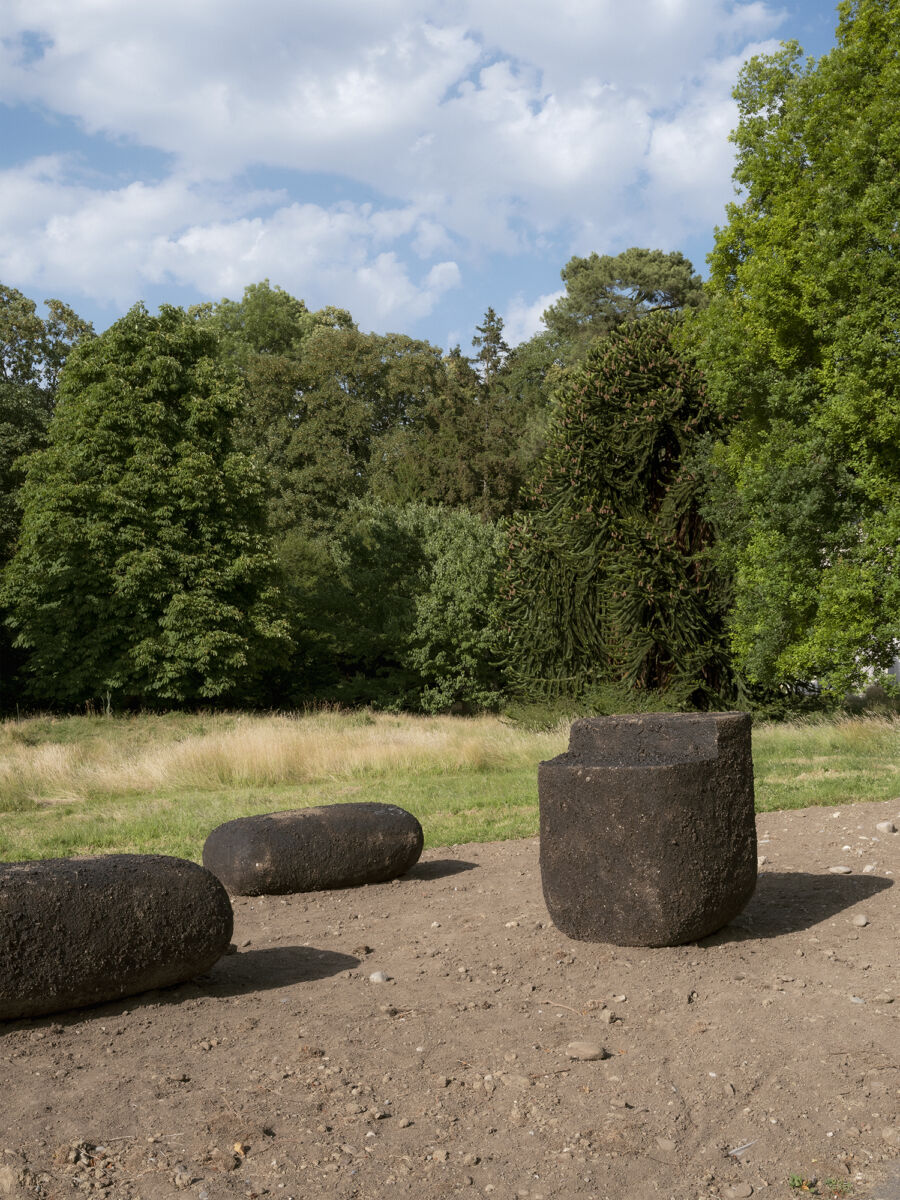
Alia Farid
(*1985, KW)
In Lieu of What Is, 2022
Fiberglass and polyester resin
Variable dimensions
In Lieu of What Is is a monumental installation of five larger-than-life vessels used to store and carry water–a globular lota, a jerrican, a juglet with a small lid, a now-ubiquitous PET-plastic water bottle, and a pitcher. Alia Farid’s versions are enormous but hollow and light, molded in lacquered fiberglass, colored like the desert sand and fabricated using the same method as the decorative casings for public drinking fountains that have become a distinctive feature of the urban landscape across the Arabian Gulf where the artist comes from. Over the past few years, Farid has been working with commercial fountain producers to develop constellations of these sculptures (sometimes casting copies from existing molds, sometimes creating her own) as a way to intertwine a centuries-old tradition of public drinking fountains with the reality of water desalination in the region–the lack of available fresh water being an ecological consequence of government policies and the activities of industries that have prioritized oil extraction above nearly all else.
Co-production with Kunsthalle Basel
With the support of Commune de Cologny
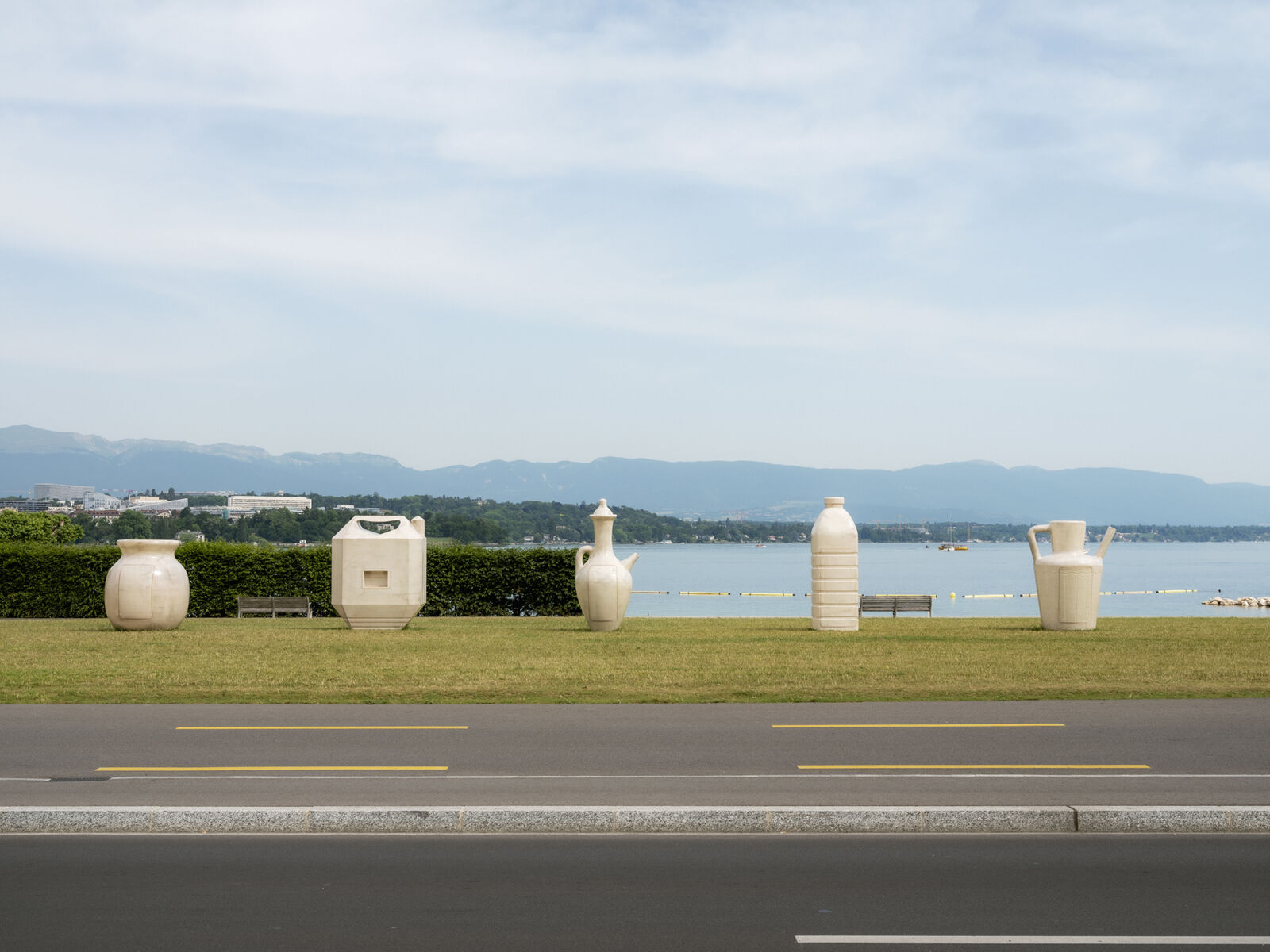
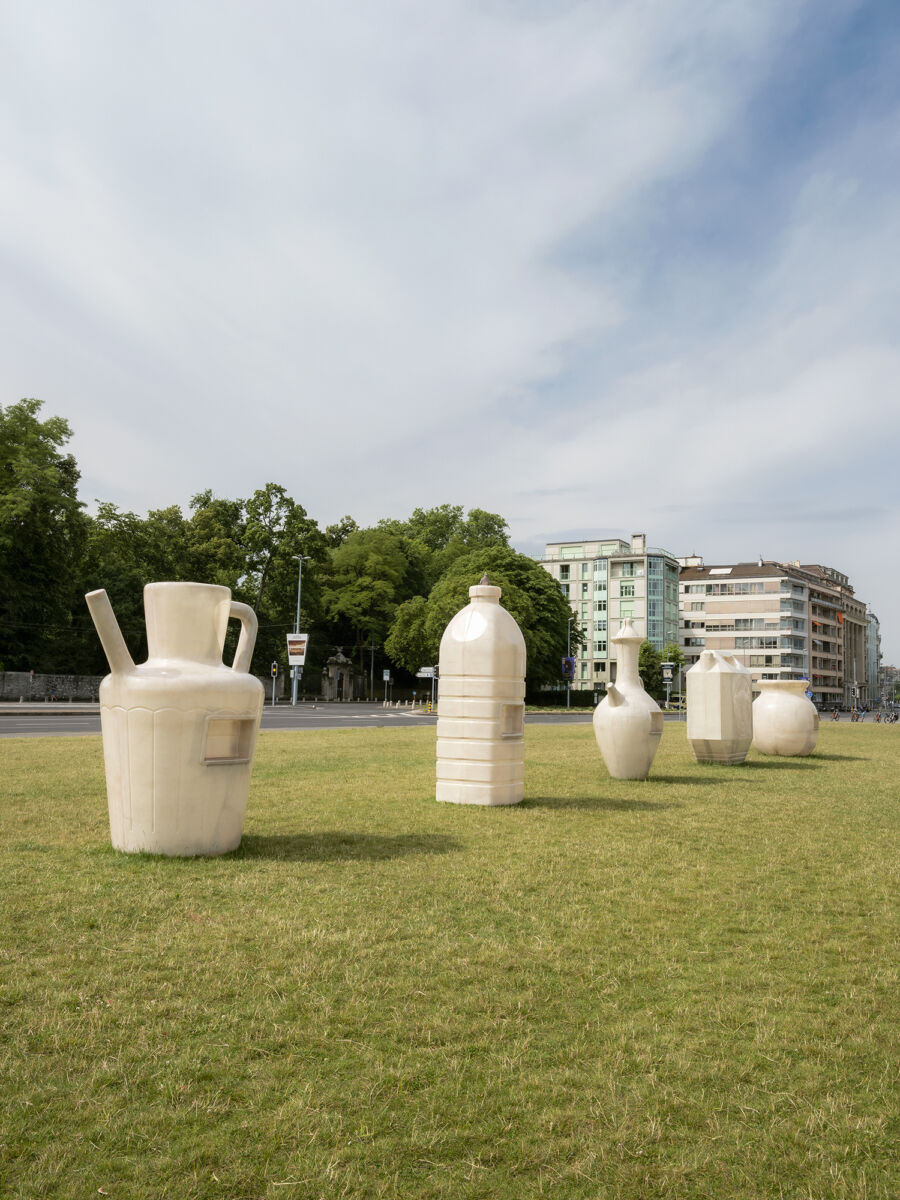
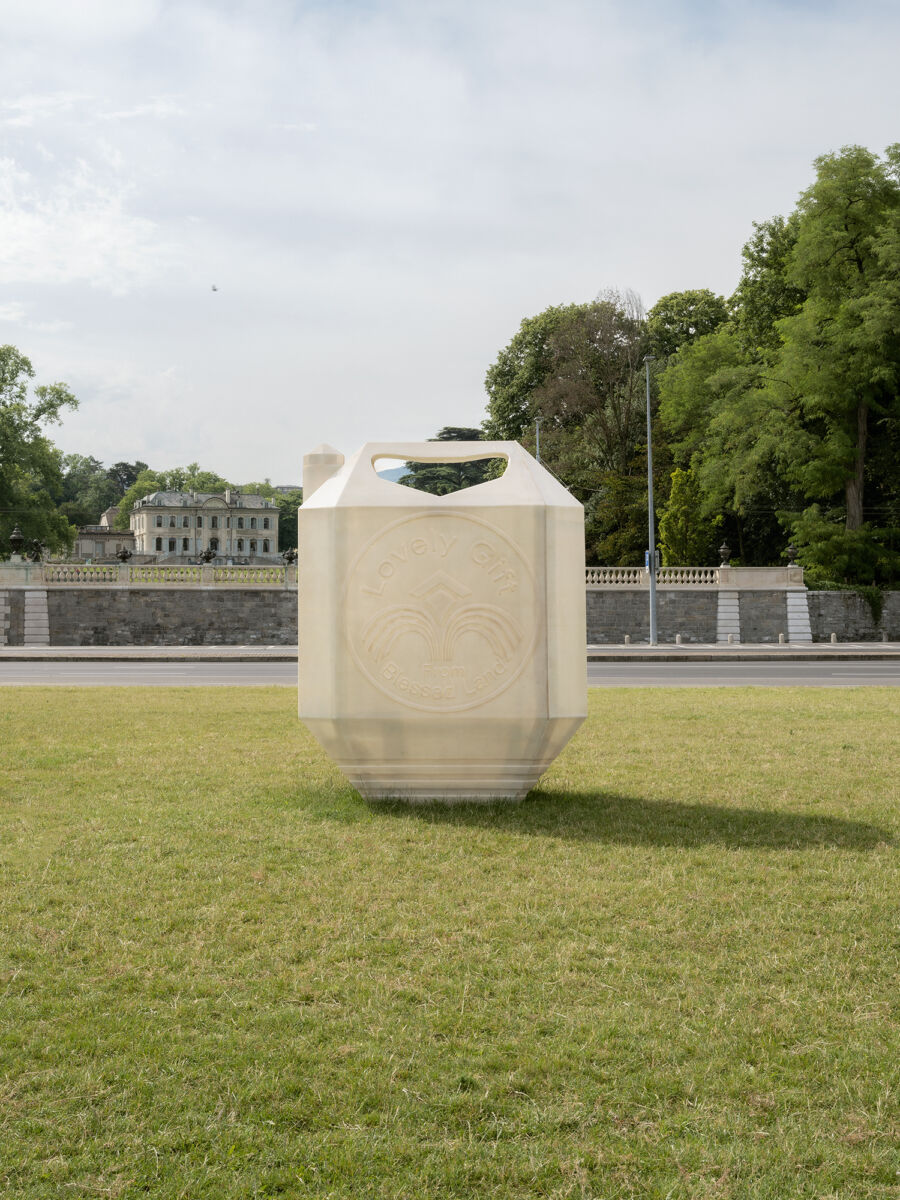
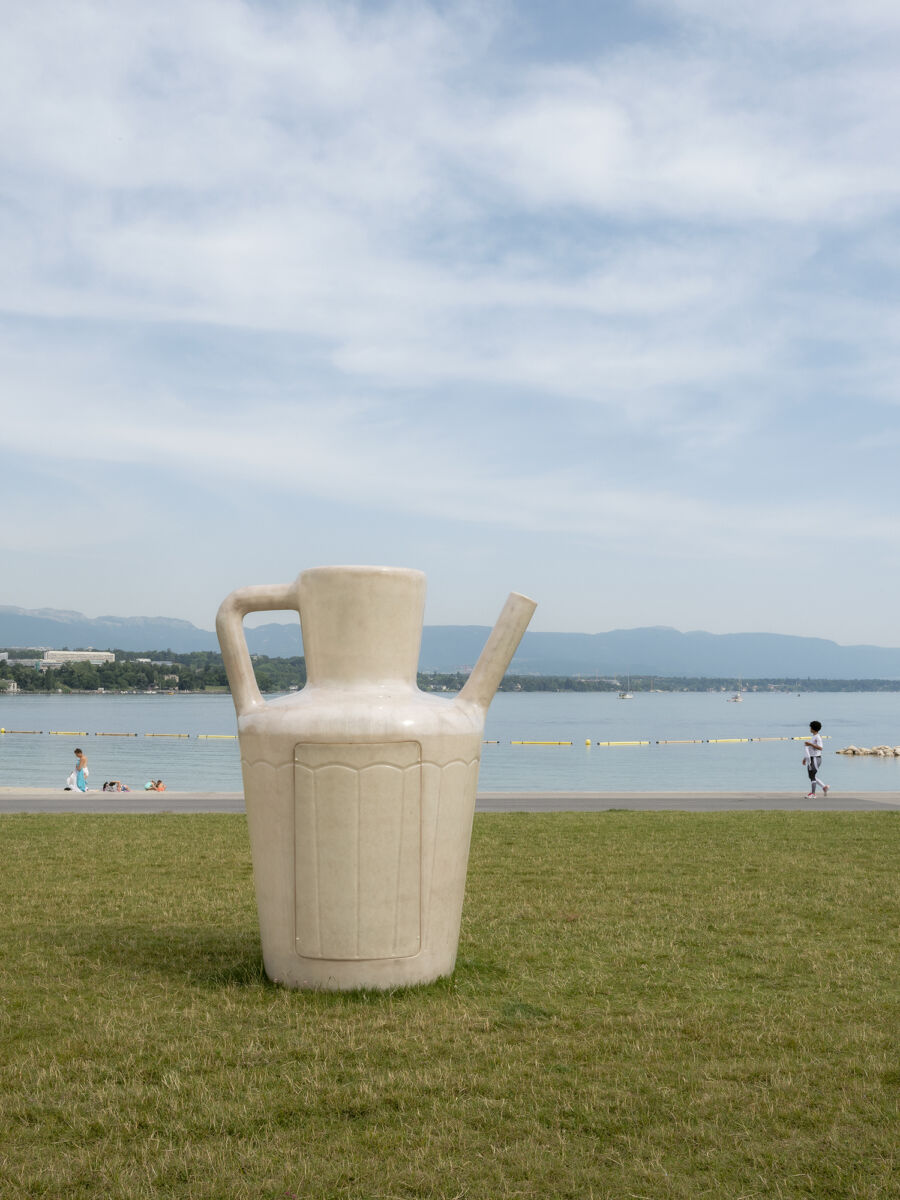
Manfred Pernice
(*1963, DE)
Antenne Brandenburg, 2021
Metal, plastic, concrete
237, Ø 114 cm
Since the 1990’s, Manfred Pernice has developed sculptures and installations often based on functional and “modern” forms, built with low-grade materials or configured with objects and texts, drawings, photographs, often linked to historical context or of biographical nature. The familiar in Pernice’s work emerges from moments of functional leftover, ruin or remembrance. For Sculpture Garden, Manfred Pernice presents a work which resembles an aerial antenna, to which he gave the name of a German radio station. This piece is part of a series which reflects on the potential of sculptural forms for communication.
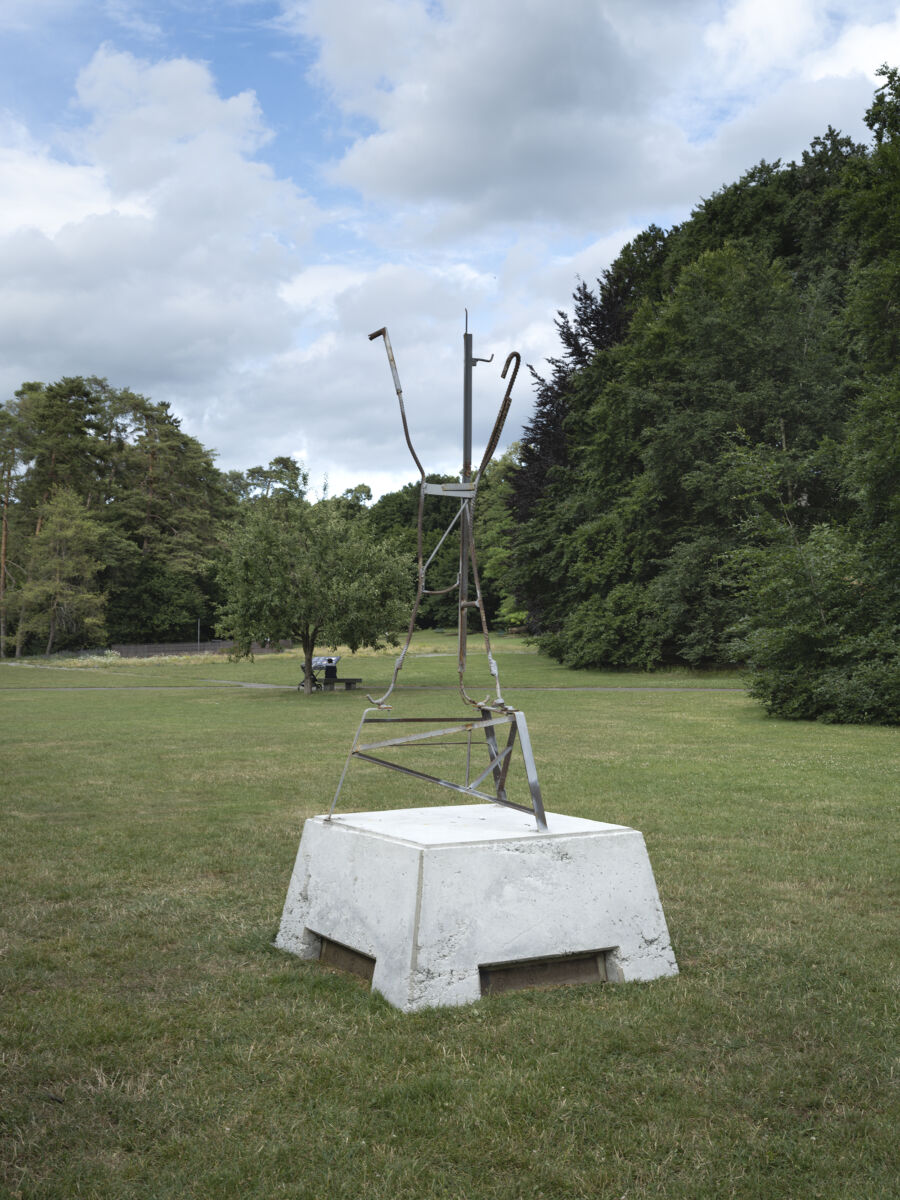
Bojan Šarčević
(*1974, FR)
New Emotional Style, 2020
Marble block, ice cube machine, ice, sound system, carved marble, limestone, birch wood
179 × 81 × 169 cm
New Emotional Style est un bloc de marbre, marqué de coupes géométriques, sur lequel est posée une machine à glaçon en état de marche et une effigie humanoïde taillée en marbre vert. A intervalles, un bourdonnement sonore est émis depuis la pièce. La sculpture s’apparente à des reliques d’un futur dans lequel les machines et les corps telluriques communient dans l’intimité.
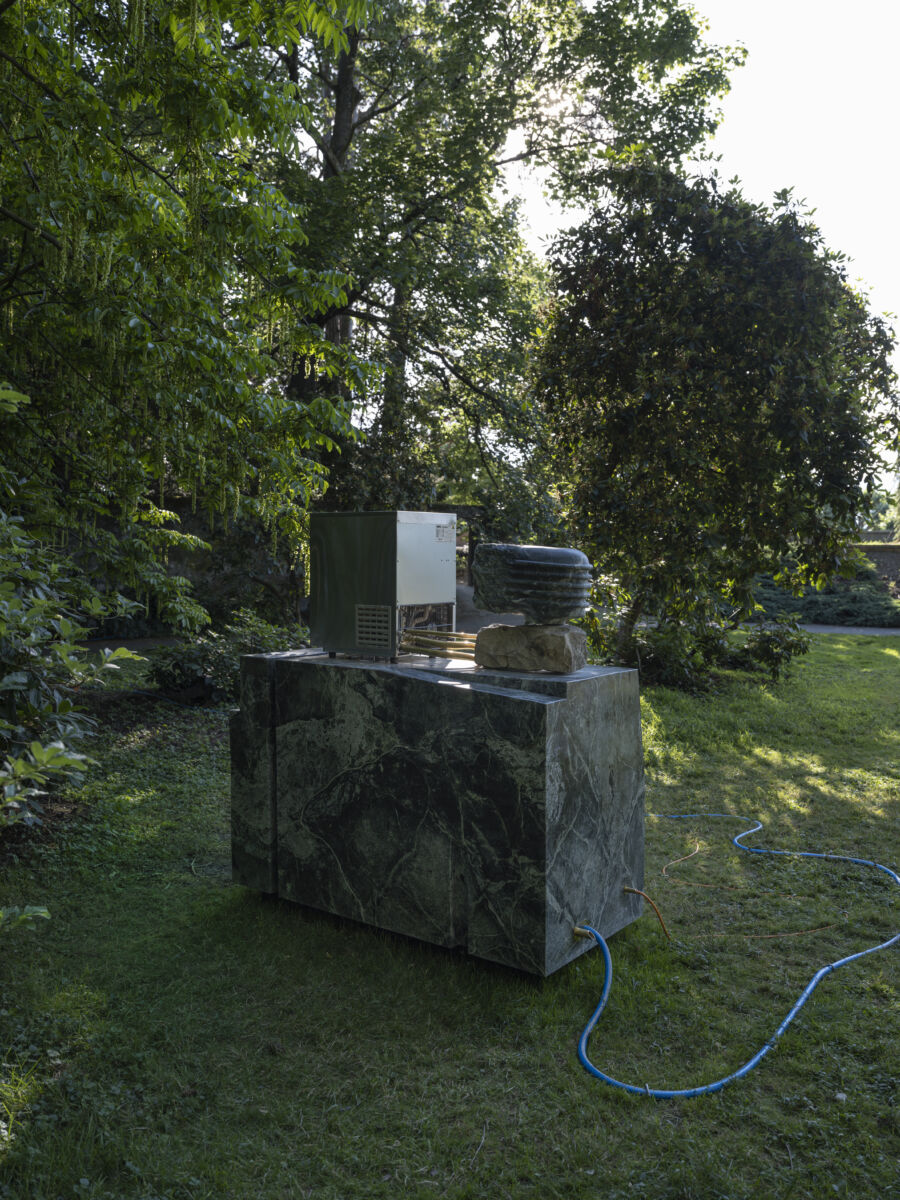
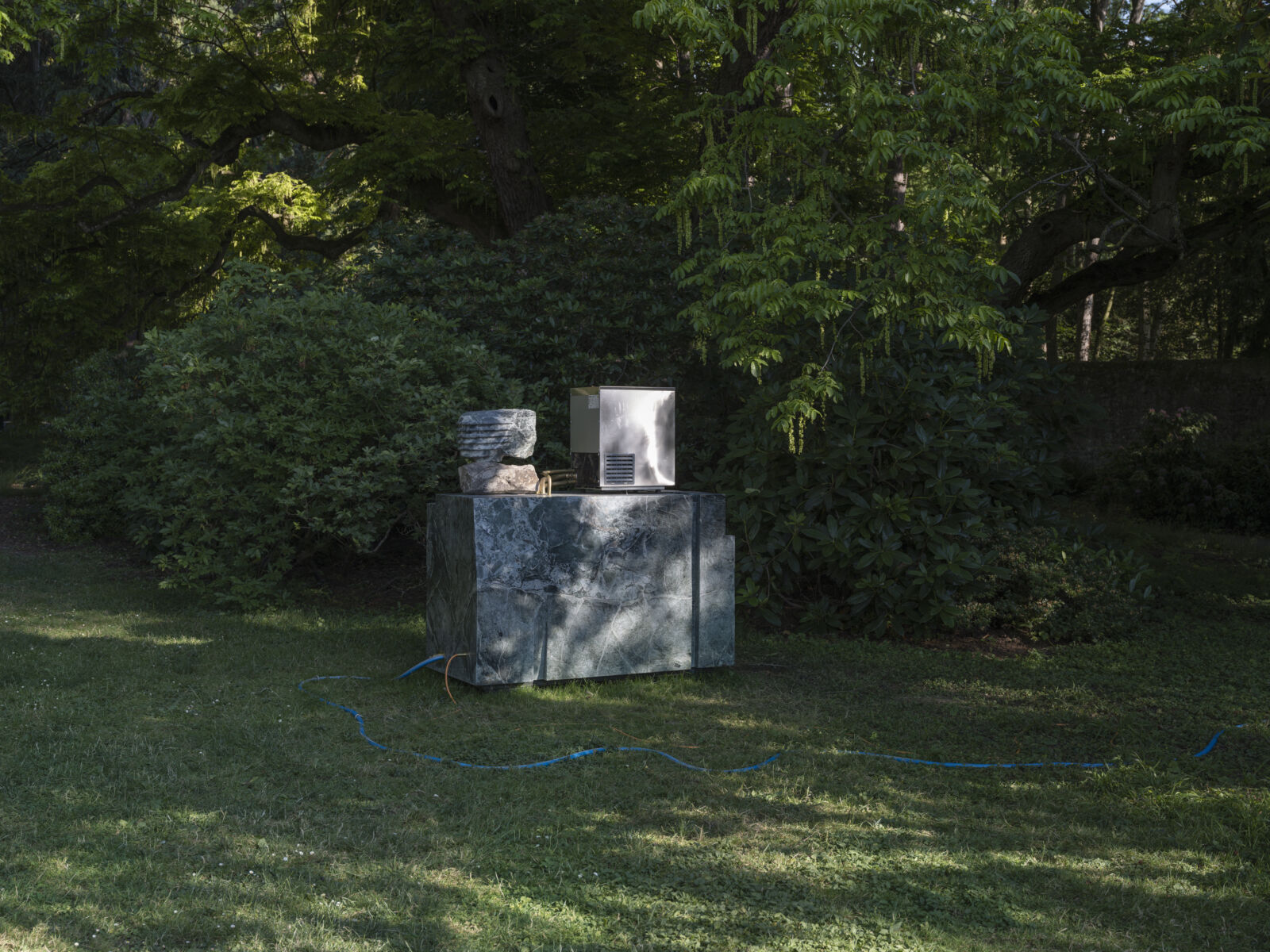
Erika Verzutti
(*1971, BR)
Venus of Cream, 2020
Bronze
210 × 79 cm
Brazilian artist Erika Verzutti is internationally renowned for her work on the living. Working with various materials, such as papier maché, concrete, bronze and the casting of natural elements and larger, invented fruits she molds in clay, the artist explores the role of natural ready-mades in sculpture. Verzutti’s universe is akin to bestiary and tropical flora in which all sorts of organic forms intermingle: animals, fruit, totem… most of them imbued with an erotic charge. For Sculpture Garden she presents one of her inverted Venuses, as a homage to sensuality and fertility, in the form of a piece of many-breasted tropical fruit.
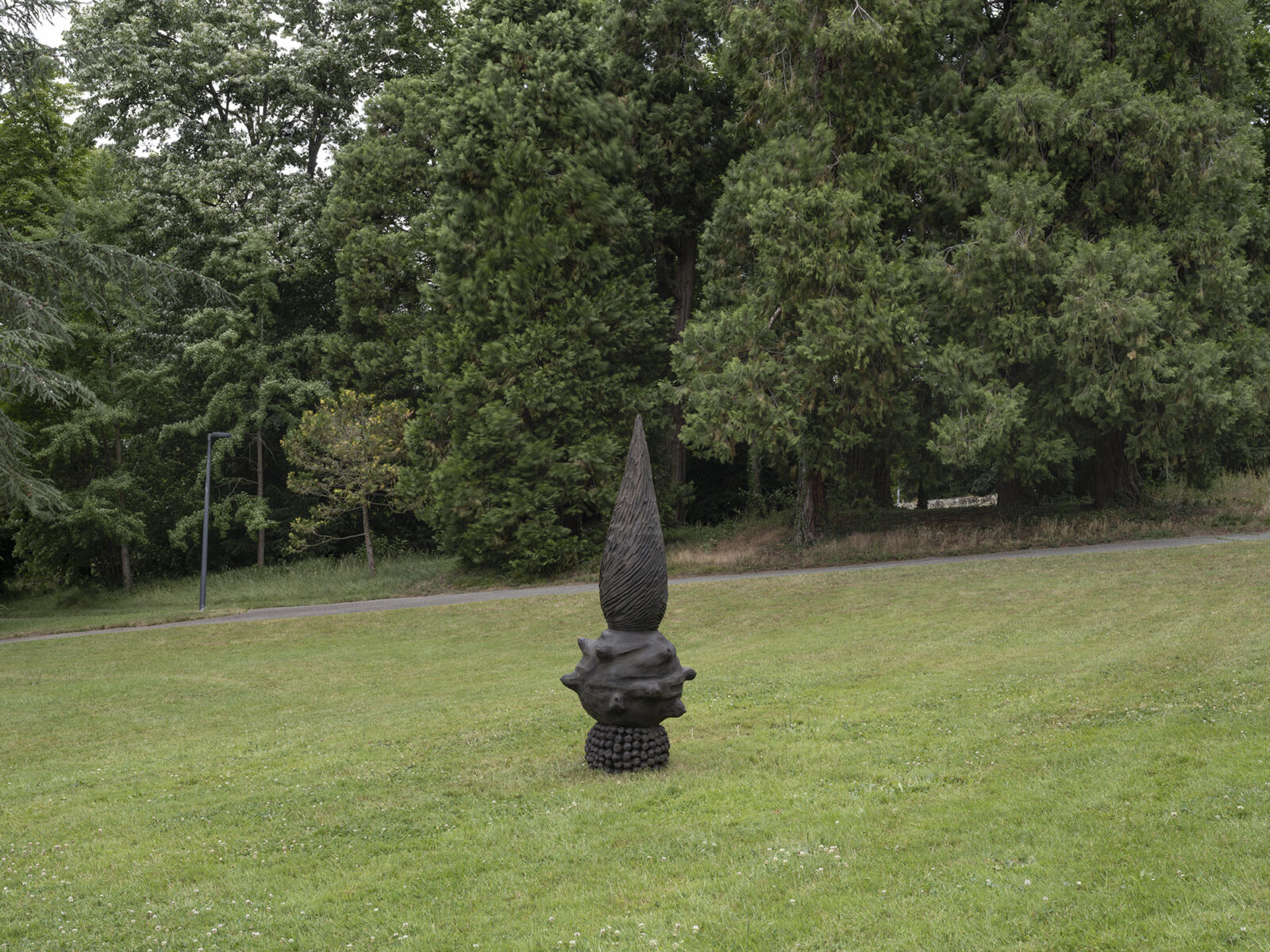
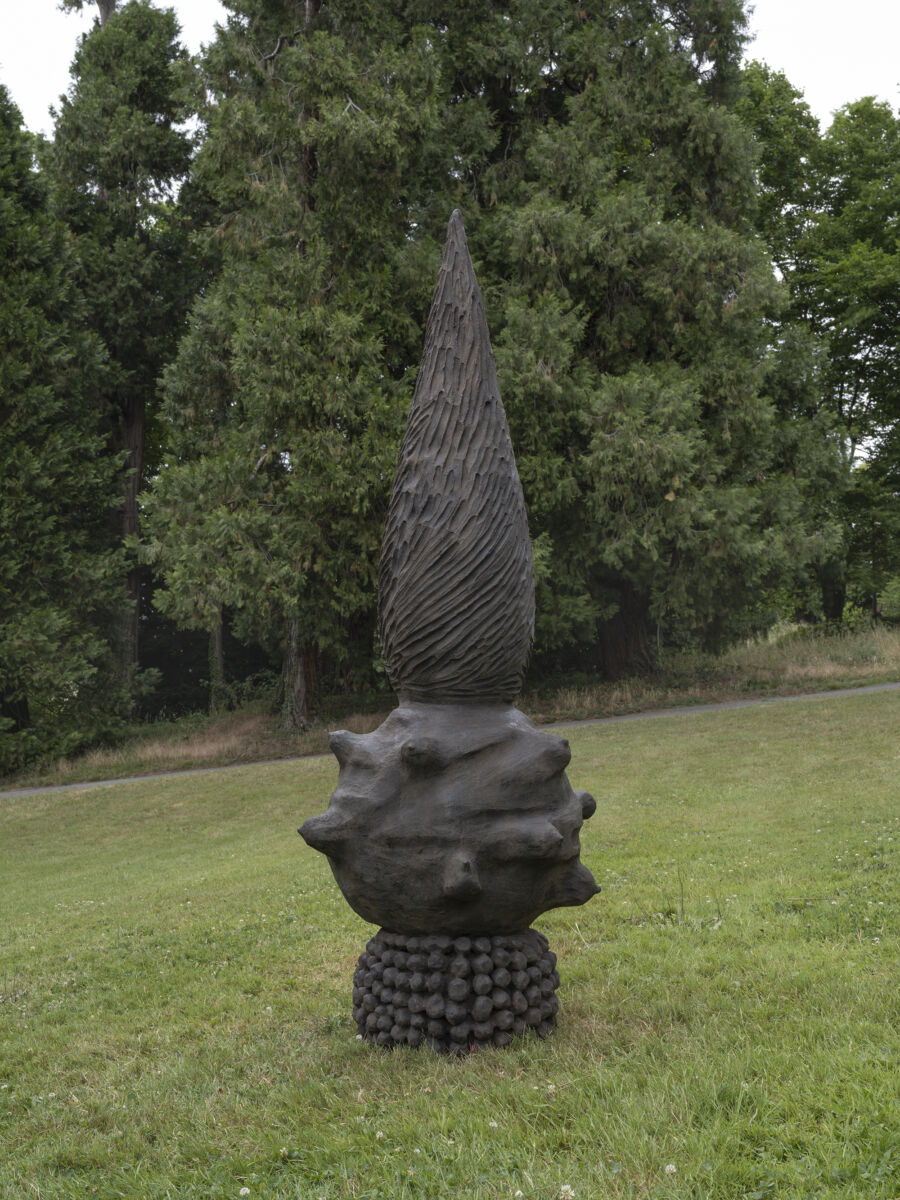
Special Projects
vorstellen.network
Feuilles Volantes
Feuilles Volantes are a single-page paper, printed in risography. In the course of the Biennale, eight pages are being published, at the rate of one page every other week. Those “Flying Leaves” are distributed according to the following designated calendar, in the parks and on the beach, thanks to a cargo-bicycle. The contents of each publication are drawn directly from the online platform vorstellen.network which allows the artists to share contents, through an open-source model inspired by Wikipedia. Behind this perspective hides an idea of art as conversation, to which the temporary form of a paper is given during the Biennale.
Distribution calendar, every other Saturday:
11.06, 25.06, 9.07, 23.07, 6.08, 20.08, 3.09, 17.09
Mobile device from 2 p.m. to 4 p.m and fixed meeting point from 4 to 4.30 p.m (No. 25, see map). For the online version use the QR code
on the right-hand page.
Contents: Operators/vorstellen.network
Artistic direction: Axelle Stiefel
Associate collaborator: Elisa Storelli
Developer: Philipp Klein
Graphic Design: Salome Schmuki
Printing: Matteo Dufour
Newsletter: Laura-Issé Tusevo
Accessory: Benjamin Mengistu Navet
Concept: Elisa Storelli, Philipp Klein, Axelle Stiefel
Subsidised by the City of Geneva
With the support of FCAC Genève, DCS et Pro Helvetia, Fondation suisse pour la culture
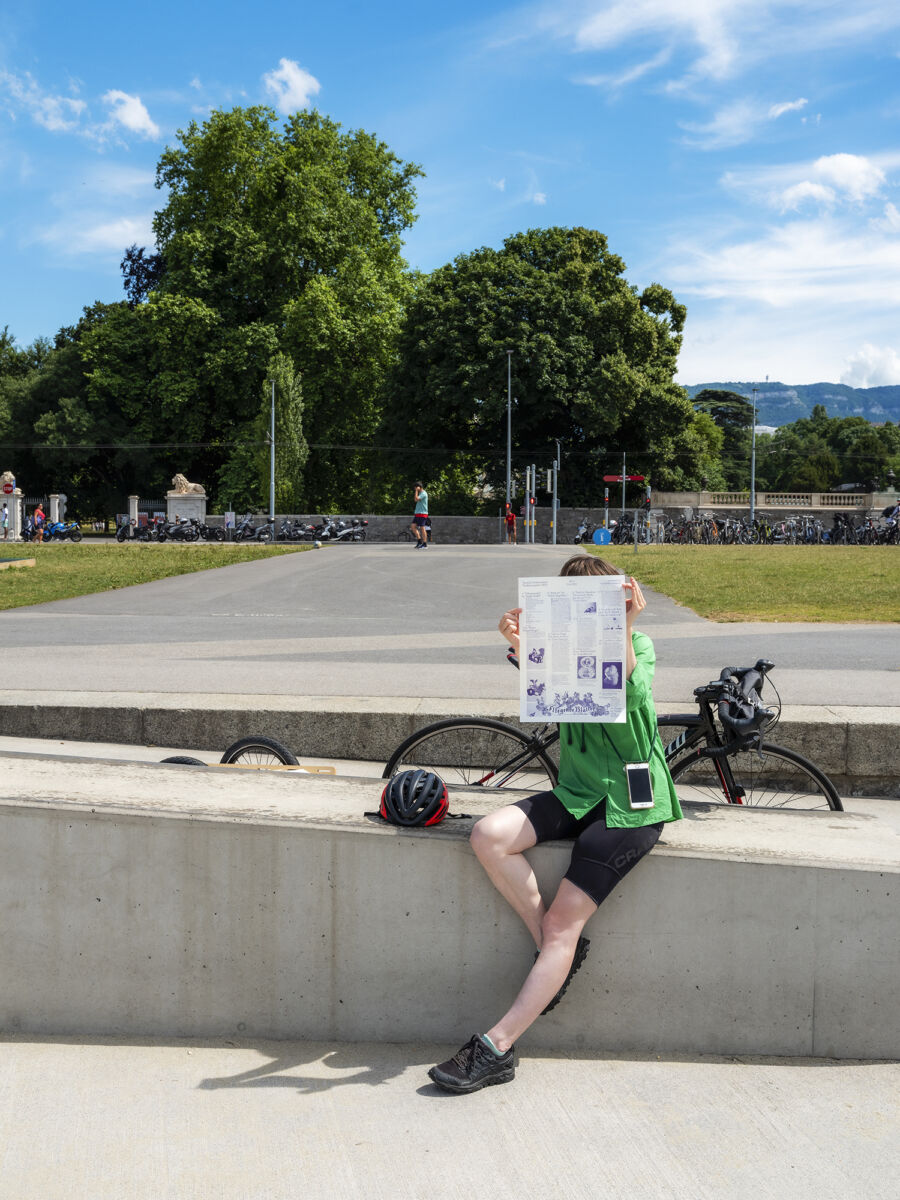
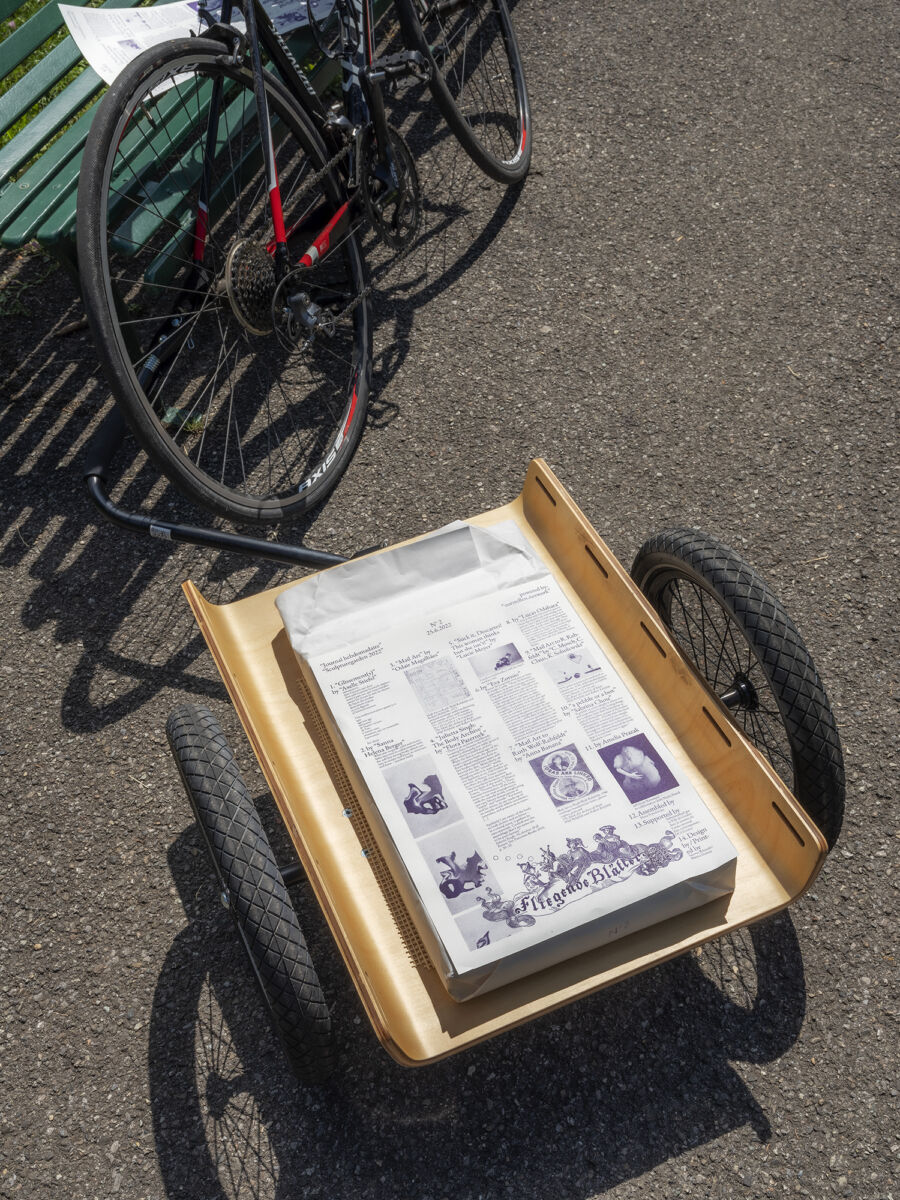
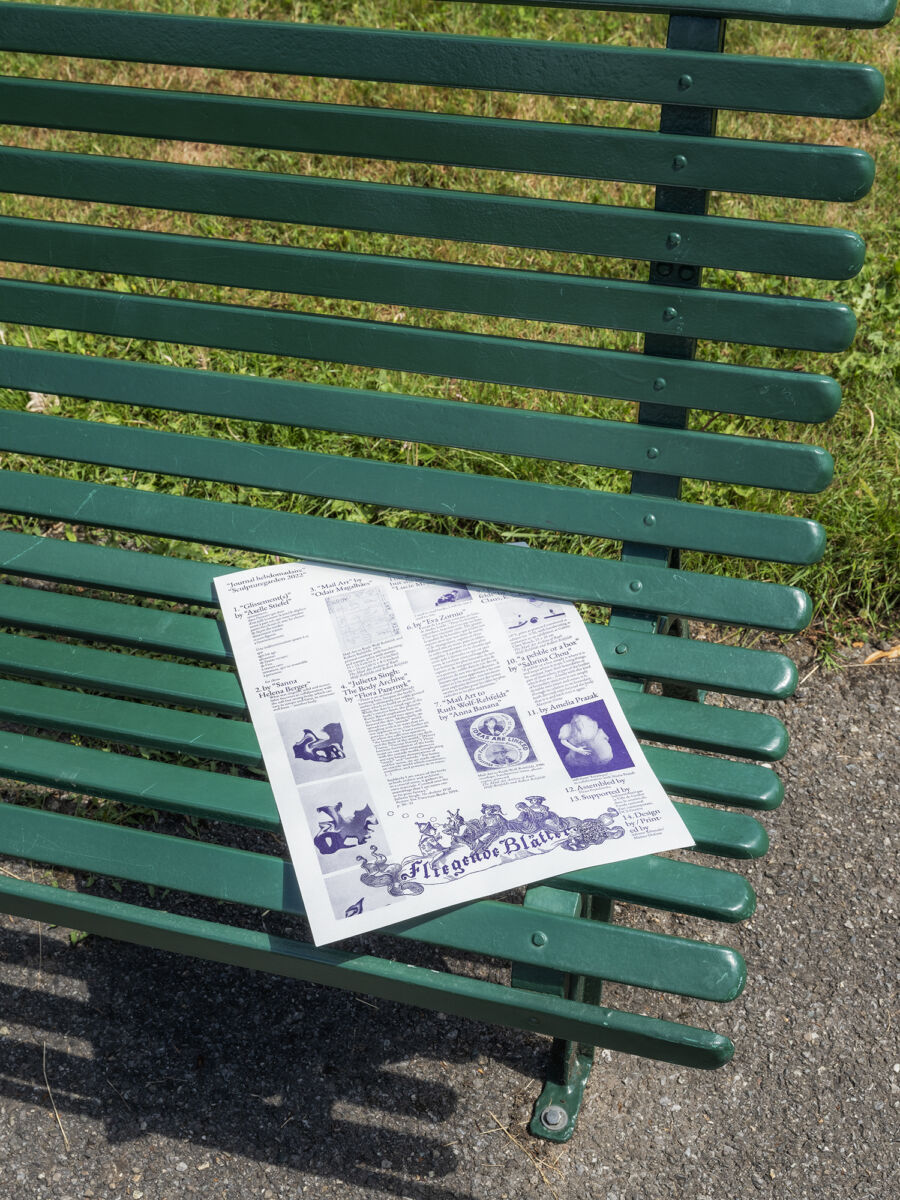
Simon Berger, presented by Bulgari (Île Rousseau)
(*1976, CH)
Morphogenesis, 2022
Glass, silicone, transport wagon, plastic strips
200 × 180 × 80 cm
Contemporary glass artist Simon Berger’s unique sculptural language explores the depth of his material through striking and cracking the glass he works on with a hammer. The pane of glass is both the supportive structure of his artwork, as well as the visualization of his artistic handwriting, playing with transparency of the material. The closer and briefer the blows, the stronger the contrasts and the shades. In his hands, the hammer is not a tool of destruction, but rather an amplifier of effects. Berger began his artistic explorations by painting portraits with spray cans before turning to other mediums. A carpenter by training, his natural attraction to wood inspired his first artistic creations within his studio. A lover of mechanics, he also spent plenty of time working with used car bodies to create assemblages. It was while pondering what to do with a car windshield that his idea for working with glass was born. “Human faces have always fascinated me”, explained Simon. “On safety glass, these motifs come into their own and magically attract the viewer. It is a process of discovery from abstract fogging to figurative perception.”

Work.Master students of HEAD–Geneva
Mbaye Diop (*1981, SN), Nicolas Ponce (*1998, CH), Alpha Sy (*1992, SN) and Yul Tomatala (*1993, CH) avec l’intervenante Sonia Kacem (*1985, CH/TN)
Rhodos_Azalées, NL, 2022
Stainless steel
500 × 150 cm
This collective work created by a group of students of the Work.Master of HEAD – Geneva takes the form of a weather vane. The sculpture is the result of a research around different layers of stories and narratives related to the park. Among these, the students have singled out the collection of rhododendrons offered in 1947 by the Netherlands, eager to express their gratitude to the City of Geneva for its humanitarian aid during the Second World War. Over the years, the rhododendrons have blended into the park’s vegetation and gradually disappeared. The upper part of the weathervane reproduces a historical map showing the original location of the rhododendrons. Although it doesn’t point out any legible direction for the passerby, the sculptural weathervane functions as a landmark that indicates the invisible force of the wind. The work is presented in the usual location of a mobile sculpture by Alexandre Calder currently under restoration and therefore also missing.
Co-production avec with HEAD – Genève
